Slam dunk
Local star aims for America’s NBA

Crime in HB The facts … what to do Moving past cyclone Councils getting ‘normal’ stuff done 2023 SEPTEMBER +OCTOBER 72 9 772253 262016 05 Sep/Oct $ 10.00 INC. GST
Ben Pearce Sculptor extraordinaire


Relax and revitalise at Ocean Spa, Napier’s premier heated pool and fitness complex.
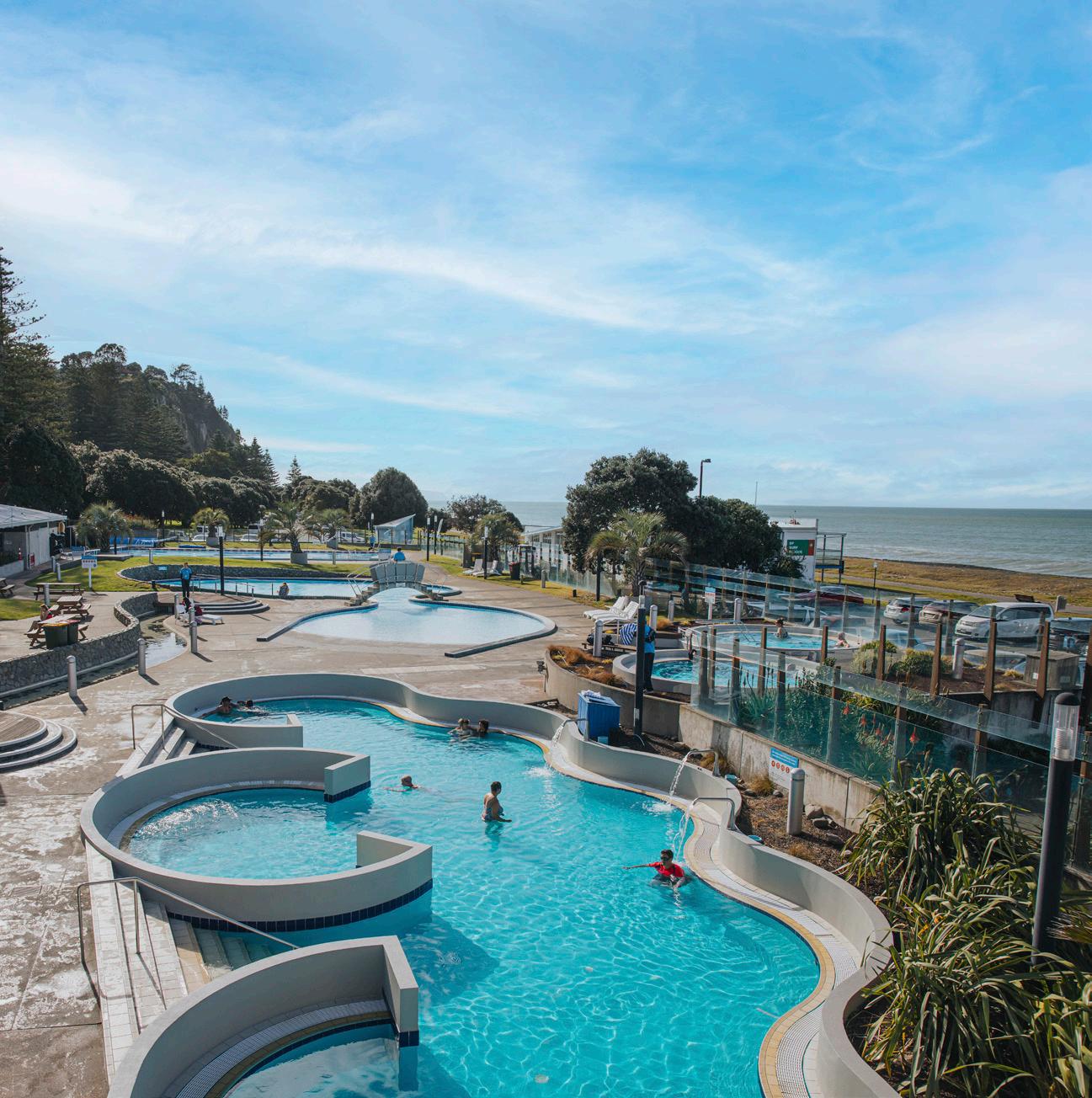
Open 7 Days | Marine Parade, Napier
oceanspanapier.co.nz
72
BayBuzz

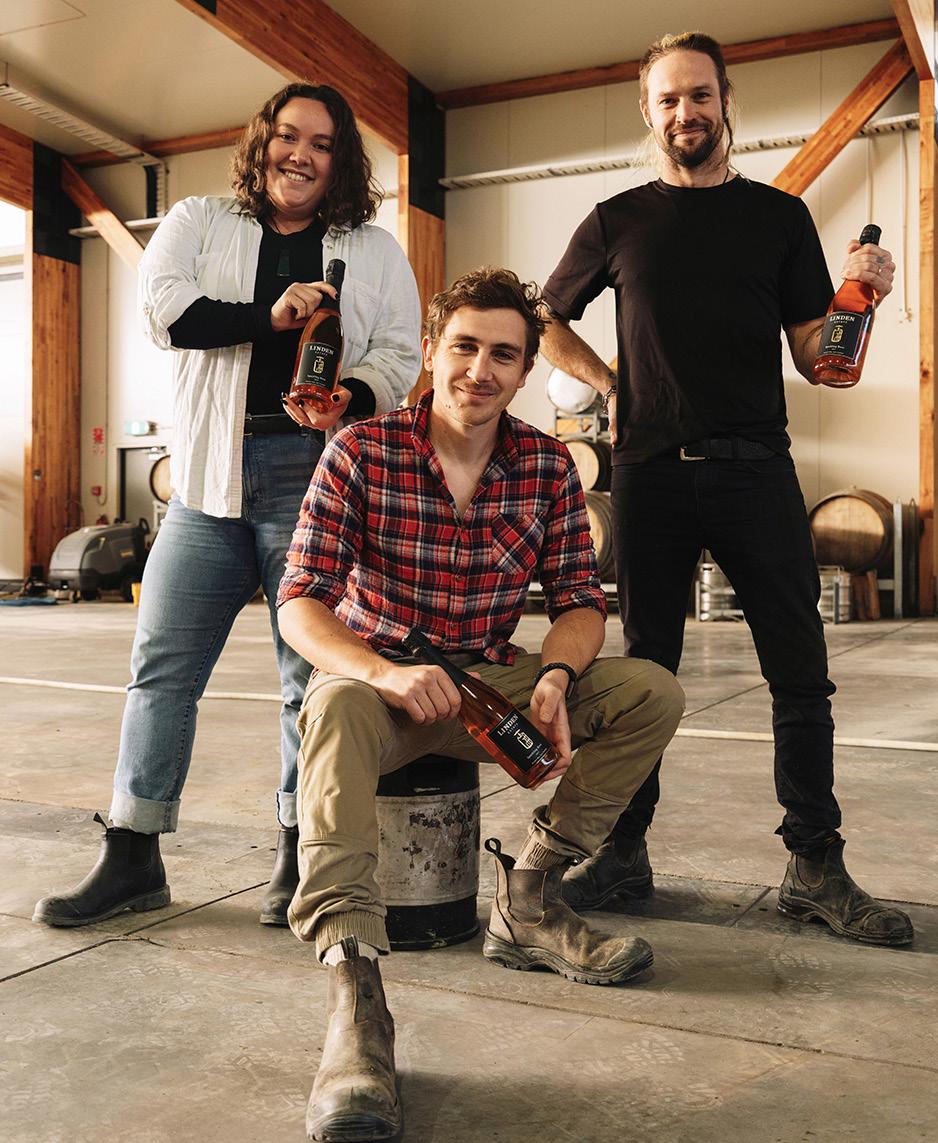
September + October 2023
Facts about HB crime. Political parties address farmers & climate change. HB getting back to BAU? Or full cyclone impacts yet to hit? Creating value from waste. HB basketball star. Now embraces culture change. $30m home business. Election & financial markets. Regional transport requires radical re-think. Arts Festival building bridges. Meet sculptor Ben Pearce. Breathe well! Spring bubbles, spring veggies ... and spring cleaning.
Follow us at: baybuzzhb
Articles online at: baybuzz.co.nz
Editorial enquiries editors@baybuzz.co.nz
Advertising enquiries
Mandy Wilson 027 593 5575
mandy@baybuzz.co.nz
Reach BayBuzz by mail BayBuzz, PO Box 8322, Havelock North
About the cover
Clive local Kahu Treacher shooting for NBA stardom.

Damon Harvey reports on page 40.
BayBuzz team
EDITOR: Tom Belford
LIFE EDITOR: Michal McKay
SENIOR WRITERS: Tom Belford; Abby Beswick; Rosheen FitzGerald; Bonnie Flaws; Damon Harvey; Sahiban Hyde; Michal McKay; Tess Redgrave; Mark Sweet
COLUMNISTS: Andrew Frame; Fiona Fraser; Yvonne Lorkin; Kate McLeay; Paul Paynter; Lizzie Russell; Dominic Salmon; Jess Soutar Barron; Ian Thomas
BUSINESS WRITER: Brenda Newth
VIDEOGRAPHER: Patrick O'Sullivan
EDITOR’S RIGHT HAND: Brooks Belford
PHOTOGRAPHY: Florence Charvin
ILLUSTRATION: Ruth Mitchener; Brett Monteith
DESIGN: Unit Design - Max Parkes; Giselle Reid
PRODUCTION MANAGER: Giselle Reid
PROOFREADER: Jenny Elliott
ONLINE: Elizabeth-Marie Nes; Lee Tong
BUSINESS MANAGER: Steph Lowry
PRINTING: Blue Star Group
ISSN 2253-2625 (Print)
ISSN 2253-2633 (Online)
The Buzz
This document is printed on an environmentally responsible paper produced using Elemental Chlorine Free (ECF) pulp sourced from Sustainable & Legally Harvested Farmed Trees, and manufactured under the strict ISO14001 Environmental Management System.

Sahiban Hyde, reporter
I can fit everything about me in one easy to grasp sentence – ‘a no-nonsense, straight-up, armybrat with a penchant (allegedly) for troublemaking, and writing’. I have been a journalist for nearly a decade on and off. The in-between times were spent with me trying my hand at personal training, and training to be an officer in the NZ Army.
But it has always been writing that I keep coming back to, like a very annoying boomerang.
There are always two or more sides to every story and over the years people have put their trust in me to tell their side, and tell it true, and tell it well. And that’s something I intend to continue long after I lose my other senses and I am a grumpy old git pottering around mumbling to myself about the state of affairs these days.
BayBuzz readers can see Sahiban's stories online now and in our next print issue.
40 Shooting for the NBA
Damon Harvey
Local star heads for America’s NBA.
BayBiz
47 Now’s cultural evolution
Brenda Newth
Relationship-based company learning from Māori approach.

54 Mean, beany machine
Fiona Fraser
Beany, a global virtual accounting firm based in Havelock North.
58 Will the election impact NZ’s financial markets?
John Norling
Here’s an assessment from Jarden.
Ideas + opinion
60 Sustainability can’t be a political football
Dominic Salmon
Building climate resilience can’t be kicked down the road.
62 Meet Jim, soon retired
Paul Paynter
For cyclone-affected farmers & growers, worst is still ahead.
the
8 BayBuzz celebrates Pipi Truck 9 The Buzz Lizzie Russell + Rosheen FitzGerald Features
True crime Abby Beswick Politics aside, what’s HB’s real crime situation?
Moving past the cyclone Tom Belford Recovery still priority, but councils moving on. 28 ‘Good for the farmer, good for the planet’ Tess Redgrave Our farmers face market demand for emissions reduction. 34 Waste-to-energy: HB’s organic gold? Bonnie Flaws Organic waste creates economic opportunity ... will HB seize it?
6 From
editor
16
22
Featured Contributor 4 BAYBUZZ September + October 2023
64
Transport is not all roads and cars.
Life
70 Building bridges –ki te hanga piriti
Michal McKay
Major effort to infuse Arts Festival with cultural diversity.
76 Listen up, readers ... Lizzie Russell
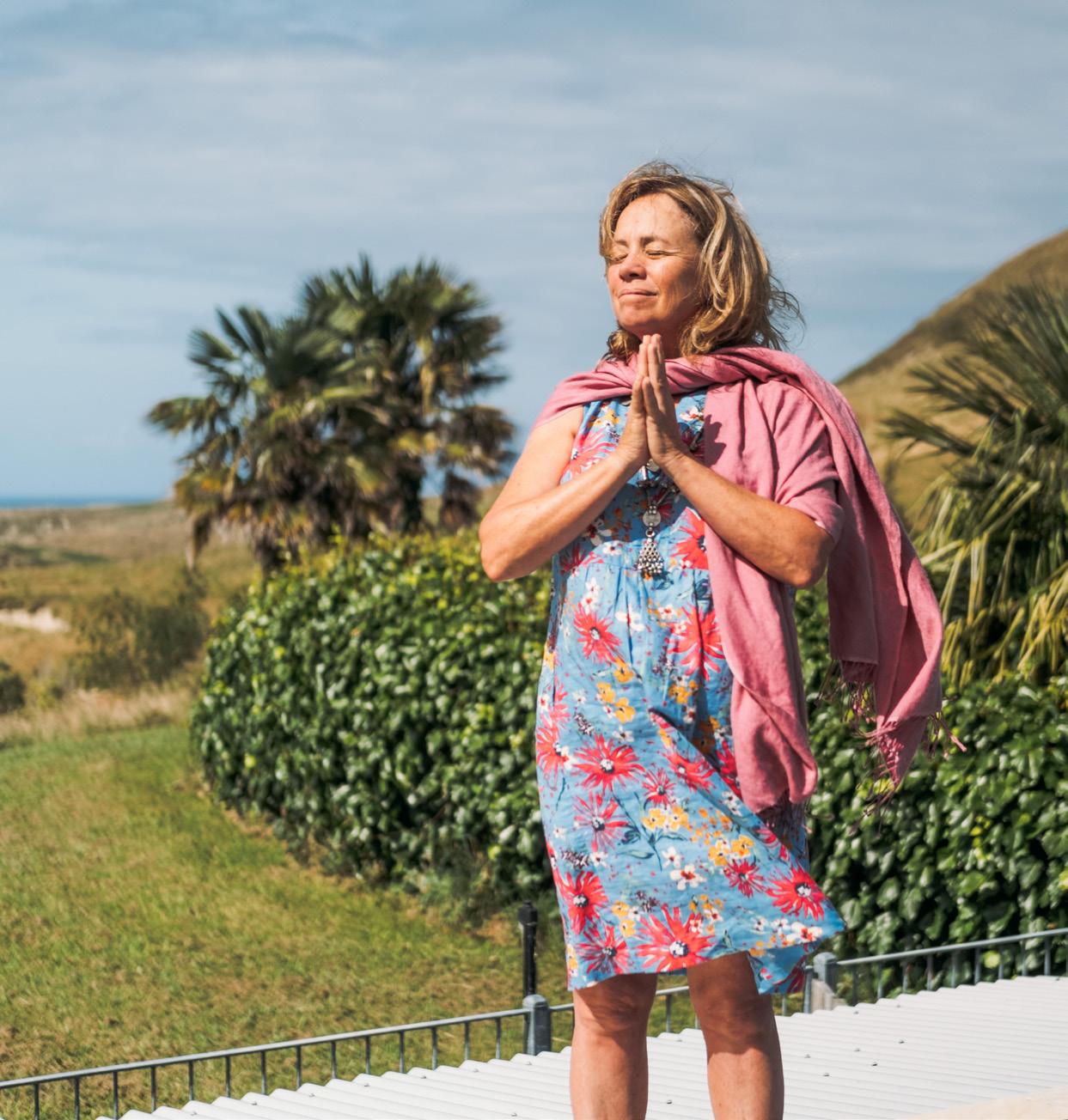
Meet writing talent at the Readers & Writers Festival.
78 Artist Ben Pearce, enabled by ARA Trust Rosheen FitzGerald
Local sculptor benefits from grant award.
83 Breathe your best Kate McLeay
Breathing properly yields benefits.
83 Breathe your best
86 A sparkling toast to spring
Yvonne Lorkin
Hawke’s Bay is producing excellent sparkling wine.
90 Spring?
Ian Thomas
Tougher to mark Spring on the calendar, but veggies still arrive.
96 Clean machine
Jess Soutar Barron
Meeting the challenge of spring cleaning.
Gabrielle’s warning –time to get radical Martin Williams
All photos Florence Charvin
September + October 2023 BAYBUZZ 5
This edition of BayBuzz spans most of the national election window, and will still be read after the verdict of 15 October.
Our main ‘substantive’ articles try to furnish insight on a few national issues that have special relevance to Hawke’s Bay – crime, transportation, and the role of our farmers in addressing global warming.

Regarding crime, the most politically appealing default position is to stridently advocate jailing the bastards. It doesn’t really matter whether ‘crime’ is actually increasing in Hawke’s Bay, if you say it is enough, it must be. Hands down, National and ACT have the default position locked up. Forget about the underlying social issues and the universal data on the futility of draconian measures. Abby Beswick looks into these issues in her True Crime article.
On regional transportation, the political equivalent of ‘jail the bastards’ is ‘four-lane the Expressway’. But likewise, as Martin Williams discusses in Time to get radical, HB’s transport issues are more complex and require a more holistic, nuanced approach.
With respect to farmers needing to address climate change, Tess Redgrave’s article – ‘Good for the farmer, good for the planet’ – sums up the reality of the situation. She writes,
“Farmers and growers can respond to market expectations regarding emissions reductions or whinge about government regulators, but either way our farming practices will need to change ... quickly.”
The smartest leaders in NZ farming get this, because they have a global view of the marketplace in which we
From the editor Tom Belford

must compete. And the smartest farmers get it, as across New Zealand they are showing that they can reduce their environmental footprint and become more profitable at the same time. National and ACT seem oblivious to this reality and its positive potential. Labour seems aware, but as a party is acting too timidly. Only the Greens are nailing this issue and setting out a resilient future path.
Regarding the pace of addressing climate change, timidity rules. The Greens want to lead (and see that as both morally and pragmatically urgent). Labour’s a cautious fast follower. National prefers slow motion (mark time until technology comes to the rescue with painless solutions). ACT lives on another cooling planet.
Regardless of one’s views on issues, one has to agree that at least the Greens, ACT and Winston speak from conviction. They have a worldview and advocate unabashedly for it. National and Labour are racing to a vague bottom. One pundit has said the Labour Party is actually just the National Party with Chris Hipkins as leader.
National audaciously claiming it can best fix our decaying health system after denuding it during its previous tenure. Saving the nation from potholes after freezing road maintenance spending. Dusting off social and educational policies that have failed already here and abroad. Implying that every needy problem that Labour has ‘ignored’ or ‘stuffed up’ will soon be rescued by National, but without a funding plan or suitable tax base. If that’s what “Getting our country back
on track” means ... no thanks.
Labour for its part squandered any claim on the moral high ground by substituting a comically trivial fruit & veggie GST cut for meaningful tax equity reform. If Labour has indeed delivered material benefit to teachers, frontline health personnel, and budget-pinched, middle-class wage-earners, it has failed to communicate that. “In it for you” ... show us how, where, when.
And then there’s the matter of National guaranteeing MP seats to Katie Nimon and Catherine Wedd via high list rankings, appealing gender balancing, but neither with any appreciable history of public service. For them, the democratic process ended in mid-August and bag-packing began. Wouldn’t it be nice to have one experienced MP for our region, with a proven record of busting their chops for the betterment of our region? That would be Anna Lorck. Remember, voters, you do get two ticks.
In our last edition, columnist Paul Paynter urged readers to vote for minor parties. There’s integrity to voting your convictions, especially this year. Labour’s chances of governing again will not be diminished by mass defection to the Greens. Similarly National’s chances of governing will not be diminished by mass defection to ACT.
But in both scenarios, hugely important signals will be sent about the kind of New Zealand we wish to become.
6 BAYBUZZ September + October 2023
BayBuzz is subject to the New Zealand Media Council. Complaints to be first directed in writing, within one month of publication, to editors@baybuzz.co.nz. If unsatisfied, the complaint may be pursued with the Media Council at: info@mediacouncil.org.nz. Further detail and complaints form are available at
www.mediacouncil.org.nz.
Thanks to our BayBuzz Sponsors

Sponsors commit


Our Foundation Sponsors provide year-long support to our magazine and online service, helping to ensure BayBuzz can deliver quality journalism to Hawke’s Bay readers, connecting and informing our community.
BayBuzz commits





With that support, at a time when local journalism has never been more important, we commit to bringing Hawke’s Bay in print and online:
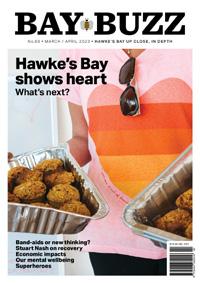

• The most in-depth insight into the major environmental, economic and social issues challenging the region.
• The most comprehensive window into our region’s arts and culture and community achievements.
• The most provocative and inspiring views and opinions on where Hawke’s Bay should head and why.

Not receiving our free weekly e-newsbrief, The Buzz? Simply visit www.baybuzz.co.nz and register your email. baybuzz.co.nz facebook.com/baybuzzhb
BayBuzz Celebrates
Pipi Truck
Congratulations to Alexandra, Chris and their team! Their fabulous pink Pipi Truck was recently crowned Food Truck of the Year at the 2023 New Zealand Wedding Industry Annual Awards. Here’s to a terrific spring and summer ahead – peppered with pizza-filled events and delicious al fresco dinners!
 Photo: Florence Charvin
Photo: Florence Charvin
WALK OF WONDERS
The Havelock hills are about to become a little more magical this spring. Now in its third incarnation, Walk of Wonders: The Return Journey, takes over the extensive Black Barn property for two Thursday to Sunday weekends in September.
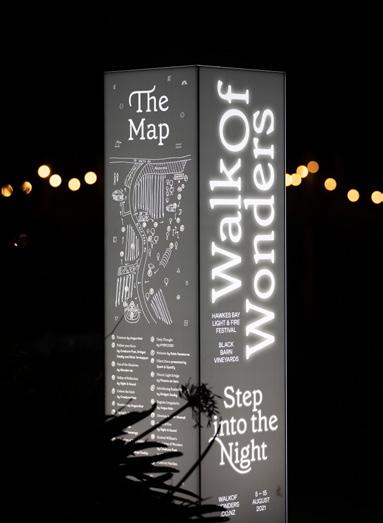
An immersive experience of light and fire, the festival is designed to ignite the imagination and delight the senses. Guests embark on an easy 2 km loop through woods and vines, over gentle hills and into underground caverns. Each nook and cranny and expansive space is transformed into a land of fantasy by an abundance of light installations to enchant the most jaded of eyes.
The audience is drawn into the speculative world of wonder via a puppet show, commissioned especially for the festival. This articulates
the high fantasy premise on which the experience is based, fertile fodder for the creative imagination. Many of the installations display astounding feats of technology, giving us a glimpse into the future. But there is an earthy realness too. The natural setting, the abundant roaring fires, the handmade puppets, the rare joy of being outside in the night time, all give the audience an opportunity to be in the moment.
The experience is deepened by an original ambient score, composed by Tom Pierard, live performers and an engaging story weaving each vignette into a cohesive adventure for young and old alike. The market space is filled with a variety of food stalls and hot drinks and Black Barn wine is available at various locations along the way.
The festival is the brainchild of Ant Van Dorsten, the artistic mind behind Vesica Aotearoa. He’s responsible for creating wonderful installations in pub-

lic spaces across the country. If you’ve been surprised and delighted by giant inflatable mushrooms, a rainbow tunnel or a fountain filled with glowing orbs whilst wandering around town, chances are Vesica has made it happen.

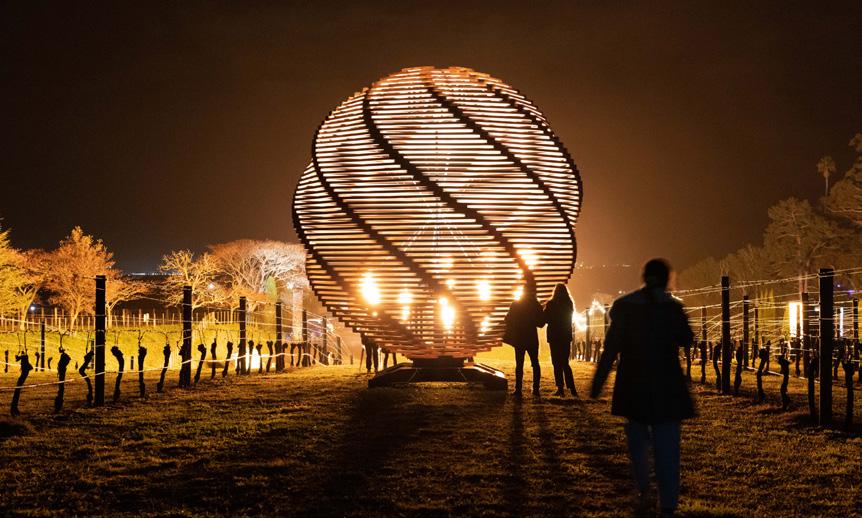
Walk of Wonders brings together many of these pieces, with more created and constructed especially for the festival. Artists such as Fish Aberadi, Angus Muir and Phoenix de Vere will feature amongst others.
Live Night, on Saturday September 23rd, adds an extra element to the festival. A diverse range of performers intersperse the interactive art works, enlivening the space with music, theatre and dance and other whimsical surprises til 10.30pm closing time. The headline act, Wellington three piece, Kita, is worth the entry fee alone.
Walk of Wonders runs from 14-17 and 21-24 September at Black Barn Vineyards
The Buzz Rosheen FitzGerald
Photos: Hazel Redmond
The Buzz
Lizzie Russell
DAY OUT
In this news series, we cast a little BayBuzz light on local treasures – spots you might need reminding about, places to explore in our own resilient, beautiful backyard. We start in the Esk Valley.
It’s been a massive team effort, to get back on their feet, Linden Estate’s Olivia Walding-Karaitiana explains. And they are very nearly there.
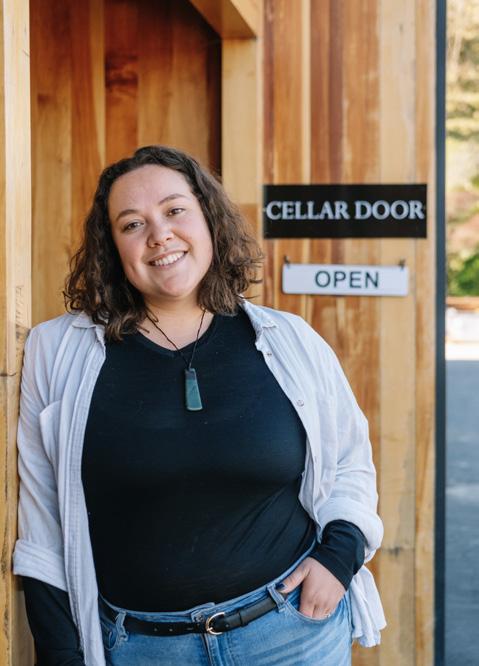
Labour Weekend will mark a new beginning for many businesses in Hawke’s Bay. The arrival of a new visitor season, the end of the long post-cyclone winter. For Linden Estate, it’s time to reopen after eight challenging months.
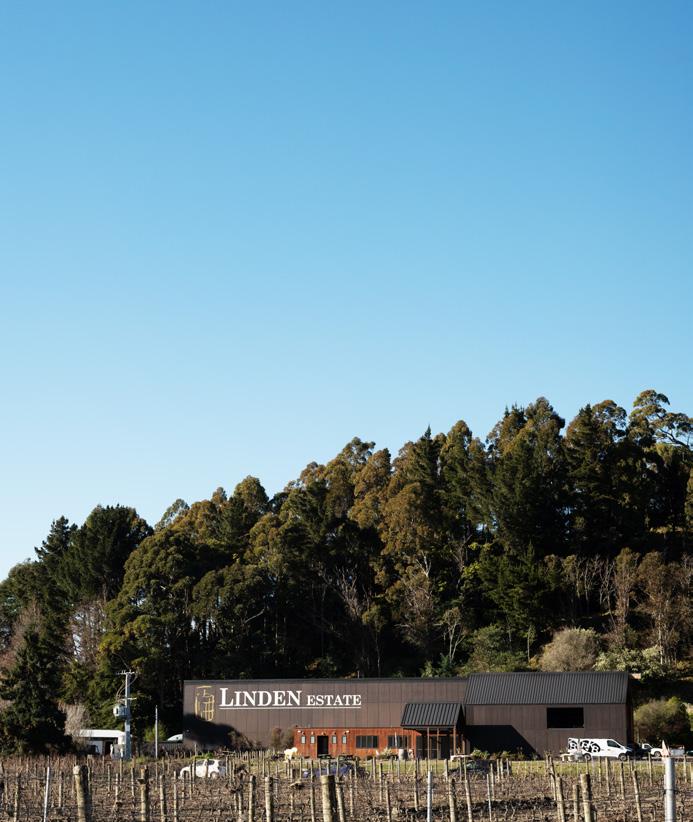
They’ll fling open the doors Saturday, Sunday and Monday from 10am till 4pm, with food and music, festivity, a “we’ve made it” energy. It’ll be a time for visitors to return and for the local community to come together and celebrate.
“It’ll be a celebration of how far we’ve come,” Olivia says. Months of digging

vines out of silt by hand, cleaning bottles, repairing, re-planning, re-routing. She points out the huge group endeavour that’s gone into getting the winery and vineyard back up on its feet The core team of three (pictured), the “best owner you could hope for” Bruce Jans, Phil Barber supervising the vineyard, Chris and Gen who’ve been there for it all, and of course, the volunteers. “People came for an afternoon, and we were so grateful for that, and people have come weekly since it happened.”
They were devastated, but not defeated out here in the Esk Valley. Bring on the spring and summer.
Photos by Florence Charvin
10 BAYBUZZ September + October 2023
OPPOSITE: Linden Estate business manager Olivia Walding-Karaitiana, Toby Priestley (cellar, vineyard and jack-of-all-trades) and winemaker Alex Hendry.

The Buzz
Lizzie Russell
Top ten signs of Spring
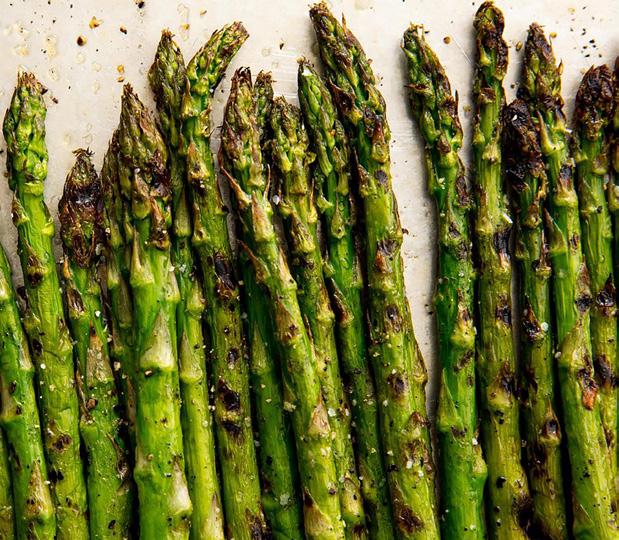

An afternoon walk on Westshore or Ocean or Waimārama Beach leading to a sane and realistic conversation about having a dip.
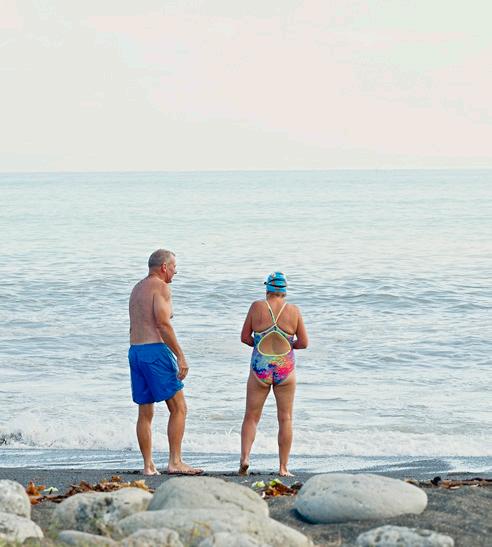
The days beginning to stretch, so that now-familiar regional traffic crawl at the end of the day has more daylight to it.
6 2 3
The mornings are frosty and we’re still keeping coats handy, but things ARE beginning to thaw, both metaphorically and meteorologically. Keep an eye out for the following certain signs of spring in the Bay over the next month or so: 4

1
The car being covered in pollen.

Central Hawke’s Bay’s annual Spring Fling. Head to thespringfling.co.nz for all the fun, frolicky events on offer throughout September and October.

5 9
Goosebumps because you stripped down a layer in the brief mid-afternoon warmth, and now you have to back your decision.
 The promotion and preparation of the Hawke’s Bay Arts Festival. See Michal McKay’s article on the highlights on page 70. Check out hbaf.co.nz for all the details and to book tickets to events.
Asparagus showing up on menus and tables!
The promotion and preparation of the Hawke’s Bay Arts Festival. See Michal McKay’s article on the highlights on page 70. Check out hbaf.co.nz for all the details and to book tickets to events.
Asparagus showing up on menus and tables!
Lamb-spotting on your way to visit the yellow sea of daffodils at Taniwha, just south of Waipukurau. This year Taniwha Daffodils is open from September 2-17. See taniwhadaffodils.co.nz for details.

Happily taking an outdoor table for that end-of-week drink at Matisse (under the twinkly lights!).
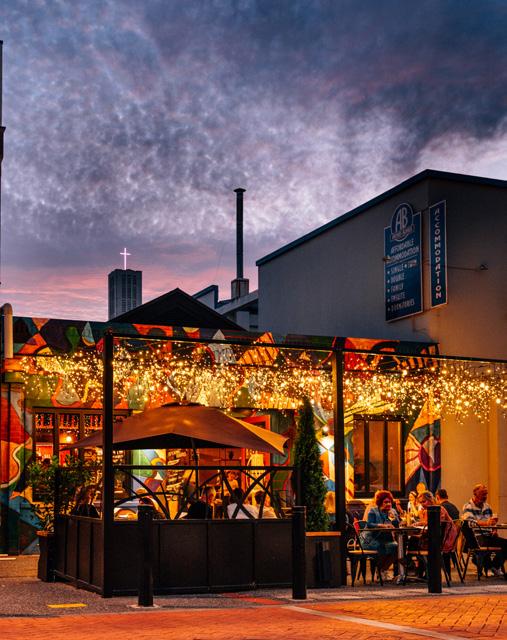
7 8
At Hearing & Balance we are proudly locally owned and independent.

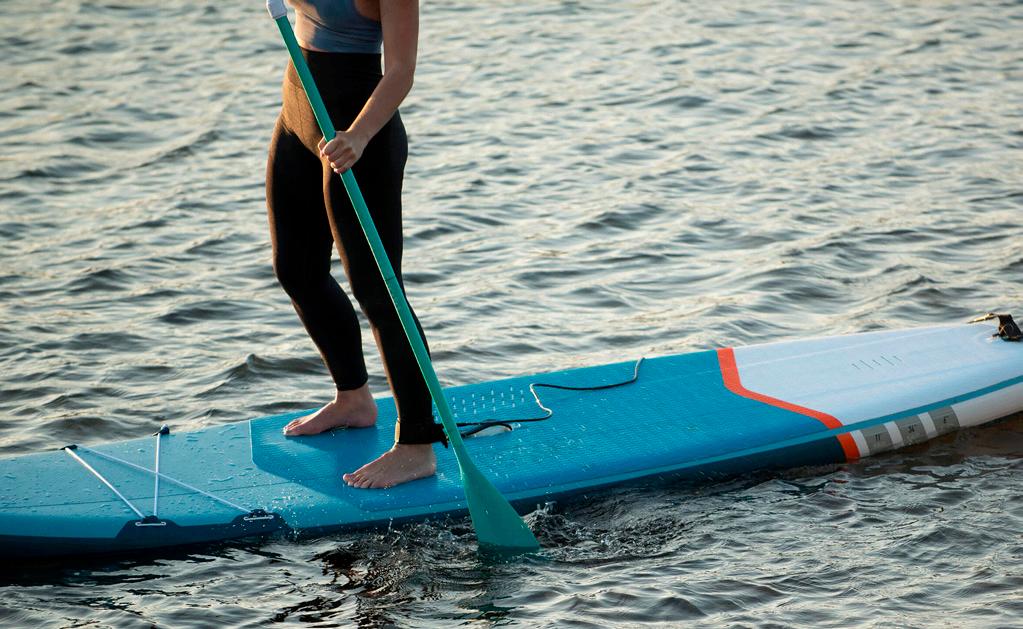

We know that there is no one solution that works for everyone.
Our clinic has access to a full range of hearing aid brands so we can find the solution that’s right for your hearing issues, funding status and budget.
No matter what your hearing problem is we can help support you on a path to improved hearing.

Our other specialist audiology services include tinnitus management, balance assessments, paediatric hearing tests and assessemnts for auditory processing disorder (APD), hearing protection and swim/sleep plugs.
We welcome even the most reluctant of people to make an appointment with us and discover the positive difference that hearing well can make to your life and overall health.
We are your local audiology experts who believe that everyone deserves to hear.
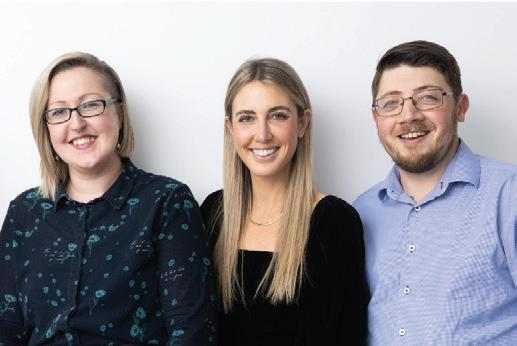
hearingandbalance.co.nz
September + October 2023 BAYBUZZ 13
06 833 6312
admin@hearingandbalance.co.nz 4a Avenue Road Greenmeadows Napier 4112










TRUE CRIME?
Frequent ram raids, violent attacks on business owners, mindless vandalism and smashand-grab teens wreaking havoc on communities. Based on the headlines, you’d be forgiven for thinking crime has spiraled to shocking new levels. But is this true?
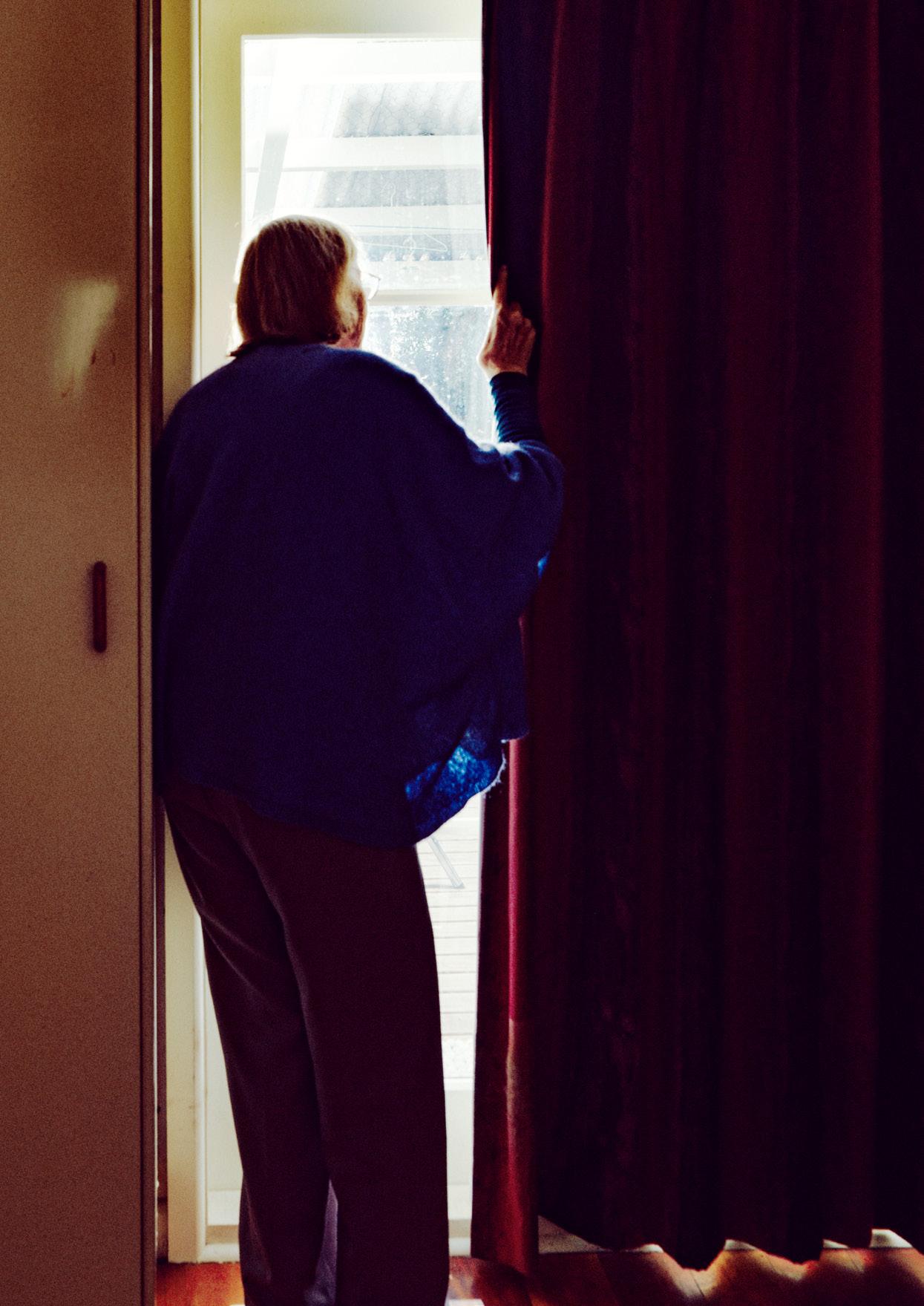 Story by Abby Beswick Photos Florence Charvin
Story by Abby Beswick Photos Florence Charvin
How bad is crime in our region really, and what’s the best approach for creating meaningful change? We look into the statistics, compare political party policies, speak to experts and ask affected locals for their thoughts on crime in Hawke’s Bay
“While national crime figures have increased, in Hawke’s Bay total crime has remained much lower than the national average and is currently trending down.”
The numbers
How safe do you feel? Statistics show Kiwis feel less safe today than they did a year ago.
Yet, while we feel more concerned about being the victim of a crime, we’re less likely to report it. The latest New Zealand Crime and Victims Survey reveals just 69% of Kiwis have high trust and confidence in police – down 5% on the previous year. According to the survey, the level of crime going unreported has now jumped to 81%.
Perhaps people feel police simply won’t be able to respond quickly when they need them. Police undoubtedly are feeling increased pressure on staff and resources. Nationally, demand for police services has increased by 35% over the past 10 years.
Frontline police are working incredibly hard to keep Kiwis safe, but that job is getting harder, says Hawke’s Bay Area Commander Inspector Lincoln Sycamore. “Police continue to actively consider how to best balance and respond to competing demand pressures and we work closely with our partner agencies to help support the people and whānau involved.”
While national crime figures have increased, in Hawke’s Bay total crime has remained much lower than the national average and is currently trending down, says Sycamore.
Compared to last year, residential assault, non-residential assault, general violence and disorder, and
residential burglary have all decreased in the region, say police. There are specific areas of concern, however. Arguably most alarming is the increase in gang membership, with the number of people on the police gang register in the Eastern District rising from 801 in 2017, to 1367 in 2023 – an increase of 71%.
Retail and violent crime incidents have also increased in our region, with retail incidents increasing 41% between 2018 and 2022, and violent crime by 23% between 2017 and 2022. Like other parts of the country, Hawke’s Bay business owners are being impacted by ram raids, vandalism, burglaries and violence. Michael Hill Jeweller in Hastings has been ram raided so many times, they now have security guards on the doors. At nearby Cornwall Park Store, the terrified owner was left injured by a man who confronted him swinging an axe and demanding money. In Havelock North, the owner of The Milkbar has been forced to increase security after his shop was broken into and burgled by a group of youths. The list goes on.
“Gang membership across the Eastern District is among the highest per capita in New Zealand. The impact of gang violence and the presence of gangs has a huge impact on the community’s sense of safety and the availability of illicit drugs.”
Inspector Lincoln Sycamore
Hawke’s Bay Area Commander
Gangs, drugs, theft and family harm Gang membership across the Eastern District is among the highest per capita in New Zealand. The impact of gang violence and the presence of gangs has a huge impact on the community’s sense of safety and the availability of illicit drugs, says Sycamore. “We see more and more people who are habitual illicit drug users with negative mental health outcomes.”
Another challenge for police is they often need to spend lengthy periods dealing with people in crisis. Police are increasingly spending more time in people’s homes responding to family harm and mental health incidents, which can impact their ability to deliver other services, says Sycamore. A number of agencies work with police to support vulnerable people in our community and make a difference.
“A silver lining of these challenges is that many solutions for intergenerational issues that often predicate instances of family harm have come from our community.”
Hawke’s Bay has also seen an increase in vehicle theft, which reflects the trend across NZ. Our rate across the Eastern District is approximately 20% higher than this time last year, however we are well below the national average for this type of crime. Vehicle crimes are predominantly committed by young people, who say they’re ‘bored’ or ‘doing it because their mates are’, says Sycamore.
The cyclone has brought additional problems to the region. As recovery work continues, people have been taking advantage of affected citizens and businesses in the form of theft and burglary.
September + October 2023 BAYBUZZ 17
POLITICAL VIEWS
Law and order has been a hot topic for this general election, but will political parties make meaningful change or are they simply planning to put more people behind bars for longer at a bigger public cost? Both Labour and National have committed to funding more rehabilitation for remand prisoners, but what else do they have to offer?
Labour
Labour MP for Tukituki, Anna Lorck, says the government is focused on prevention, protection and accountability when it comes to crime. The party’s changes to date include increasing police numbers and investing in their training and legislative tools. In the Eastern District, the government has increased police numbers by 20%, with another 105 officers as part of delivering on its promise for 1800 more officers nationwide, says Lorck.
Labour plans to continue to crack down on crime by increasing accountability for offenders, giving police more tools and programmes to break the cycle of crime. It also plans to strengthen the youth justice system to ensure offenders will be held accountable and will also receive the rehabilitation they need. As part of this, two new high needs units would be built and legislation introduced to make residences more secure.
Lorck says she’s been a long-time advocate of more community police presence to improve public safety in neighbourhoods and retail areas and to help people feel connected to the police. Many smaller places lost this important presence when National shut down local police stations and cut community cops, she says.
Lorck says feedback she’s had from residents, especially those in Havelock North and Clive is they’re seeing the long-term impact and repercussions of losing their community cop. “There is more work to do, and we have to address crime at both ends. I believe community policing plays an important role in that and public safety is an absolute priority,” says Lorck.
National
Party leaders say we need a tougher approach to offenders. If elected, National’s plans include:
• Introducing a Young Serious Offender (YSO) category to increase consequences for repeat offenders.
• Bootcamps to set serious young offenders on a more productive path.
• Giving police more tools to tackle gang activity by banning gang patches in public, issuing dispersal notices, and stopping gang members accessing guns. Being a gang member will also become an aggravating factor in sentencing.
• Imposing tougher sentences for criminals, introducing further rehabilitation measures for remand prisoners and more support for victims.
National candidate for Tukituki, Catherine Wedd, says locals are feeling scared and unsafe about crime and it’s time to toughen up on offenders. “Crime is becoming the norm and we can’t let our kids walk around freely anymore, like we used to when we were growing up. Business owners are living in fear each day as they don’t know what is coming next,” she says. Gang-fueled crime and looting of cyclone victims are just two areas of major concern in the region, says Wedd. “We need to get to the core of the crime and stop these gangs from intimidating and taking over our towns.” In Pakowhai, Wedd has spoken to a number of residents about their concerns over theft from vulnerable families since the cyclone. “Crime is very real on the ground for people, but the government continues to ignore pleas for a tougher approach. National will not,” she says.
“Both Labour and National have committed to funding more rehabilitation for remand prisoners before they get thrown behind bars with hardened criminals.”
ACT
ACT calls for swift and serious consequences for offending in our community. As part of this, the party plans to introduce a new policy of Gang Control Orders to crack down on gang members and minimise risk to the public, according to a policy statement. The Orders would allow police to apply to the courts for an injunction against an individual on the national gang list. ACT would increase the power of the police to seize the assets of gang members found with illegal firearms.
Other plans include:
• Introducing an infringement notice offence for shoplifting, with instant punishments such as fines and community service.
• Introducing ankle bracelets for serious youth offenders.
• Reviewing the use of electronic monitoring sentencing for violent offenders.
• Reforming the reparations system so the Crown faces the burden of risk for slow reparation payments or non-payments, rather than the victims of crime.
• Reinstating Three Strikes – a sentencing regime that directs judges to sentence third-time serious offenders to the maximum sentence – to send a signal that New Zealanders won’t tolerate repeated violent and sexual offending.
• Building more prison beds to increase capacity.
• Prisoners will be required to complete skills or rehabilitation programmes to be considered for parole.
“Protecting the safety and property of its citizens is the government’s first and most important job. The rights of victims should trump the rights of criminals,” says the statement.
18 BAYBUZZ September + October 2023
WHERE TO FROM HERE?
Better rehabilitation programmes
Putting more people behind bars for longer does little to discourage offenders from future crime and comes at a huge financial cost. Instead, ensuring prisoners have access to meaningful rehabilitation and reintegration programmes can have a real effect on their chances of re-offending. These can range from drug and alcohol interventions, to motivational, parenting and money management programmes.

Both Labour and National have committed to funding more rehabilitation for remand prisoners before they get thrown behind bars with hardened criminals. Currently people on remand have limited access to programmes such as drug and alcohol treatment until they have been found guilty of a crime. A change in policy to include those on remand would be a chance for first-time offenders to make positive changes earlier.
In a further effort to boost this approach, Corrections Minister Kelvin Davis recently introduced a law change to further improve rehabilitation and reintegration outcomes for Māori, who are significantly over-represented in prison.
Better post-prison help Rehabilitation is a key aspect of crime reduction. Prisoners Aid and Rehabilitation Service Trust (PARS) is a support group that works to that end – providing information, court assistance and advocacy to ex-prisoners and their families.
When someone has finished their term of imprisonment, they have often
 LEFT: Catherine Wedd visiting Balkaran Singh, whose family own the Cornwall Park Store which was recently attacked. Photo supplied. BELOW: Anna Lorck has been a long-time advocate of more community police presence to improve public safety in neighbourhoods and retail areas.
LEFT: Catherine Wedd visiting Balkaran Singh, whose family own the Cornwall Park Store which was recently attacked. Photo supplied. BELOW: Anna Lorck has been a long-time advocate of more community police presence to improve public safety in neighbourhoods and retail areas.
September + October 2023 BAYBUZZ 19
lost everything, including their home, job, relationship, and connections with family, says PARS regional manager Adie Transom. “You come out of that punishment with a real sense of loss and loss of belonging – not quite knowing where you fit in the community. As well as that you’ve got the stigma of being a prisoner that you will carry for the rest of your life.”
As a result, clients continue to face consequences long after their punishment has ended. PARS Hawke’s Bay field worker Ruth Spicer has seen many clients struggle with a sense of isolation after release. Helping clients with practical day-to-day tasks such as obtaining a birth certificate, bank account, driver’s license and accommodation, as well as reconnecting with the community are fundamental parts of their work.
In NZ, more than a third of people who leave prison are back inside within two years. Getting back a sense of belonging is instrumental to reducing the risk of reoffending, say Transom and Spicer. To help clients reconnect with the community PARS runs two programmes: PARS Connect, where volunteers meet with clients to talk and listen, often at a cafe, their home or a community event, and PARS Men’s Group, a peer support group. Through the programmes, Spicer has seen clients grow in confidence, a positive outlook and sense of purpose. “I have observed that it is the most simple acts of showing kindness and caring that can make a difference.”
Removing barriers can also help reduce the risk of reoffending. “If you are cold, hungry, unsure where you will be resting your head, unsure of how to operate the phone to call
for support, then this is stressful and potentially a crisis point,” says Spicer. When prisoners are released, they are given a one-off Steps to Freedom payment of $350 – a sum that has not been increased in 30 years. It’s simply not enough for people who are often coming out with nothing and must start from scratch, says Transom.
There is no one answer for preventing reoffending; it’s complex and dependent on the individual’s situation. “But in short I believe to reduce the risk of offending, systems need to be refined, connections with the community are made available, and care and interest in each person is shown,” says Spicer.
Better prevention
While enforcement serves a purpose, it is not the only solution to reducing crime. Addressing crime requires society-wide, longer-term interventions that focus on the underlying causes of offending. This could include poverty reduction, education and housing.
Positive engagement with family, school, sport, and community provides young people with connections and also makes them less likely to commit offences. When it comes to gangs, early intervention is the best chance of breaking the cycle.

In Hawke’s Bay, police need a coordinated approach with agencies, communities, iwi, and social service providers to prevent family harm and youth crime, says Sycamore. These kinds of problems are complex and take time to change. “A lot of this is intergenerational, and you can’t change that overnight. The best advice is to look out for each other and care for your neighbours.”

“I believe to reduce the risk of offending, systems need to be refined, connections with the community are made available, and care and interest in each person is shown.”
Ruth Spicer
20 BAYBUZZ September + October 2023
Ruth Spice, PARS Hawke’s Bay field worker. Photo supplied.
W E L L N E S S P L A N S
Designed by vets to offer the best care for your pet
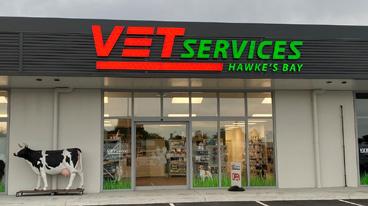
BURGLARY VICTIM WANTS OFFENDERS TO GET HELP EARLIER
Hastings resident Pam (changed name) has experienced crime firsthand. Aged in her late 70s, Pam has always been security conscious and felt safe in her home. So, she was shocked to be woken around 10am on a Sunday morning by a rock being thrown through her kitchen window.

A man had scaled the high fence at the back of her property and then broken her window to gain entry. “I was lucky that I didn’t wake up that fast,” she says. By the time Pam reached the kitchen, the offender had disappeared with her handbag. “I really didn’t know what to think.”
While there was little cash in her bag, the offender used Pam’s cards to make purchases at several dairies and petrol stations in the area, totaling $500. Before she had a chance to cancel her cards, Pam’s bank spotted the suspicious spending and froze them. They also later reimbursed her fully for the amount he spent.
The offender left his fingerprints in Pam’s house. He had committed several other burglaries and has since been caught and imprisoned.
Speaking to her peers about the experience, Pam says very few of them have had the same thing happen to them. “You tend to think that it is a lot
more common than it is.” She believes the move from cash to cards might have had an impact on the number of crimes like hers. “Who now has money at home? So there is no real advantage in committing a home burglary because the chances of getting any money are so remote.”
Pam remains stoic about the burglary, which she says has had little impact on her other than the inconvenience of having to replace her cards and get a new birth certificate. She also credits the bank and police for providing her with support throughout. As part of this, officers have checked her property is as secure as possible and she has the option to take part in a programme for victims of crime.
Reflecting on her experience, Pam supports offenders gaining earlier access to rehabilitation programmes while on remand. Pam says giving more thought to this process could help people make positive changes earlier. “If it means literacy, getting them a driver’s license, all those sorts of things that will help them, then that’s the way to go.”
To report a crime that’s happening now call 111. Otherwise you can report it on 105 or online.
If you’re interested in becoming a volunteer for PARS in Hawkes Bay contact Ruth on 022 602 0994 or email hawkesbay@manawatupars.org.nz
Health Check with Vet Core Vaccinations

Microchip*
Worm & Flea Treatments

Puppy Pre-school*
Desexing Surgery*
Discounts on Pet Food
Unlimited Nurse Visits
Unlimited Nail Trims
10% off Retail
*Available in puppy & kitten plans
Available for cats and dogs of all life stages. From $11/week.
Contact your local Vet Services clinic to learn more.
w w w . v s h b . c o . n z
September + October 2023 BAYBUZZ 21
MOVING PAST THE CYCLONE
 Story by Tom Belford
Story by Tom Belford
Our councils are still mainly occupied with picking up the pieces, particularly with respect to repairing infrastructure, with over $556 million of government funding coming into the region for flood protection ($203 million), transport repair ($260 million), and up to $92 million (government 50/50 share) for Category 3 residential property buyouts.
But ‘normal’ business is also underway.
Regional planning
As I write, the Hawke’s Bay Regional Recovery Agency draft Action Plan for the region is under review by relevant ministries. Once this feedback is digested, the ‘big reveal’ of the Plan should occur in late September.
A first iteration of the Plan was released in June and can be found here.
The HB Regional Council bears the brunt of recovery work with respect to future flood protection planning and implementation (with plans due in early 2024), silt and wood waste clean-up (over 495,000m3 of silt has been removed so far at a cost of $42 million), assessing the full environmental impacts of the cyclone, helping farmers develop remedial plans, as well as leading a review of civil defence response.
Understanding the environmental impacts will take considerable time, looking at damage to waterways and wetlands (for example, our whitebait season was cancelled), assessing soil loss, examining the efficacy of forest cover of various types in averting slips and soil erosion.
For example, initial work completed by Landcare Research estimates the total mass of landslides from Gisborne down to the Wairarapa at 300 million tonnes, representing an economic loss, conservatively, of $1.5 billion. This
research looks at how well woody vegetation prevented landslides. HBRC wrote this summary:
“The reduction in landslide probability by woody vegetation is modelled at 90% by commonly used regional soil erosion models. In the southern Hawke’s Bay – northern Wairarapa hill country, this expected reduction was largely observed for both indigenous forest (90% reduction) and exotic forest (80%). However, in northern Hawke’s Bay, exotic forestry was less effective than expected (60%), while indigenous forest maintained normal reduction (90%).”
Clearly there is heaps to be learned about managing our land more effectively to avert soil loss, arguably Hawke’s Bay’s number one environmental issue, given both the productive value of soil now lost and the damage caused by sediment to waterways and wetlands. A related issue is the accumulation of gravel in some waterways, a particular problem with the Tukituki in its CHB reaches.
And then there’s ‘business as usual’.
A recent HBRC report says, unsurprisingly: “Cyclone Gabrielle has significantly impacted the Council’s ‘business as usual’ planning programme and implementation of HBRC strategies, policies, plans and rules, including those giving effect to government policies and national environment standards.”
‘Business as usual’ at the Regional Council involves moving forward with implementing its regulatory mandates (such as the TANK plan change) and proceeding with long-term strategic initiatives (such as examination of water storage options and mitigating and adapting to climate change).
TANK implementation
Until Cyclone Gabrielle, arguably the major regulatory matter on the HBRC agenda was implementing the TANK
plan, which directs how water is to be used on the Heretaunga Plains to service human need (drinking water), environmental welfare, and economic activity ... in that order. Although Environment Court appeals are in play, key major provisions of the Plan must be taken into account. As the HBRC puts it:
“Given the plan change has made significant progress through the decision-making process, and because it introduces a significant change to the way water is managed across the Heretaunga Plains, the provisions of the plan change are considered worthy of considerable weight alongside operative provisions in the Regional Resource Management Plan.” What’s the fuss?
The most contentious aspect of the Plan involves allocation of the limited water supply (a hard concept to imagine lately) for commercial irrigation purposes. HBRC is currently sitting on 854 water consent replacement applications for Plains water.
The Plan provides for reallocating water on the basis of “actual and reasonable” use given the land use involved (and prohibits farmers/growers moving to a more intensive water use).
Assessing the pending applications, HBRC finds that recorded actual use under the approximately 684 consents where this data was available amounted to about 30 million m3 /year, whereas the previously consented volume totaled 65 million m3 /year.
HBRC staff have begun the process of engaging with consent applicants regarding their future “reasonable use”. In theory, no applicant is to receive more water than previously for commercial use. Environmentalists and Māori have consistently argued that Heretaunga water was over-allocated, with demonstrable adverse community and environmental impacts. One can
As Paul Paynter’s column in this issue makes clear, the effects of Cyclone Gabrielle are still understandably top of mind for people and businesses directly upended by the disaster. And indeed the full economic impact is yet to ripple through the community.
September + October 2023 BAYBUZZ 23
assume they will monitor the reallocation process closely.
In view of cyclone impacts, HBRC says: “We are also considering methods for identifying cyclone affected applicants and providing for staged introduction of actual and reasonable volumes to provide time and scope for recovery and irrigation of alternative crops if required.” In addition, HBRC is signalling flexibility in permitting transitional land use change (possibly involving higher nutrient loss) where this is essential to interim production recovery on flood damaged properties.
HBRC is relaxing requirements for farmers in the Tukituki catchment with respect to updating their Farm Environmental Management Plans. These were intended to move farmers toward meeting more demanding environmental standards set by the Tukituki plan change. However new national-level requirements give farmers until 2025 to have Freshwater Farm Plans targeting more stringent national standards.
Local councils
Our territorial authorities carry the ball with respect to road and bridge repair in their jurisdictions, as well as conducting public consultation and eventually direct negotiations with property owners on the residential buyout scheme.
With respect to the local councils, road and bridge repair costs will significantly exceed their financial capabilities, even with the government funding, under present ratings and borrowing plans. CHB reported $115 million in roading damage. HDC submitted a cost of $800 million in its April Locality Plan. NCC estimated its overall infrastructure recovery need at $58 million in its Locality Plan. Wairoa estimated about $22 million.
It remains to be seen how these councils will cope with the costs.
Announcing her council’s 10.8% rates increase for 2023/24 back in July,
CHB Mayor Alex Walker referred to “an unsustainable funding model” and commented: “Comprehensive changes are urgently needed to the way local government is funded, as recommended by the recent report from the Future for Local Government Review.”
The review Mayor Walker refers to, commissioned by the Labour Government, has received almost no attention, at least in Hawke’s Bay. Released in June, it was swamped by the cyclone. And now, as a vestige of the Labour Government, might wind up in the dustbin come October.
Unless other local leaders join Mayor Walker in paying attention. Why should they?
The report’s core theme should be music to the ears of local officials: “Local government and communities must be empowered to build local solutions for national-level problems, with collaboration and funding from central government. This includes local government supporting a wide range of functions like housing, economic development, and response to climate change.
And specifically regarding “sustainable funding”:
“The current local government funding and finance system is already under pressure and is not sustainable. While taxation as a percentage of GDP has risen over time, local government’s share has stayed at around 2% of GDP –even as it has increasing responsibility for delivering the public good.
“The Panel thinks rates should remain the main funding mechanism for councils, along with a range of new tools to raise revenue locally. This must be accompanied by significant central government funding to support locally specific wellbeing outcomes. The Panel believes this will lead to a fundamental reset of the funding and commissioning relationships between central and local government.
“In addition to central government paying rates on its property, there should also be an annual transfer of revenue to local government equivalent to the annual GST charged on rates (currently around NZ$1 billion) ... A significant fund is also needed to support climate change adaptation activities.”
It recommends additional options for improving the “revenue toolbox” of local government, including road congestion and tolling charges, bed taxes and visitor levies, value capture
targeted rates (based on infrastructure improvements), volumetric charges (e.g., water, kerbside waste), flexibility for councils to adjust rating to address issues specific to Māori land, revenue bonds and co-investment by communities, business and philanthropic organisations.
The Review Panel also makes this intriguing predication:
“The panel expects central government will not be pitching more money into the current system – it will be investing in a new system that will be better equipped and joined-up to address complex problems and build community wellbeing ...
“To have resilient institutions that can also work at place for communities, the Panel recommends a reorganisation of local government. This reorganisation includes the types of council structure, the roles and functions they will carry out, and their governance arrangements.”
The Panel tilts toward regional structures, offering the unitary model:
In this model, one council has responsibility for all the local government roles and functions across an agreed region or sub-region, including those currently carried out by regional councils and territorial authorities. This one-stop-shop approach allows for joined-up back-office processes and systems, and for activities that are not locally specific to be delivered at scale. New unitary councils must operate in a way that supports locally specific decision-making, place-shaping, service delivery, and resource allocation.”
And a less radical “Combined network”:
“In this model, local councils retain focus on place-based delivery and decision-making and work with others to address opportunities and challenges in their areas. A combined council carries out functions that affect the whole region or require specialist capability, and provides appropriate economies of scale. It also provides backbone support for the local councils by providing shared services where agreed.”
In this model, representatives are elected to local councils, with some then appointed to the “Combined Council”, with one of those appointed as chair.
Hawke’s Bay has a sorry history on reorganisation, but we do seem to be consolidating by stealth. Here is just a cursory list of the entities we fashion to do regional chores:
“Comprehensive changes are urgently needed to the way local government is funded, as recommended by the Future for Local Government Review.”
24 BAYBUZZ September + October 2023
Mayor Alex Walker
Future for Local Government Review
• HBCDEM Group Joint Committee
• Joint Climate Action Committee
• Napier-Hastings Future Development Strategy Joint Committee
• Matariki Governance Group
• Matariki Executive Steering Group
• Think Hawke’s Bay (Councils, Port, Airport, HB Tourism)
• Mayors & CEOs leadership group
• HB Regional Economic Development Agency
• HB Regional Recovery Agency
• Omarunui Refuse Landfill Joint Committee
• Clifton to Tangoio Coastal Hazards Strategy Joint Committee
• Regional Transport Committee
• HB Cycling Governance Group
• Hawke’s Bay Tourism
• Hawke’s Bay Drinking Water Governance Joint Committee
• Hawke’s Bay Crematorium Committee
Imagine all the scheduling and decision-making lags ... and impasses.
Back to ‘normal’
In the meantime, like the Regional Council, our territorial authorities are slowly getting back to ‘normal’ business. BayBuzz looked into what our councils are doing on the business-as-usual front. Here’s a taste.
Two projects stand out at HDC – the Waiaroha water storage, treatment and education facility, located just adjacent to HDC headquarters, and the new Hawke’s Bay Research Museum and Archive Centre, just a few blocks away.
The Waiaroha facility, slated to open October 6, will store 10 million litres of water and also serve as a public educational centre explaining how Hastings water gets safely from rainwater to aquifer to our drinking water taps. And construction just began on the Museum and Archive Centre, a joint project with Napier City Council. The Centre will provide permanent storage for the future care and protection of the treasured collection of the HB Museums Trust, numbering more than 88,000 items, with the majority being taonga Māori.
Civil works enabling new affordable home construction to proceed has been completed in Flaxmere. And improvements have been made to Cornwall Park and St Leonards Park.
Mayor Sandra Hazlehurst commented: “Leading
AN INSIDER’S GUIDE TO DENTISTRY WITH WYNTON PERROTT
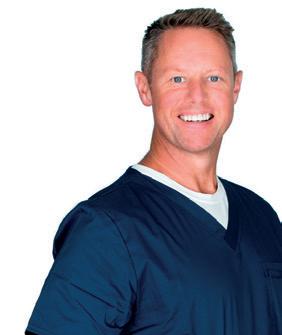
What’s the big deal with dental hygienists?
One of the leading reasons for tooth loss in New Zealand is untreated periodontal disease.
Periodontal disease is a preventable disease that starts with inflamed gums and leads to destructive bone loss.
Untreated periodontal disease has been linked to serious illnesses like pneumonia, Alzheimer’s and heart disease.
Dental hygienists are specifically trained to assess and treat periodontal disease and help you to keep your mouth healthy.
DENTAL HYGIENISTS ALSO:
• provide preventative dental care
• screen for oral cancers
• provide fresh breath treatments
• whiten your teeth
• assess wear and dietary effects on teeth
Oral health is a journey and it takes a team effort to keep your smile bright and healthy for a lifetime!
92 Te Mata Road, Havelock North
“The current local government funding and finance system is already under pressure and is not sustainable.”
877 7278 | smilehaus.nz
September + October 2023 BAYBUZZ 25
up to the cyclone we had a big work programme in train upgrading our drinking water network, providing homes for our people, revitalising our city centre, enhancing our parks and reserves and planning to provide infrastructure for growth. We could not stop those programmes ... we acknowledge the huge work of our staff, partners and contractors to carry on our BAU as well as work on the cyclone response and recovery – we had to carry on the BAU to meet our longer-term Hastings priorities.”
Probably the most celebrated non-recovery achievement of Napier City Council has been the opening of the re-designed Napier War Memorial Centre, hopefully putting to rest several years of distress. Around the city, work has progressed with the Westshore playground, various roadworks to make cycling and walking safer, and geotech work for new Mataruahou drinking water reservoir.
NCC also noted several successful events – Unity Pitch at Soundshell, Matariki Lightshow, the Football Ferns friendly match with Vietnam at McLean Park, and Divercity.
Mayor Kirsten Wise commented: “We have had to adjust and be flexible with what we can achieve post-cyclone. Time lines have been pushed back and we’ve pulled in our belt. Despite that we are getting the mahi done and we are delivering projects and services for our community. Recovery is a priority for us and now more than ever it’s important that we focus on delivering our core services really well rather than trying to accomplish a lot of different things that aren’t all needed right now.”
Down in CHB, apart from cyclone
recovery, the focus has been on addressing legacy underinvestment in water infrastructure, continuing major pipeline improvements begun in the second half of 2022. CHBDC also recently adopted its latest District Plan, called by Mayor Walker “a road map for land use diversification, decarbonisation and smart, sustainable residential growth close to key infrastructure”.
She commented: “I have to be honest – inflation and interest rates are going to put pressure on our big water and wastewater projects from now on. Combined with huge roading investments in recovery programmes, our balance sheet and our ratepayers are under huge pressure. Despite all that, CHB is well positioned for a strong recovery ... We know that our role in the future of the region is vital as industries look to diversify risk across catchments, make use of different microclimates and even reduce biosecurity risk from disease by spreading crops into geographically separate areas.”
Up in Wairoa, the main street redevelopment project has remained ongoing. The project includes a community courtyard and new business space development in a former burnt-out main street building. Initial resealing the netball courts at Standring Park was completed in time for the new netball season. More work will be completed in spring. And ‘healthy housing’ upgrades have been completed on pensioner homes.
“It has been challenging to make progress in areas that aren’t cyclone related, particularly due to Wairoa’s isolation. It is essential to grow our community and provide the best services we can for our people,” says Mayor Craig Little.
Air New Zealand is looking to fly an electric, hydrogen or hybrid aircraft on a cargoonly demonstrator route by 2026. And is looking for two airport partners.
Looking ahead
In our July/August magazine, I discussed more aspirational projects being mooted around the Bay – a new greenfields public hospital, a major film studio in Te Awanga, soil carbon farming, and waste-to-energy potential in the region. The last of these is explored further in this issue, and we will do likewise with the others in future editions and online.
Here are two additional ‘big picture’ possibilities to begin tracking.
Air New Zealand is looking to fly an electric, hydrogen or hybrid aircraft on a cargo-only demonstrator route by 2026 and expects to make an announcement around the type of aircraft it will be using by early next year. The airline is looking for two airports to participate in their trial of these aircraft, airports who want to further support the decarbonisation of aviation and are motivated to take on a leadership role in developing the infrastructure required.
Hawke’s Bay Airport is seeking to be one of those. Our airport has an already impressive sustainability track record to support its case.

Let’s cheer them on!
You can read more about it on our website.
Meantime, on the flip side of cyclonic rain and flooding, the Regional Council is progressing a series of water storage options. Consent approval is expected soon on the so-called Managed Aquifer Recharge trial in Central Hawke’s Bay, while investigations continue on moderate-scale, above-ground water storage possibilities for the Heretaunga catchment, with a report of those scheduled for HBRC councillors later in the year. Stay tuned.
26 BAYBUZZ September + October 2023
BayBuzz Premium
BayBuzz Digital BayBuzz Print
$10 off for joining ... $49.95/yr
$10 off for joining ... $39.95/yr $39.95/yr $14.95/yr $29.95/yr
• 6 issues of BayBuzz magazine per year
• 6 issues of BayBuzz Digital version exactly as printed (great for your tablet)
• All BayBuzz website content
• Weekly e-newsletter
• Free six-month gift subscription for friend
$10 off for joining ... $24.95/yr
• 6 issues of BayBuzz Digital version exactly as printed (great for your tablet)

• All BayBuzz website content
• Weekly e-newsletter

• 6 issues of BayBuzz magazine per year
• Free six-month gift subscription for friend

By email
Pay via bank transfer to 02-0655-0083775-000, including your name as the reference, and email your address details to editors@baybuzz.co.nz

Online

Follow the easy steps on the website and pay with credit card
baybuzz.co.nz/ special
--
PLUS
six $10 vouchers to iconic Hawke’s Bay retailers and
hot
with every new personal
Subscribe to the best thinking in the Bay.
SPECIALOFFER FORNEWSUBSCRIBERS Get
hospitality
spots
or gifted subscription to BayBuzz: Waipawa Butchery, Birdwoods, Chantal Shop, Fortify Clothing, Beattie and Forbes and Blackboard Jungle.
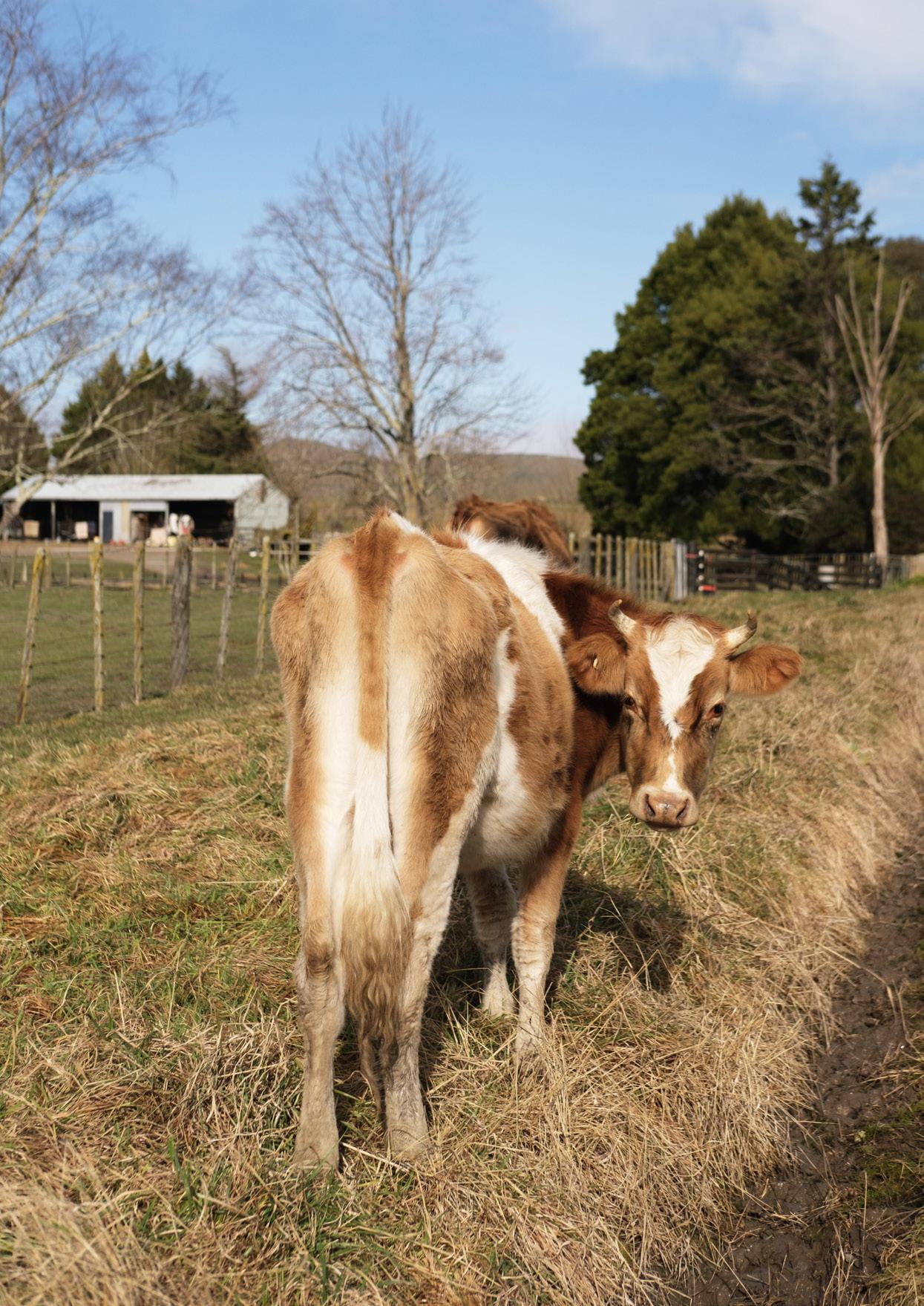
‘GOOD FOR THE FARMER, GOOD FOR THE PLANET’
Tess Redgrave finds that farmers and growers can respond to market expectations regarding emissions reductions or blame it on government regulators, but either way our farming practices will need to change ... quickly.
Story by Tess Redgrave
Photos by Florence Charvin
Around the time New Zealand signed the European Union Free Trade agreement in mid-July, Executive Vice-President and Commissioner for Trade, Valdis Dombrovskis issued a sort of warning:
“… Our trade agreements give us clout on the world stage and support economic growth and sustainable development – but as of now, we want to make them an even bigger driver of positive change. We will engage and support our partners to make this happen. We will step up our enforcement, and we will resort to sanctions if key labour and climate commitments are not met.”
For Central Hawke’s Bay farmer, Mike Peterson, chair of Scales Corp (owner of Mr Apple) and a former Special Agriculture Trade Envoy for the NZ Government, a warning like the above is part of the heft behind why New Zealand urgently needs to record and lower our agricultural emissions.
“New Zealand has made a whole lot of commitments on Climate Change, such as the Paris 2015 Agreement, and farmers have to do their bit,” he says. “The commercial sector will force it as big overseas companies watch our products’ emissions profiles.
“The reality is the commercial world is moving faster than government with demands from international companies like Tesco and Nestle wanting Scope 3 emission reports, which means accounting for all emissions in the supply chain.”
[The three ‘scopes’ are a way of categorising the different kinds of emissions a company creates in its own
operations and throughout its entire ‘value chain’ – i.e. its suppliers and customers. Scope 1 is direct emissions, 2 and 3 indirect.]
Peterson says Tesco, for example, the biggest buyer of New Zealand products in Britain, wants all their products to be environmentally accredited and reach net zero across their entire supply chain, Scope 1 -3, by 2050.
In a June interview in Farmer’s Weekly, Jeremy Hill, chief science and technology officer at Fonterra, said his company’s drive to reduce greenhouse gas emissions is a response not only to New Zealand’s climate goals, but to those of its global customers.
He told the E Tipu IFAMA 2023 World Conference in Christchurch that dairy farming’s methane emissions “are a difficult problem to solve ... Fonterra is investigating solutions that tick four boxes – good for the cow, good for the milk, good for the farmer and good for the planet.”
More recently Fonterra announced help and incentives to get farmers to produce their milk more efficiently and reduce supply chain emissions. These included some 18 different projects underway working to solve the biogenic (animal) methane challenge, ranging from feed supplements to manure management and even trialling Kombucha, which the co-op says has shown potential to reduce methane and may provide other benefits in early life intervention trials. Another trial is with a type of seaweed
“The reality is the commercial world is moving faster than government with demands from international companies like Tesco and Nestle wanting Scope 3 emission reports, which means accounting for all emissions in the supply chain.”
Mike Peterson
called Asparagopsis, a feed supplement that has shown potential for methane reduction in cows.
“There has been resistance from farmers to lowering emissions,” says Peterson. “But farmers have to do their bit. I know this is not a popular message. The reality is doing nothing is not an option.
“We’ve got to act.”
NZ’s ag emissions
According to the Ministry for the Environment, New Zealand’s agriculture sector contributes 50% of our gross carbon emissions. About three-quarters of this is biogenic methane emitted from livestock (sheep, cows, deer), followed by nitrous oxide. Nitrous oxide emissions from nitrogen fertiliser use make up about 3.9% of agricultural emissions.
Nitrous oxide and carbon dioxide emissions from agriculture are included in NZ’s net-zero carbon emissions target for 2050. However, there are separate 2030 and 2050 targets for biogenic methane emissions. The
September + October 2023 BAYBUZZ 29
target is to reduce biogenic methane emissions by 10% by 2030, relative to 2017 levels, and 24-47% lower by 2050. The split gas target reflects the different impact of methane – which is a short-lived gas – compared to carbon dioxide and nitrous oxide, which are long-lived gases.
However, while methane remains in the atmosphere for less time, its warming effect is 28 times greater than carbon dioxide, according to the Intergovernmental Panel on Climate Change (IPCC).
The IPCC advises that rapid, steep methane reductions, alongside bringing global carbon dioxide emissions to net zero by 2050, are needed to limit global warming to 1.5˚C above pre-industrial levels. That said, global climate scientists have recently warned that climate change is moving much faster than predicted and there is growing concern, as we move to an El Nino weather pattern, that 1.5˚C could be breached a lot sooner – even within this decade.
So what do our local politicians think about agricultural emissions and how to alleviate them?
Our politicians
Although the Labour Party hadn’t put out any updated policy on agriculture at the time of writing, the Ministry for
Primary Industries (MPI) is continuing to work on He Waka Eke Noa | We’re all in this together.
Established in 2019, He Waka Eke Noa (HWEN) is a joint partnership between farmers, agricultural sector industry bodies and Māori – with input from Primary Industries and Environment ministries – to find a way forward for mitigating and pricing our agricultural emissions separate to the Emissions Trading Scheme (ETS).
HWEN’s website sets this goal: by January 2025, 100% of farms will have a written plan in place to measure and manage their emissions. And that an on-farm pricing system, including carbon sequestration, would be up and running.
But HWEN hit speed bumps earlier this year with partners like Beef+ Lamb calling for a staged implementation of an agricultural emissions framework, and general concern that agriculture would be forced back into the ETS.
Labour MP for Tukituki Anna Lorck says, “The key milestones for the pricing of agricultural emissions have always been beyond the 2023 election. “The most important thing is getting an emissions reduction system set up that lasts.
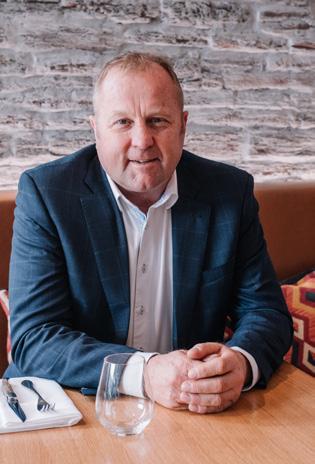
“We are working hard alongside the agriculture sector to strike the balance between building good levels of sector buy in, while also ensuring the system is robust and meets our emissions reductions goals. By continuing to work through our different positions together, we will move closer to achieving long term consensus on a plan that works.”
Lorck says under Labour if a system for pricing emissions cannot be agreed before 1 January 2025, then farming will enter the ETS.
“Free trade agreements now cover almost three quarters of New Zealand’s exports,” she adds, “up from less than half six years ago. If we don’t establish a credible plan to reduce agriculture emissions the future of our exports is at risk.”
The Labour Government has also set up the Centre for Climate Action on Agricultural Emissions within MPI, and in 2022 allocated $338.7 million to strengthen research and development to get new tools and technology to farmers to reduce on-farm emissions.
It is also reforming the ETS so it recognises all forms of carbon sinks, including more vegetation on farmland and the sequestering capacity of wetlands and peatlands. When fully implemented, landowners will receive
carbon credits for each tonne of CO2 absorbed by their land. They can then use those to offset other emissions or sell them to emitters.
The Labour candidate for Napier, Mark Hutchinson, says the evidence is overwhelming that the burning of fossil fuels combined with other causes of emissions (such as agricultural methane) is the significant contributing factor to climate change.
“I believe the most important thing the people of HB can do is to vote for one of the political parties like Labour who are leaning into this challenge rather than again kicking the can down the road like National and ACT. Delaying action now will lead to a place further down the track where even more aggressive action will become necessary at much greater cost.”
The National Party originally supported Labour’s He Waka Eke Noa approach but has now distanced itself from it, with Agricultural spokesperson Todd McClay calling the venture “dead…”
Instead National’s policy is to measure emissions at the farm level from 2025, but farmers would only begin paying an emissions price in 2030. National is betting entirely on technology fixes.
In its eight-page Reducing Agricultural Emissions document, National says it is committed to reaching Net Zero by 2050, and says New Zealand’s path to emission reductions in agriculture is through technology, not less production. The party wants to update biotech rules and review methane targets, and says it will remove the ban on gene technology which will help give farmers the tools they need to reduce methane emissions, such as gene-edited crops, feed and livestock.
National wants to keep agricultural emissions out of the ETS, with a separate
“There has been resistance from farmers to lowering emissions, but farmers have to do their bit. I know this is not a popular message. The reality is doing nothing is not an option. We’ve got to act.”
Mike Peterson
“I believe the most important thing the people of HB can do is to vote for one of the political parties like Labour who are leaning into this challenge rather than again kicking the can down the road like National and ACT. Delaying action now will lead to a place further down the track where even more aggressive action will become necessary at much greater cost.”
30 BAYBUZZ September + October 2023
Mark Hutchinson, Labour candidate for Napier
pricing systems for biogenic methane. Revenues raised from pricing agriculture emissions would remain in the agricultural sector to support R&D and on-farm mitigation and from 2024 it would limit farm conversions to pine plantations on high-quality productive land.
Catherine Wedd, the National candidate for Tukituki says HB’s primary sector is creating thousands of jobs and growing our economy “so we must be aspirational for our food producers.
“In the past six years Labour has hammered our farmers and growers with red tape, compliance and increased costs, to the extent that it is becoming unsustainable for many. This compounded with a cyclone has meant our primary sector will shrink not grow.
“We can meet our climate change commitments by encouraging technology and innovation. Tukituki has the most carbon efficient farmers in the world, yet we continue to inflict a war on our farmers, trying to control farming practise from Wellington. National
will make it easier for our farmers to farm and our growers to grow.”

Adds Katie Nimon, the National Party candidate for Napier, “We need to be pragmatic about reducing agricultural emissions to ensure we’re not sending production offshore to less environmentally-conscious countries.
“Of course, people in Hawke’s Bay are very aware of the effects of climate change on our environment and if we earn the right to be the MP for Tukituki and Napier, we’ll be strong advocates for climate-resilient infrastructure.”
The ACT party candidates for Tukituki and Napier were chosen as I was writing (ACT’s candidate for Tukituki is Rob Douglas, and for Napier, Pawel Milewski.) In lieu of contact with either, I was sent ACT’s position from head office.
“ACT will cap total New Zealand emissions in line with our top five trading partners,” I was told. “This would mean that the number of credits auctioned, and therefore the price of emitting, would be similar to our trading partners.
“Right now, farmers in countries who are our biggest trading partners are not paying a price for their methane emissions, and so neither should New Zealand farmers. We’ll remove barriers stalling the uptake of emissions reducing technologies. And we’ll ensure farmers can offset all on-farm sequestration from their emissions liability.”
Back to market reality
Both Jim Galloway, President of Hawke’s Bay Federated Farmers, and Mike Peterson say they can work with either of the two main parties to reduce our agricultural emissions.
“The farming sector may be our biggest climate polluter currently, but it also has the potential to be our biggest carbon sink.”
Nick Ratcliffe, Green’s candidate for Tukituki
“Their positions are actually similar,” says Peterson. “We need to act and the reporting of carbon emissions by farmers is important. They just differ on pricing and when it needs to happen.”
He thinks it is more important to get a reporting framework up and running and bedded in before pricing and predicts it may take as long as 2028 to get an emissions pricing framework right.
Jim Galloway says getting a pricing system for emissions right is “key” and “we want to engage with whomever is in government to achieve our goal, which is greenhouse gas reduction”.
Federated Farmers would like to see a review of New Zealand’s biogenic methane targets.

“The Government 2050 target of 23–47% reduction in methane will decimate our sheep and beef industries, because the only way to meet the targets is to drop stock numbers,” he says. “Also we’ll be dropping methane faster than is needed. It’s unrealistic.”
Galloway says we need a strong
“We can meet our climate change commitments by encouraging technology and innovation. Tukituki has the most carbon efficient farmers in the world, yet we continue to inflict a war on our farmers, trying to control farming practise from Wellington.”
Catherine Wedd, National candidate for Tukituki
In death as in life we can express ourselves authentically. Tong & Peryer’s family care team are there to support you in whatever form of care you choose to honour the person who has died and to respect the needs of the living. September + October 2023 BAYBUZZ 31
To honour. To remember. To heal.
www.tnphb.co.nz
emissions pricing system to incentivise viable mitigation options such as vaccines, feed additives and some options for breeding. One breeding option could be gene-editing to change an animal’s methane emitting profile. “But there’s lots to think about with this because, for example, you could change the methane profile but compromise the animal’s production value at the same time.”
Federated Farmers is also concerned about “emissions leakage” to other countries that are less emissions efficient if New Zealand doesn’t get its pricing and measuring system right.
But another Central Hawke’s Bay farmer, Will Foley, deputy chair of the Hawke’s Bay Regional Council has a different view.
He and his wife Abbie have three parts to their farm on the outskirts of Waipukurau. They have a traditional sheep and beef farm, an intensive lamb-finishing farm, and an 80 hectares regenerative block feeding cattle and
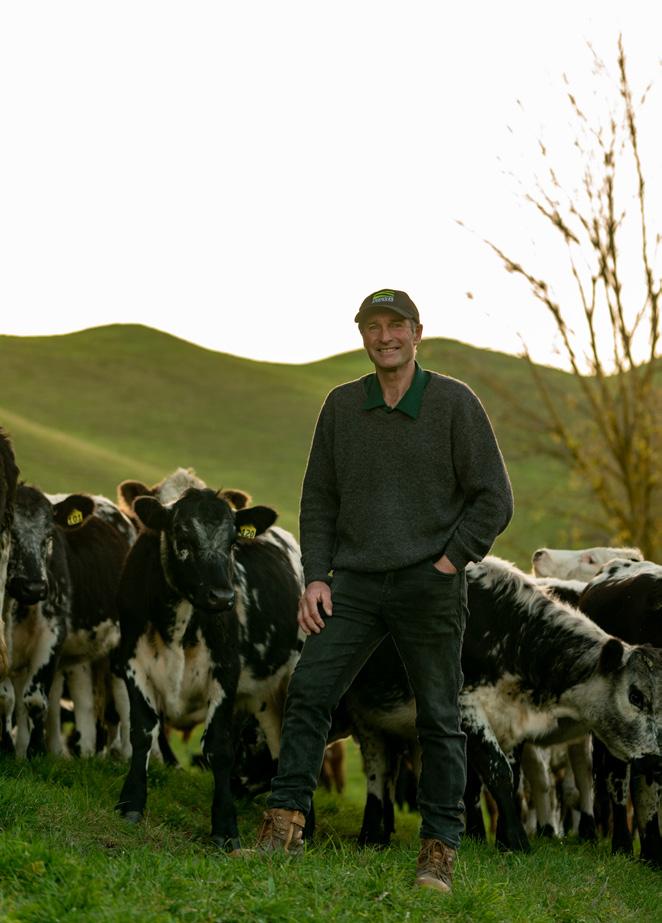
focusing on soil health and biodiversity.
For Will, the picture’s more complex than measuring and pricing agricultural emissions.
“We need acknowledgement from political leaders and scientists that we don’t have the full picture when it comes to understanding carbon emissions,” he says.
“We need recognition of the complete carbon cycle and of what is happening in our soil. There are different soil systems. Some leak carbon, some build it up and some maintain it.
“For example, in an ideal cycle, plants absorb CO2, water and sunlight and create sugars, these feed microbes in the soil which then give back nutrients to the plant, i.e. grass. The cow comes along and eats the plants, and the sugars broken down in the gut creates methane in the cow. Methane in the atmosphere is broken down to CO2 over a short number of years and then that CO2 is reabsorbed by plants photosynthesising once again.
“Their positions are actually similar. We need to act and the reporting of carbon emissions by farmers is important. They just differ on pricing and when it needs to happen. We want to engage with whomever is in government to achieve our goal, which is greenhouse gas reduction.”
Jim Galloway, president of Hawke’s Bay Federated Farmers
“It’s unfair to tax farmers on one side of this equation. We need to put more resources into understanding exactly what is going on.”
Both the Green and the Māori parties are closer to Foley’s view.
Says Tukituki Green’s candidate Nick Ratcliffe, “The farming sector may be our biggest climate polluter currently, but it also has the potential to be our biggest carbon sink. Regenerative grazing (or conservation grazing as it was when I was at Ag college) can sequester more carbon per hectare in agricultural soils, longer-term, than commercial forestry.
“Some Hawke’s Bay farmers are already seeing the benefits of regenerative grazing and silvipasture (an agro-forestry system with trees and grazing in the same space) and there is now a $2 million government-funded trial into regenerative farming practices for arable and vegetable crops, also here in the Bay.
“The big take-home from the Green’s agricultural policy,” says Nick, “is that we will ensure a ‘Just Transition’ to regenerative agricultural practices.”
According to its website, the Māori party would: “Phase out synthetic nitrogen fertiliser on farms by 2025 and bring methane emissions from agriculture into the ETS to disincentivise intensive methane-emitting agriculture.”
Further the Māori party would establish “a $300 million Mātai Ahuwhenua innovation and support fund to incentivise Māori farmers to transition to regenerative and value-add farming practises.”
Will Foley says New Zealand farmers already have good incentives for riparian planting, sequestration, wetland recovery, and planting pinus radiata for ETS credits.
“We need incentives for managing our pastures. The type of pastures a farmer grows is important. More diverse pastures are trying to mimic nature, providing a better diet for the animal and soil
32 BAYBUZZ September + October 2023
Will Foley, deputy chair of Hawke’s Bay Regional Council

microbes. This increases the ability to sequester more carbon into the soil.
“We’re told farming is bad for
climate change and we need to drop stock numbers. If we could combine all of the above incentives with a much more holistic approach, we could solve climate change.
“Tools such as new vaccines, genetically-engineering feeds/grasses to alleviate emissions are just more intervention and moving further away from mother nature. I think they are heading in the wrong direction.”

“I believe we do have to look at some
of the ways we farm – whether it is through consumer pressure or the regulators – there is change being forced upon us.”
That would seem to be the key takeaway all parties need to recognise and address – farming practices must change to satisfy sustainability concerns or market doors will close. Leading farmers and growers are adapting now; others might whinge their way to retirement.
@nationalartexhibition
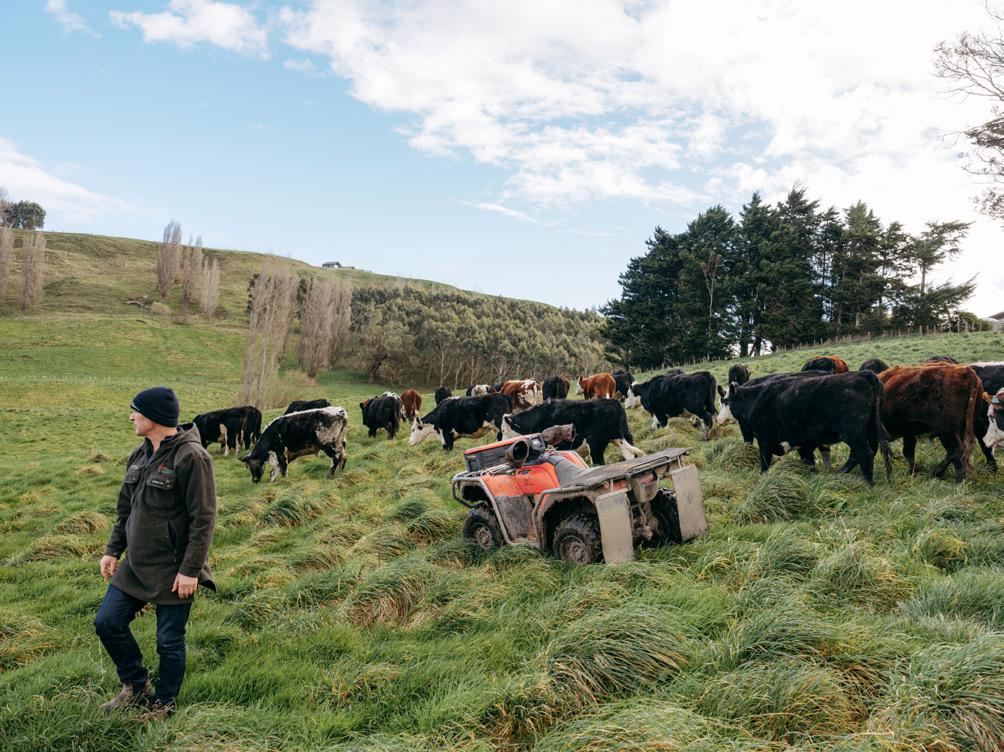
“It’s unfair to tax farmers on one side of this equation. We need to put more resources into understanding exactly what is going on.”
13–15 OCTOBER 2023 ELEPHANT HILL WINERY
Supporting Hawke’s Bay Surf Lifesaving Clubs
royston.co.nz Evolution Healthcare
Proud to be your private surgical hospital in Hawke’s Bay for over 100 years, and proudly supporting the Harcourts Artex National Exhibition.
I nationalartexhibition.co.nz September + October 2023 BAYBUZZ 33
WASTE-TOENERGY: HB’S ORGANIC GOLD?
 Pan Pac Boiler burning biomass.
Photo: Simon Cartwright
Pan Pac Boiler burning biomass.
Photo: Simon Cartwright
As the region grapples with its ongoing recovery from the February floods, BayBuzz is exploring possible improvements for long term resilience. Here we examine whether waste to energy solutions might be part of the basket of solutions that would see us robust and ready for future shocks.
Story by Bonnie Flaws
In the Hastings District Council’s locality plan for the recovery is a suggestion that $500,000 could be used to explore waste-to-energy solutions for the region. Unfortunately, principal advisor, district development Mark Clews says that this has not been scoped or made subject to a business case as there is yet to be any indication of support for such funding.
The thinking behind this suggestion was that if the region could become more efficient in its use of residual waste streams from forestry and horticulture, it could reduce Hawke’s Bay’s reliance on power generation from outside the region, better manage waste generated from weather events and natural hazards, and reduce the threat from forestry waste in the event of extreme climatic events, he said.
“Accordingly, a holistic review of waste to energy options with resilience at its centre may be timely as part of the longer term recovery mission. The focus here would be on dealing with organic primary industry waste and bio energy versus municipal waste and gasification, although some landfill diversion of organic residual waste (after waste minimisation efforts) as
part of a holistic approach may be warranted. At this stage however, there has been no indication of support or otherwise for the initiative or likely funding sources through the recovery planning activities.”
So, consigned to the wish list?
What’s out there already that could be built on?
Reporoa sets the standard
With respect to food waste, the Bay could benefit from something like the state-of-the-art Ecogas facility in Reporoa, says director Andrew Fisher. The plant is New Zealand’s first anaerobic digestion system using food waste to generate biogas and create renewable energy and carbon dioxide, as well as nutrient-rich bio-fertiliser.
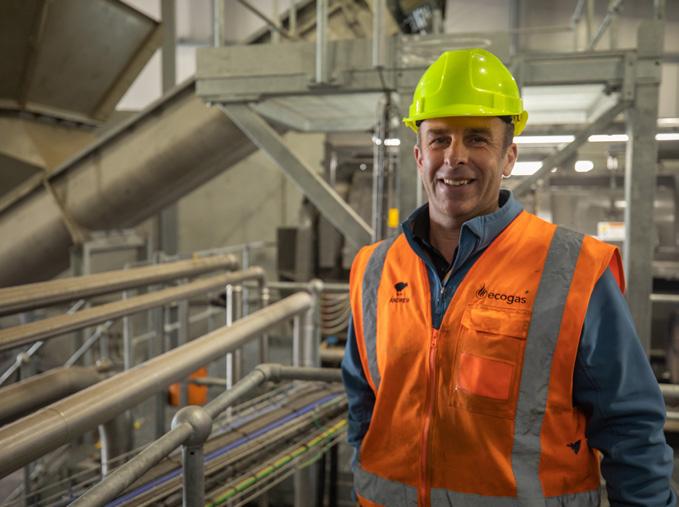
The plant, which opened last October, is a hybrid of three of the best such plants in the world. Sitting on just two hectares, it can process 125,000 tonnes of food waste a year but is only consented to do 75 tonnes. Compare that to the Bay’s BioRich, which processes 60 million cubic metres of waste, 40,000 of that in Awatoto, where they just received $1 million from the government to help get back up and running.
“It’s potentially the new green gold. It is organic gold. Things like bananas and oranges all have nutrients in their skins. Those nutrients end up at the bottom of landfills instead of going back into our productivity.”
Andrew Fisher, Ecogas Director
Ecogas was able to arrange for the collection of about 500,000 tonnes of commercial and domestic waste in the direct aftermath of Cyclone Gabrielle, which was turned into various resources: compost, bio-fertilisers, CO2, bio-methane, truck fuel, electricity, and hot water.
Fisher reviles the term ‘waste-toenergy’, however, because to him it’s more accurately described as ‘resource recovery’. “It’s not waste to energy –it’s not. It’s circularity of the nutrition cycle. This is water recovery; food is 80% water.”
He estimates that roughly 320,000 tonnes of food waste goes to landfill each year in New Zealand. Most of it household waste. The country grows enough food for 40 million people and there is plenty of commercial waste in the supply chain.
“It’s potentially the new green gold. It is organic gold. Things like bananas and oranges all have nutrients in their skins. Those nutrients end up at the bottom of landfills instead of going back into our productivity.”
Hawke’s Bay has all the elements necessary to be able to supply a regional plant, he said. He estimates
September + October 2023 BAYBUZZ 35
we were to divert all the food waste currently going to landfill in the North Island we could replace all the domestic gas use at 70% cheaper than the current price and 60% of the commercial gas use with something we have already got – that’s productivity and

fertiliser to replace synthetic versions on 7,000 hectares of land, the energy used by 20 hectares of glass houses, and the fuel for about 20 trucks – all products that New Zealand currently imports.
Ecogas is currently building a plant in Manawatū. So how would Hawke’s Bay go about getting one? The company is already servicing seven Hawke’s Bay sites daily, including meat producers, and transporting the food waste to Reporoa.
they wouldn’t work against existing providers like BioRich, whereas foreign owners would have no reservations about that.
Regarding ownership, he notes, “Councils can’t tell Blackrock what to do.” Blackrock owns roughly half of the country’s landfills.
New Zealand could easily keep at least 21 plants fermenting food waste. He points to Ireland, which is a similar size and population and yet has 31 such plants with another 17 under construction, and just four landfills. New Zealand on the other hand, has one plant and 134 landfills, “because we won’t debate and talk through stuff. For some reason on waste, we want to go back and discover the wheel. We spend so much time in that space as opposed to getting on and trying to copy [what works].”
“If we were to divert all the food waste currently going to landfill in the North Island we could replace all the domestic gas use at 70% cheaper than the current price and 60% of the commercial gas use with something we have already got – that’s productivity and reduces cost of living.”
The Reporoa plant produces enough
“Invite us to replicate Reporoa. We’d love to do something in Hawke’s Bay. It’s got all the ingredients. The councils don’t need the money. [Ecogas owner] Central Lakes Trust has the money and the resources, but you need to engage and be welcomed on, just like with iwi or communities.
“If they open the door and said look come down [we’d be delighted]. If they go through the tender route, well why would we bother when Nelson, Christchurch and Oamaru want us to build? It’s not arrogance, it’s about certainty. We’ve got seven big Hawke’s Bay companies who would write letters of support tomorrow. It’s cheaper for them to send waste to Reporoa than to landfills.”
Fisher says Ecogas is about 25% cheaper per tonne than sending waste to landfill. Benefits from going with Ecogas, he claims, are that the money would go back into the community,
The other half, apart from those that are council-owned, are owned by CKI, the largest publicly listed infrastructure company in Hong Kong. And it’s the landfill operators and the collectors that present the most serious opposition to plants such as Ecogas getting a foothold across the country, Fisher says.
Waste from forestry and woody debris
Nestled above the Oh My Goodness bakery-cafe in Hastings is the tiny office of Polytechnik, a globally leading Austrian supplier of biomass combustion plants. Director Christian Jirkowsky has lived here for 16 years, but like Fisher, thinks New Zealand is far behind the curve when it comes to utilising waste-to-energy technology.
He describes how Germany and Austria have demonstrated very successfully how well it works, in terms of the amount of biomass residues they are using in their energy systems. “It’s completely mind-boggling. Austria, a country three quarters the size of the South Island is using more biomass for
“If
reduces cost of living.”
36 BAYBUZZ September + October 2023
Andrew Fisher, Ecogas Director
“We know all the solutions out there and to a degree we know what all the woody resources are because of a report from SCION that looked at all the regions of New Zealand and quantified resources. If we think we would not have enough resources in the form of biomass in 10- or 20-years time, well how easy is it to just plant a tree?”
Christian Jirkowsky, Polytechnik Director
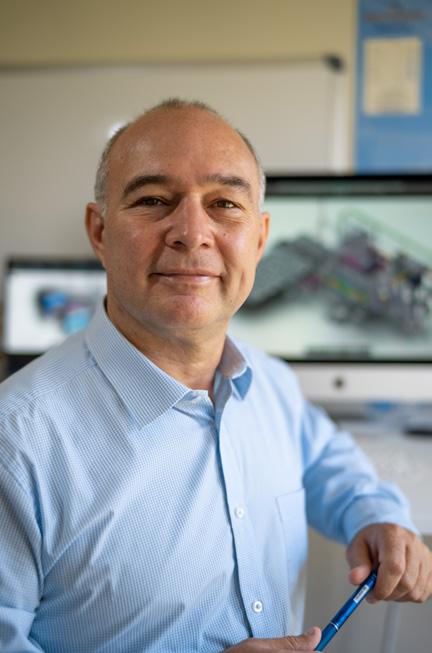
energy than New Zealand harvests in total, thereby having half a million biomass boilers in the country.”
Even better, he says, you wouldn’t even know they have a forestry industry because you never see clear-felled areas. “They have a forestry road network. You are only allowed to take out small numbers of trees in small areas, you are not allowed to do clear felling. Their problem is way worse, because their topsoil is gone so they can’t afford to do that. We just need to go there and see how it’s done and why and apply it here in a locally appropriate way.”
Jirkowsky is adamant about the need to stop burning fossil fuels and products like steel and concrete, and instead use wood to build our homes and buildings. He believes that New Zealand could run very well on a mix of renewable energy in 15 to 20 years. Biogas would be part of that mix, he says.
“Biogas, bioenergy is used biomass. We can use it to produce heat or power, usually a combustible gas for energy or heat and power directly. It’s a miracle really, biomass forms sugar from sunlight and carbon and then releases oxygen, which is used by us as a fuel. As we inhale, we burn it in our body and produce CO2 and get as a byproduct, energy and heat. It’s a closed loop system.”
This process is replicated in biomass boilers by taking various types of
woody biomass feedstock, such as densified pellets, wood chips, hog fuel, saw dust, peelings, shredded residues, shaving, branches and twigs and bark, and using them in biomass plants. This is a great way to utilise forestry waste, but also construction demolition, he says.
These various inputs can then be used in different processes: gasification, torrefaction, carbonisation and combustion gas. From these various boiler systems, high value products like hot water, steam, thermal oil, electricity, fertilisers, syngas, biochar, bio-methane and other drop-in fuels can be generated – depending on how they are designed.
He says a region like Hawke’s Bay could be completely self-sufficient using our waste streams to produce biogas for combustion and biomass to energy systems. The region could also produce high quality products like biochar from orchard biomass. Biochar has a myriad of beneficial applications including as an agricultural fertiliser, reducing antibiotics in livestock production, and cleaning up contaminated soil as it binds to toxins.
I asked Jirkowsky about HDC’s request for money to investigate waste to energy propositions. Had Polytechnik ever engaged with local councils or the agency? “They might have in-house experts in the field. We haven’t been asked, but if you get the right people, you should get a good
understanding [of what’s possible]. The risk with funding for studies is that what happens really quickly is that large consultancies suck that up in no time and you’re left with 500 pages but not anyone to provide a resource. It just gives you another idea.”
Instead, councils or the Recovery Agency could just talk to experts already doing these things, and who are often much cheaper than a consultancy, whose business is selling their time. Most of that knowledge already exists in the community, he says.
“We know all the solutions out there and to a degree we know what all the woody resources are because of a report from SCION that looked at all the regions of New Zealand and quantified resources. If we think we would not have enough resources in the form of biomass in 10- or 20-years time, well how easy is it to just plant a tree?”
Pan Pac: technical experts?
Speaking of experts in their field, what about Pan Pac, which has been burning woody biomass for fuel for around 45 years and taking community biomass residues for burning for about 15 years.
“We have got gas onsite and we can burn a bit of gas but that was to replace the oil and really as a backup and a top up thing. We put in a second boiler some years ago increasing our ability to burn residue waste. Then we put a
September + October 2023 BAYBUZZ 37
turbine in to make electricity out of it as well,” says fibre supply and utilities manager, Phil Hardie.
The forestry and processing company replaces about 12% of its electricity use by burning these residues for biofuel, according to its sustainability report.
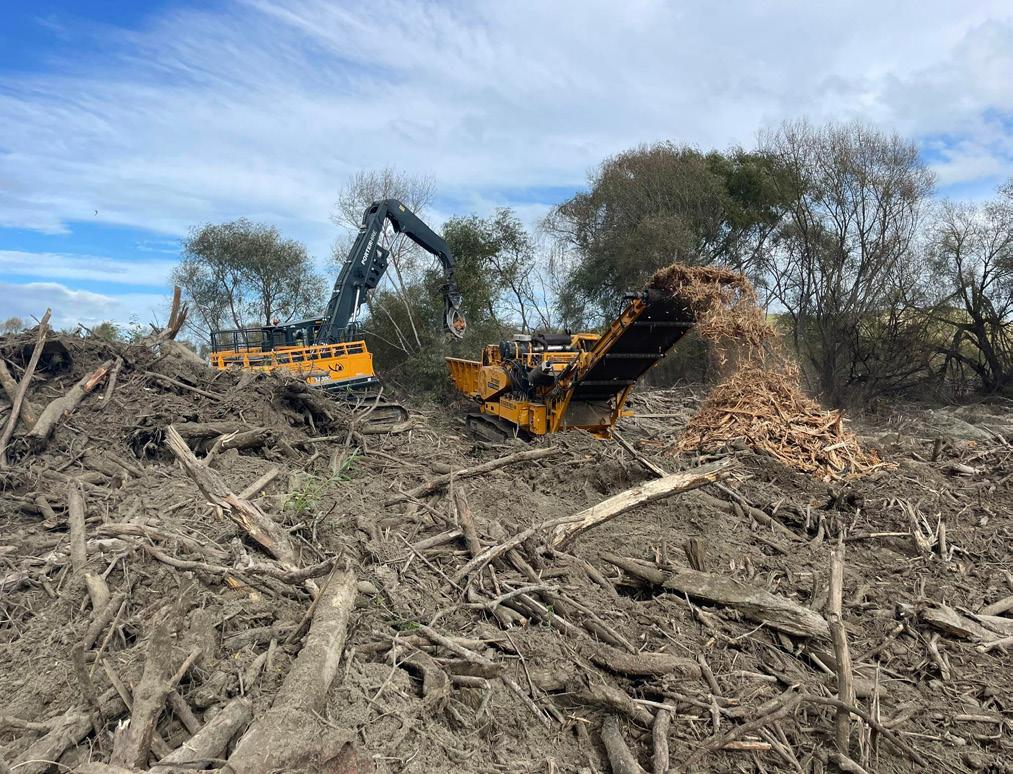
“The whole woody biomass industry for energy is in a state of growth around the country at the moment. It has come to fruition over the last few years. From our point of view, we couldn’t burn a lot more than we’ve got because it would max out the capacity of our boilers and we are pretty close to that right now. Unless we put some more capacity in the plant, and that would only be used to make something like electricity. We make enough energy to dry our lumber and pulp.
“We also have to be a bit careful because the competition for biomass is increasing and therefore the demand is growing. There is quite a lot of government money around at the moment to help you to do stuff. Organisations like hospitals and councils, schools, universities – there is funding there to help them move away from gas or coal. I think there are no schools burning coal now.”
“The whole woody biomass industry for energy is in a state of growth around the country at the moment. It has come to fruition over the last few years. From our point of view, we couldn’t burn a lot more than we’ve got because it would max out the capacity of our boilers and we are pretty close to that right now.”
Phil Hardie, Pan Pac fibre supply and utilities manager
us. There are quite a few stockpiles of logs around the place, and we are very interested in that and we’ll be looking to burn that if it’s not crazy pricing.”
Pan Pac, which was put out of action by flood damage, will soon be up and running again but won’t be at full capacity until March next year. It has already played a big part in collecting and stockpiling woody debris from the floods. There are a lot of clean-up locations and piles of hogged wood around the Bay at the moment, however, much of it isn’t suitable to burn in the Pan Pac boilers.
“They haven’t consulted with us first. They’ve gone and chopped it all up and it’s full of dirt and debris and most of that stuff is of no interest to
Hardie says there is potential for Pan Pac to expand into the collection of biomass for itself and to help stabilise the industry to a degree, so as to prevent pricing from getting out of control at a time when people are getting into the business. This would depend to a large degree on the price of carbon credits and whether investors believe they are set to lose or make money. However, he warns that the volumes of biomass needed to fuel such boilers are significant. The boilers at Pan Pac take 700 tonnes a day. To put that in perspective, a cleared orchard generates only about 100 tonnes or so of woody biomass, so collection volumes will be a critical consideration.
All in all, some great options for the region worth exploring, if those in the driving seat are willing to confer with hands-on experts and think and act outside the box. Could the Bay’s voluminous biomass be turned into Green Gold? Where there is a will then there’s a way, as they say. Is there a will?
ABOVE: Pac Pac hogger chipping wood during the Dartmoor clean up
38 BAYBUZZ September + October 2023


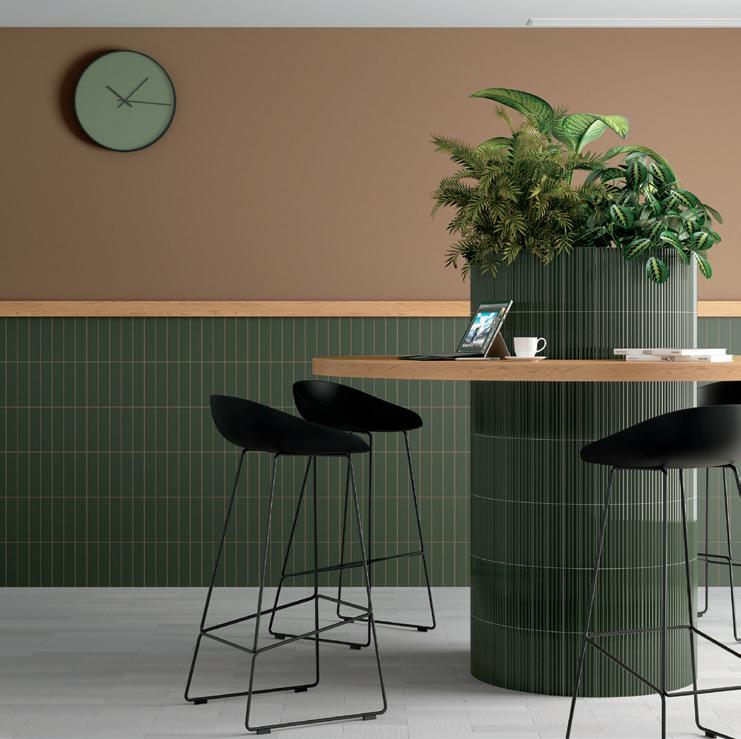
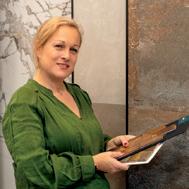
Did you know.. Tile Shed owner June discusses why tiles are a preferred choice around the world. 201 Eastbourne St West Hastings 4122 06 871 0587 sales@tileshed.co.nz 33 Oruanui St Taupō 3377 07 242 8004 taupo@tileshed co nz www.tileshed.co.nz Current trends are seeing natural, organic hues dominating the market, combining interesting shapes with 3D surfaces. Unleash your creativity and bring nature inside with beautiful warm tones and textures in your next project. Ask one of our talented design consultants at our Hastings or Taupo stores about the new Costa, Terralma & Vibe ranges and how to create a look uniquely yours.
Pictured: Costa Onda Laurel Green Matt 5x20 & Costa Nova Laurel Green Matt 5x20
Pictured: Costa Onda Laurel Green Matt 5x20

Sport Damon Harvey
SHOOTING FOR THE NBA
The 17-year-old wants to make it to bigtime in basketball – the NBA – and he’s well on his way, living in Washington DC and attending St Albans High School, recently being named in the New Zealand U17 team; grabbing attention at an NBA summer camp in Abu Dhabi and now getting US college scholarship offers.
Kahu has been back home in Clive on Summer Break before embarking on his senior year at St Albans High, one of the most prestigious high schools in the US, known for being the school of the rich and influential. Former US Presidents’ children have attended the private school.
It’s a long way from where it all started, at home in Clive as a 12-yearold shaping your ball game on two of his idols – father Chris, who was late to basketball but went on to play for the New Zealand Defence Force team while serving in the Navy and someone a bit more famous … the greatest sharp shooter to grace the NBA, Stephen Curry, of Golden State Warriors.
Like Curry, Kahu spends many hours standing in front of the 10ft hoop, honing pin-point accuracy, shooting consecutive ‘nothing but net’ shots as well as under the close tutelage of Chris, a performance coach, who has been helping develop his fitness, strength and agility.
As Chris says “the building blocks of a professional player”.
It’s obvious that Mum, Aroha
Treacher, a talented journalist, has also had a big role to play.

As Kahu wanders into their living room, throwing out his big tattooed right hand to greet me, with a welcoming smile, he turns to Mum and tells her how much he loves her. Something that’s pretty rare for a 17 year old to say, especially in front of a stranger.
It’s this grounded, yet focussed, attitude that is the hallmark of this closeknit whanau.
Before returning to the US for his final senior year, he went into a training camp with the New Zealand Under 17 team in Auckland as preparation for the FIBA U17 Ocean Championships to be held in Port Moresby, Papua New Guinea from 2–7 October 2023.
Another local player Ezrah Eagle is also in the squad.
Sport is big in the Treacher household with Chris and Kahu shooting hoops in the driveway, always trying to outdo each other in how many consecutive shots they can shoot through the hoop.
Up until recently Chris held the record of 20, with Kahu finally surpassing that shot count.
“I always fell short. I would get to 19 and blow it, it would get in my head that I couldn’t beat Dad.
Eventually with lots of practice, Kahu would go on to easily surpass Dad’s record – shooting 30 in a row.
The Treachers are fully invested in Kahu’s dream of playing professional
Kahu spends many hours standing in front of the 10ft hoop, honing pinpoint accuracy, shooting consecutive ‘nothing but net’ shots as well as under the close tutelage of Chris, a performance coach, who has been helping develop his fitness, strength and agility.
basketball, ultimately in the NBA or in another professional league elsewhere in the world.
Off to St Albans
He’s off to a cracking start, going from playing age group representative b’ball for Hawke’s Bay since the age of 13, through to a scholarship at Auckland Grammar and now at St Albans.
The commitment for the Treachers is significant. School fees are in excess of $100,000 NZ but the school provides financial aid. High schools are now allowed to offer scholarships.
“Instead of it costing an arm and a leg, it’s just costing us a leg. The financial aid they offered in the first year was significant and it covers dorm accommodation and food, but not medical insurance and
At six foot eight (or 2.03 metres) Kahuranaki (Kahu) Treacher has the physical attributes along with natural talent and hard work ethic to realise his hoop dreams.
September + October 2023 BAYBUZZ 41
other extras,” says Chris.
Kahu was surprised to hear the cost of the fees. It wasn’t something he knew until this interview and he digests how fortunate he is to be at a sought after school, thousands of miles away from Hawke’s Bay.
For many of his fellow students, the fees are a small investment in education. The parents of one student own the Marriott Hotel chain, while most have houses the size of the Pettigrew. Green Arena, the home of the Hawks.
“I was pretty overwhelmed when I arrived but the school itself was really welcoming and it took me a week or so to make some friends, and once I made some friends, I was away. Now we’re brothers.”
Kahu is proud of his Māori whakapapa and Māoritanga, which has been welcomed by the school.
“My physics teacher was buzzing that I was from New Zealand and I have taught her some Māori language.”
To be the best he can be in basketball, Kahu needs to make every post a winner in the highly competitive leagues in the States.
Upon arrival he admits it was daunting, taking a few weeks to understand how to play the American fast-paced style of basketball.
He had to trust the process and the groundwork done by Chris hoping that his fitness, athleticism and hard work ethic would impress coach Glennard “OJ” Johnson.
OJ had only seen snippets of Kahu on video, with one play being the deal maker.
For Kahu it was a part of the game he had yet to master. The slam dunk, the show pony part of the game where a basketballer runs down the court, leaps mid-air and ferociously slams the ball through the hoop, before hanging on to the hoop as a statement. It’s the big play that players and fans alike love about the game.
Kahu is keen to follow in the footsteps of Stephen Adams but only as a Kiwi player, not as a tough uncompromising defensive player for which Adams is highly regarded, but instead as an all-rounder.
Kahu’s first slam dunk came while playing in a senior competition in Auckland, and fortunately it was caught on film and shared to high school coaches in the US.

The St Albans coach says Kahu’s character has been a stand out feature.
“He is a bright light and brings lots of fun energy to the team with his athleticism and ability to dribble the ball at the size that he is.”
Path to NBA
For high school coaches in the US, they will know New Zealand’s most famous NBA player Steven Adams and perhaps see Kahu as the next big power centre.
Ten years on from Stephen being selected with the 12th overall pick in the NBA, Kahu is mapping out his next steps in the game and how to impress College talent scouts.
Kahu is keen to follow in the footsteps of Stephen Adams but only as a Kiwi player, not as a tough
42 BAYBUZZ September + October 2023
Kahu soars above his opposition while playing for St Albans High School in Washington DC.
uncompromising defensive player for which Adams is highly regarded, but instead as an all-rounder.
“When people hear that I am from New Zealand they think of Steven Adams and then they think you might be the same and have that toughness and mongrel, but I want to be more than that.”
He instead wants to pave his own way as a ball player, equally adept on attack, defense, dunking or scoring multiple three pointers like his alltime favourite player, Steph Curry.
He’s already ticked one box, surpassing the average height of an NBA player of 6 foot seven, which Kahu surpassed after a big sleep in at home on summer break, and is now marked in the hallway door at home.
In the high school leagues, they play ‘position less’ basketball where the coach has the confidence to put a player in any starting position whether it be small forward, point forward, centre or power forward.
Like Steph, Kahu is a sharp shooter too, spending at least an hour longer
each day than some of his St Albans team mates shooting extra hoops.

“In America the game is so much faster, it’s actually crazy. The speed they play, they just get the ball and they run.
“It took me about a month worth of games to start to get used to it.

At the NBA “Basketball Without Borders” camp in Abu Dhabi he

September + October 2023 BAYBUZZ 43
Kahu was rated in the top 10 under 17 year old players at the NBA “Basketball Without Borders” camp in Abu Dhabi.
impressed coaches, making the All-Star game and being dubbed one of the best players in the entire camp and in the top 10 in his age group in the world.
He was coached by Atlanta Hawks forward Saddiq Bey, who personally approved of his game saying he had all the tools to succeed – height, athleticism and the ability to dribble and shoot, and run the point.

Kahu has two routes to get into the NBA.
He can go to college in the hope of going into the draft or he can choose to play professionally elsewhere, including the Australian Basketball League and then get picked up by an NBA team.
He has a college offer on the table with Coastal Carolina and is also in talks with other colleges.
The Treachers are leaning on close family friend Steve Cozens, a talent scout with Airtime Australia, to help secure a college scholarship.
“If I went to college, I would like to do two years max in college and then hopefully will have done well enough
to go into the NBA draft.”
The only advice from Chris and Aroha is that if Kahu decides on a professional playing career, he needs to continue to study.
“We’ve said that if he chooses the professional route then we’d still like him to do some part-time study because you’re only one injury away from never playing again.”
As the trainer for the Hawks Basketball team, Chris says it’s still not too late for Kahu to play for this local team in the NZNBL, it would just be a matter of timing.
“Timing is everything. If nothing came up and the Hawks season had just started then sure, he would go and jump on that,” says Chris.
However, being based in the US, instead of New Zealand provides greater chance of NBA recruitment success.
“College coaches ideally want to see you play. So being able to play in front of them has been really good,” Kahu says.
“Plan A is to get to the NBA and there’s no plan B essentially.”
And with what team … there’s only
one – the Golden State Warriors alongside Steph Curry.
“I’d be happy with any team but if I could pick it would be the Warriors.
So as Kahu’s career takes flight, he wants to ensure that the commitment of his whanau and his own values remain deeply rooted to growing up in Hawke’s Bay. To that end his Tā moko (tattoo), which reflects his whakapapa (ancestry) alongside his ongoing personal story is etched onto both lower arms.
Kahu’s Tā moko is a bird’s eye view as well as a front view of his Maunga, Mt Kahuranaki.
Hawk in Te Ao Māori means Kahu, and the Tā moko will continue to develop as a journey of his life – where it all began and where it will go into the future – soaring to the top of professional basketball.
Starting like most kiwi kids playing rugby barefoot on frosty Hawke’s Bay mornings, Damon became a sports editor for the local rag and then a sport promoter for the ASB Tennis Classic, the national rugby championship and the Auckland Blues. He served 15 years on the board of Sport Hawke’s Bay, five years as chair, and continues to be involved in sport governance locally. A third-term Hastings District councillor, in his spare time he’s an action man – surfing, mountain biking, a gym bunny and a newcomer to water polo.
So as Kahu’s career takes flight, he wants to ensure that the commitment of his whanau and his own values remain deeply rooted to growing up in Hawke’s Bay.
44 BAYBUZZ September + October 2023
Kahu is developing his full court game under the watchful eye of St Albans coach Glennard “OJ” Johnson.
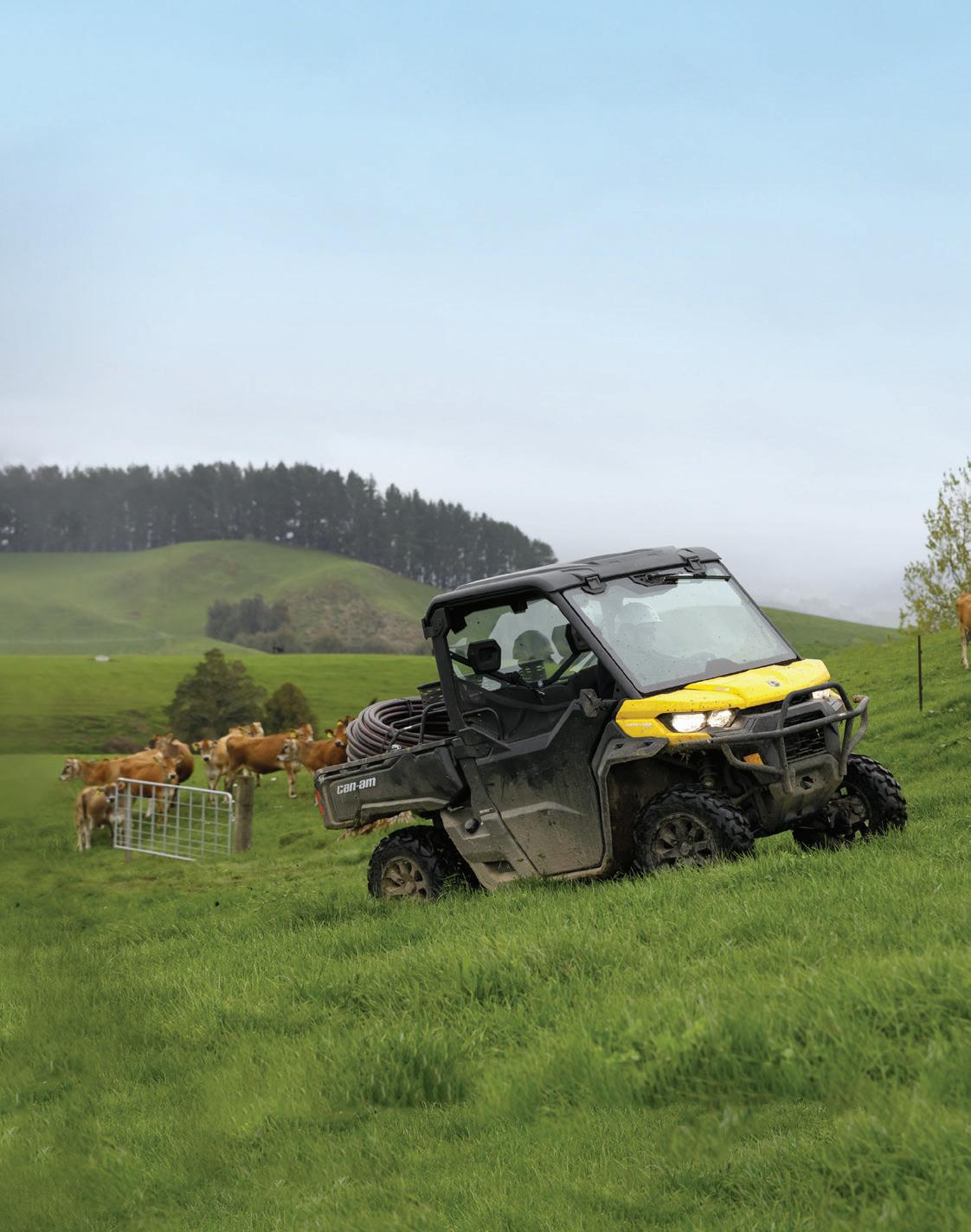

Jono Kight, Bay Motorcycles Group #1 Can-Am SSV Dealer in NZ Mobile 027 498 8284 | jono@baymotorcycles.co.nz www.baymotorcycles.co.nz
Professional training from the best in the business
Dale Carnegie Training has been around for 108 years, across 85 countries with over 9+million graduates. Our successful local franchise has been operating in Hawke’s Bay for over 30 years.

We offer public and customised in-house training programmes across the following essential skills:

• Leadership Development
• Customer Service
• Personal Effectiveness
• Presentation Effectiveness
• Sales Effectiveness
The core Dale Carnegie Skills for Success course is an eight week interactive learning programme, that develops effective communication and human relations. The key benefits include increased self-confidence, managing stress and worry, development in public speaking, communication and leadership skills. Next class commences 5th September.
ISO 9001 Accredited
NZTE Service Provider

Call Shiona on 021 990 192, or Annette on 027 208 1550 Email shiona@dalecarnegie.co.nz, or annette@dalecarnegie.co.nz
www.dalecarnegie.co.nz
Bay Biz


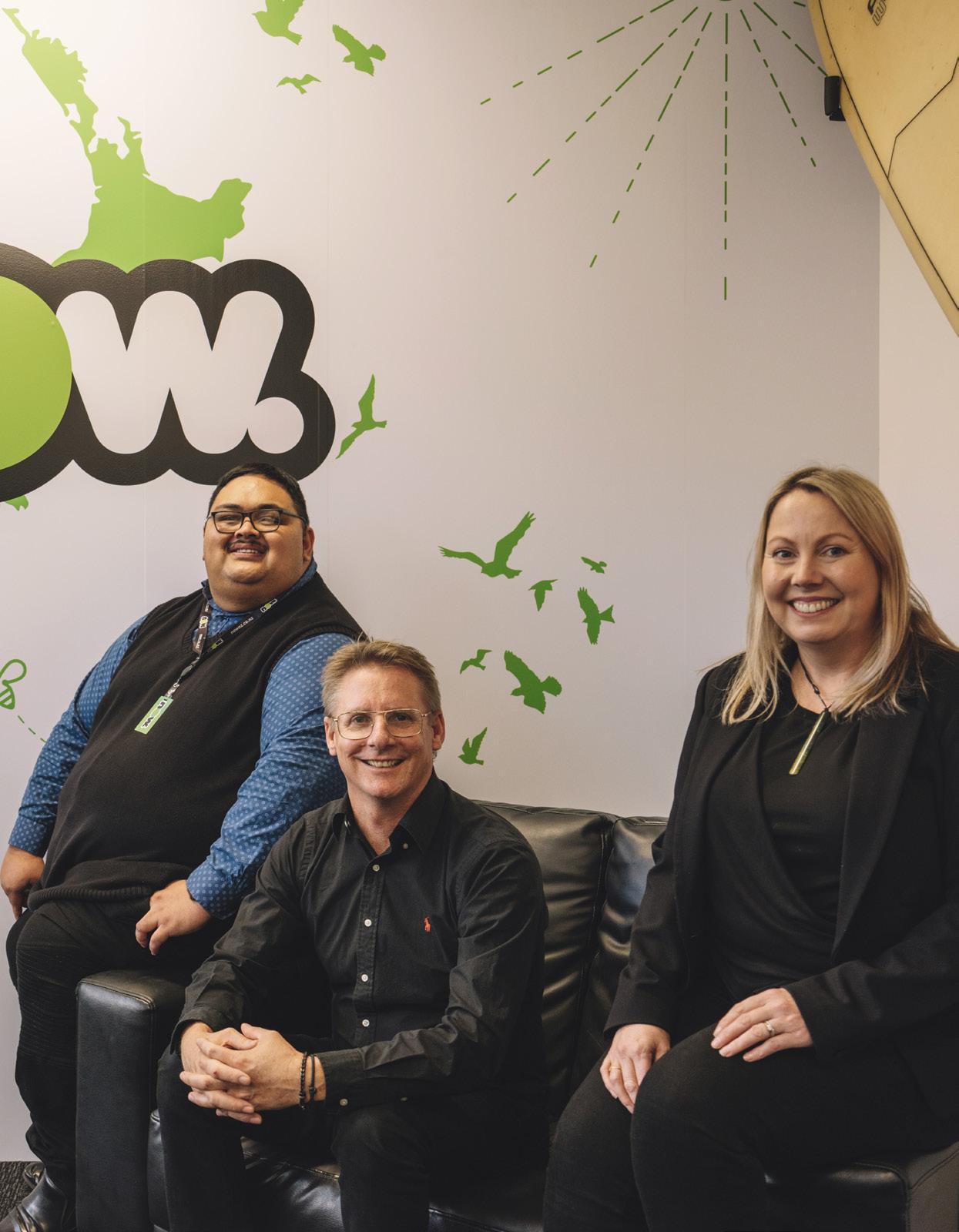
Now finds Māori insights. $30m home biz. Election and markets.
Jarden is proud to sponsor BayBuzz regional economic coverage.
Te Moana Barlow-Bartlett, Hamish White and Marie Fryer
Photo: Florence Charvin
NOW’S CULTURAL EVOLUTION
A cultural evolution is happening in Hawke’s Bay telco Now, and it’s all down to one man. Not the chairman of the board, not CEO Hamish White, but another local, who is inspiring his co-workers and leaders in equal measure.
Photos by Florence Charvin
Te Moana Barlow-Bartlett is gently guiding and encouraging his colleagues to learn about Māori culture, enriching Now’s challenger brand ethos that has seen the company win countless awards for customer support. But it doesn’t stop there. At Barlow-Bartlett’s behest, Now is also focusing on doing more business with Māori-owned companies, recognising the huge potential of the Māori economy, which is forecast to reach $100 billion by 2030.
While it’s a natural fit for Now, some in Hawke’s Bay might find it surprising. It wasn’t so long ago that a wāhine was asked to leave a Havelock North playground because her moko kauae was scaring children, and in another incident, a young McDonalds worker was asked to dial down his use of ‘kia ora’.

Thankfully, these incidents are out of step with the resurgence in te reo and renewed appreciation of Māori culture that is happening across the motu. A
nationwide poll conducted in August 2022 for Te Papa showed that 50% of all New Zealanders took action to mark Matariki in 2022. And here in the fishhook of Māui, Te Matau a Māui Hawke’s Bay, hundreds of bonfires lit up the coast to celebrate Matariki, drawing an estimated 25,000 spectators.
That interest in Māori culture is echoed in the business community. Local business, AskYourTeam, has been helping its public sector clients on their cultural competency journeys for the past two years.
In late 2022 the company released an insights paper aggregating the progress of the first 30 organisations to deploy Te ara ki tua, its cultural competency survey, covering feedback from 4,900 respondents, says AskYourTeam CEO Chris O’Reilly.
“Across the board, there is strong desire from employees at all levels to improve cultural capability, be it learning about language, world view, or knowledge of Te Tiriti o Waitangi. A large proportion of employees said that building their capability in te reo Māori is worthwhile.”
Steeped in Māori culture
Barlow-Bartlett (Ngāti Kahungunu) joined Now in 2021. Hailing from Waimārama, he was raised in a
community steeped in Māori culture that had a huge involvement in the revitalisation of te reo Māori, including learning and teaching the language. Kaumātua included knight, scholar, and a pioneer of the Māori language Sir Timoti Kāretu, the first head of the Māori Language Commission. With role models like that, it’s no wonder that Barlow-Bartlett is an emerging leader in his own right.
He has been instrumental in awakening interest in Māori culture and language at Now, which started in 2022 with the country’s first Matariki public holiday. At the time, Barlow-Bartlett was working in the call centre. Boss Hamish White asked him: what do you think we should do? Barlow-Bartlett says that Now’s first Matariki celebration was quite small. “We had a morning tea and a chat from me about the importance of Matariki to Māori.
“This year, our celebrations were a bit bigger with a focus on remembrance of loved ones who have passed away, including a video, a bigger seminar about the traditions and history of Matariki and how it can be celebrated today, and an inspiration wall.
“We had stars on the wall, and the team put their inspirations up. It’s so important to bring these ideas into every context possible. I get a lot of feedback from our staff saying that their kids are learning
BayBiz Brenda Newth
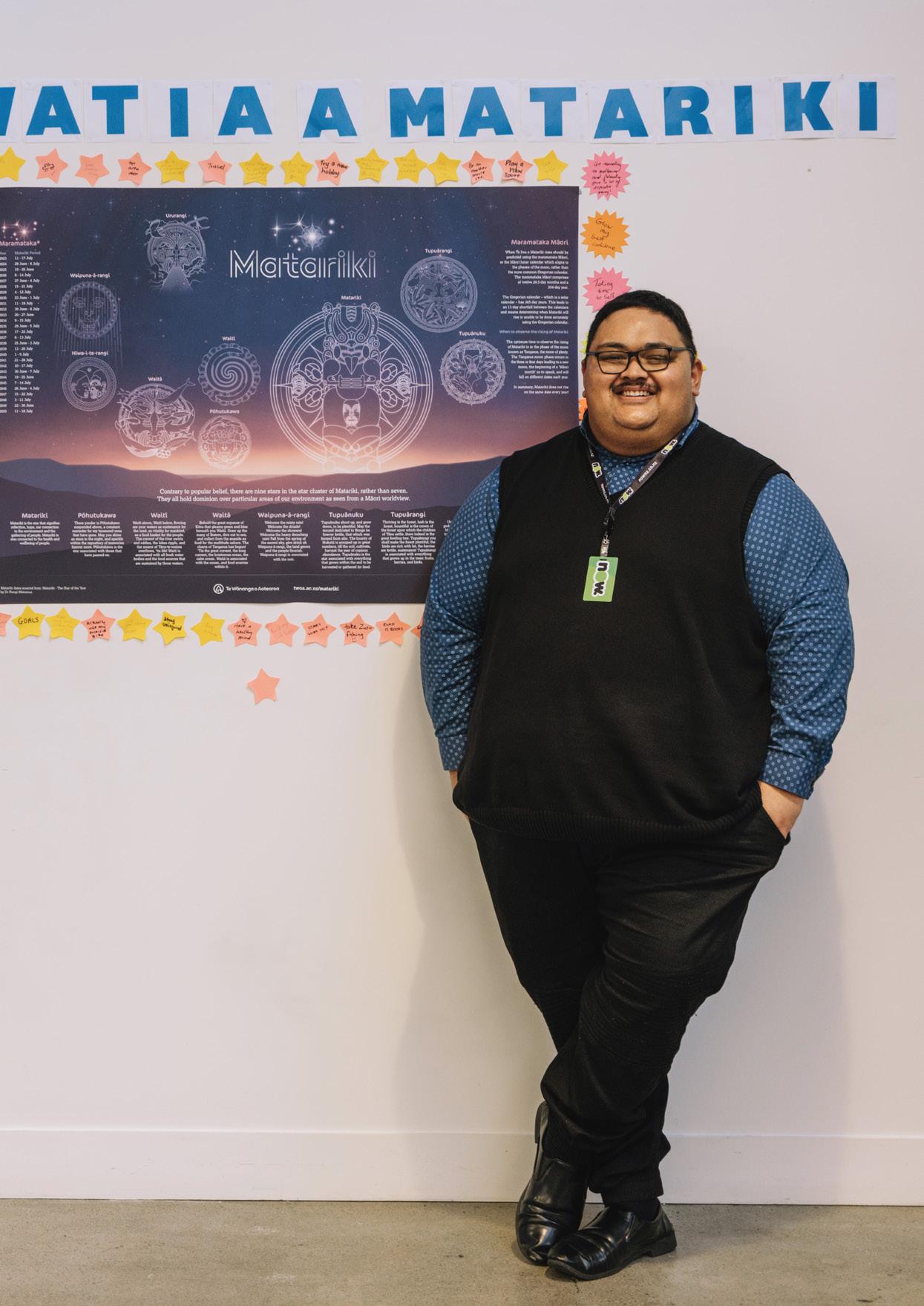
“My family are so shocked that I have this job. They don’t believe it’s real. They can’t believe I took my idea to pākehā and they were willing to work with it!”
Te Moana Barlow-Bartlett
so much about Matariki at school, and they feel they can’t meet that, because they haven’t had the same opportunity (to learn). Obviously, I’m not going to solve everything here at Now, but giving them the avenue to have those discussions and some knowledge, a lot of people have come up to me and said: ‘I’ll never forget what Matariki means because of what I’ve learned’ and to me, that’s a win.”

No Kiwi without iwi
Anecdotal feedback was the genesis for Now to target Māori businesses, says Barlow-Bartlett.
“I’ve got lots of cousins that own small businesses, and a lot of connections with larger (but still small) businesses owned by Māori. And they feel the service they get is very transactional. It’s very one-sided. You just pay the bill and that is that. There was no importance given to relationship building, or looking at them as more than just a number. And in my mind (and I didn’t think it could come to this) I thought, there’s a massive opportunity there for Now.”
Barlow-Bartlett says that the Māori business market was something new for him. “A lot of my work was researching for my own knowledge and making Marie (Now’s chief customer officer) and Hamish aware of how many businesses are within the sector.”
Soon, he was pitching his big idea: For a company proud to be 100% locally owned and operated it made
sense for Now to embrace, celebrate and foster our country’s indigenous culture. And that a planned approach to products and services tailored to Māori business customers in a way they could understand and relate to will allow Now to flourish in the growing Māori market.
It was an immediate yes, says Hamish White. “It wasn’t only about what Te Moana could bring to Now if he was given the remit and the space to do it in terms of culture, it was also about how he felt we could resonate more strongly with a part of the community,” he says.
Chief customer officer Marie Fryer says that what Te Moana pitched is very similar to what Now stands for.
“His presentation affirmed that the Māori business segment is a great segment for us to legitimately be in, because what we stand for is great relationships with our customers and providing that great service.
“And we’ve done some thinking about our structure … and reshaped Te Moana’s role a little bit, because it was a sales role, and then (the customer) was handed to someone else in our account management team, because that’s how we’re structured.
“What came through really strongly from Te Moana was that doesn’t align to the idea of a long term relationship. So now we’re shuffling the role to say if you sign up with Te Moana, he will continue to look after you.
“It’s bringing the strength of the
relationship that Now holds dearly to the light and making sure we’re doing it in a way that really aligns with modern customs and values,” Fryer says.
Barlow-Bartlett says he likes to call it the manaaki factor.
“Taking the time. Traditional business, it’s all rushed … get the signature as fast as possible. Māori businesses tend to move slower. Before the cyclone I travelled to Gisborne to meet with some local Māori organisations. And a lot of the feedback I got was that they got amazing stuff at the beginning from the providers … and then they were just dropped and left.
“And they said to me: ‘Boy we don’t want that from you’. So that was good feedback to hear. The style of service that Māori businesses like, aligns really well with how Now provides its service. So it’s not a huge difference that we do, but just those added extra cultural values,” he says.
A local icon, Now is a telco brand that’s proudly Kiwi, and proudly from Hawke’s Bay, says CEO and founder Hamish White.
“Now was founded on the belief that Kiwis have been deprived of good service for decades. The move to embrace and learn about Māori culture has happened organically. It’s not like we sat down and said what’s the market and let’s have a strategy.
“We have Te Moana to thank for that. He came into this business and he made an instant impression on us all. He has a spirituality about him
50 BAYBUZZ September + October 2023
“I really applaud Now, and I acknowledge the movement they’re taking and the way in which they’re doing it.”
Theresa Carter
Now’s Matariki inspiration wall
that I think we were ready for as an organisation.
“Culturally, he’s really enriched us with some of the Māori practices that he has started to slowly, but surely introduce. He’s started to spiritually enrich Now, and he has done it in a lovely way. And the business and the people that make up Now wanted more,” says White.
Learning and involvement in Now’s cultural journey is not mandated.
Playing the long game White says that culturally Now is much richer for having the cultural aspects of Māoridom incorporated into
the business.
“And it’s starting to manifest itself in all sorts of unplanned ways. It just happens and it feels right.”

Interestingly, in a sector known for targets, Now is not setting any output targets for Barlow-Bartlett, and White is very happy to play the long game.
“We’re not measuring Te Moana on results or outputs,” says White. “It’s more about an agreed programme of work, and we’re still working out what those should be, because it is a different way of doing business. And it’s so fitting for us because it’s about building relationships, and I attribute all of Now’s success to building relationships.
“The biggest thing for me was the cultural significance of embracing this, in terms of it feeling right. If anything we are going to be culturally much richer, elevating Te Moana in the business and having him have a far greater span of influence in terms of how things manifest themselves. We’re going to be stronger and richer for it. And if we benefit as a business, then that’s a bonus,” says White.
Entrepreneur, coach to Māori business owners and interim general manager of Whāriki Hawke’s Bay Māori Business Network, Theresa Carter (Ngāi Tūhoe, Ngāti Porou, Ngāti Rarua), says the essence of how Māori connect into entrepreneurship derives from the way ancestors used to trade.
“We do look at business and entrepreneurship through a different lens. Māori businesses operate from a collective mindset.
“It’s never actually about the money. Profitability and wealth for our people
doesn’t sit in a dollar value. A profitable business model and wealth from business is seen by connection to whakapapa, the connection to the whenua, ensuring that whānau as a collective, hapu as a collective, iwi as a collective, and Māori as a collective are thriving. Those are the elements that drive us in business. And you’ll see a lot of us in business actually have quite a social impact in what we do.”

As for what is important to Māori businesses when dealing with suppliers, Carter says it’s relationships first and foremost.
“It’s about whakawhanaunatanga and building those relationships where you can have reciprocal and mutual benefits.
“Coming back to an indigenous framework for business and enterprise, it comes back to principles that feed into us as Māori, like kaitiakitanga. How as Māori business owners are we ensuring that our environment is being taken care of, that our culture is being protected? There’s this huge resurgence and reclamation of our culture and this intention to better engage with Māoridom, however a small bit of knowledge, can be dangerous.”
She advises businesses wanting to embrace te ao Māori (Māori world view) to follow up with the right action. “It’s not about putting a Māori logo on things and saying, ‘we’re embracing’.”
Carter says it’s becoming more common for organisations to appoint Māori business advisors.
“It aligns with the reclamation that we are having as a whole country in terms of our identity to te ao Māori.
“I think that it is quite different
September + October 2023 BAYBUZZ 51
“Te Moana ... came into this business and he made an instant impression on us all. He has a spirituality about him that I think we were ready for as an organisation.”
Hamish White
and innovative for Now to take that approach, because generally speaking with corporates it’s all driven by targets, so to have a different approach where it seems like they are focused on internal growth, is that in the long term it will prove to be more beneficial to their organisation and will filter into their client base as well.”
Carter talks about one of her mentors, “He says if you want to change the world, look at yourself in the mirror. I see that as Now. If you want to change the business sector and how you engage more with Māori, look at your
own internal processes and your own ways of doing business and start from there, and organically your engagement with Māori will begin to occur.
“What we are starting to see – and Now is a perfect example of this – is privately owned businesses starting to follow the lead of public sector organisations, because we are starting to see the benefits of being unified.
“When you connect deeper to te ao Māori …you actually open yourself up to receiving this beautiful culture. So rich in so many things that it can offer our country as a whole in order to be able to move forward and shift into the future the way we need to.
“I really applaud Now, and I acknowledge the movement they’re taking and the way in which they’re doing it. They’re not forcing it (Māori culture) on anyone in working with the willing, and if you’re not willing that’s fine.
“I’ll be keeping a close eye on their journey and see how they evolve. But no doubt they’re going to be really successful in that area.”
The final word in this story has to go to Te Moana Barlow-Bartlett. “My family are so shocked that I have this job. They don’t believe it’s real. They can’t believe I took my idea to pākehā and they were willing to work with it!”
TE MOANA BARLOW-BARTLETT
• Ko Te Whanganui a Tara te maunga
• Ko Waingōngoro te awa
• Ko Ngāti Kurukuru, Ngāti Hikatoa
• Ngāti Whakaiti me Ngāti Ura Ki
Te Rangi ngā hapū
• Ko Taupunga te whare
• Ko Waimārama te marae
• Ko Tākitimu te waka
• Ko Ngāti Kahungunu te iwi
• Kaiarahi Pakihi Māori - Māori Sector
Lead at Now New Zealand
• 2023 recipient of Now’s Crafter of Culture award
NOW NEW ZEALAND
• 100% locally owned
• Consumer NZ People’s Choice Award for Internet
• Canstar Best Customer Support 2020, 2021, 2022
• NZ Compare Broadband Provider of the Year 2021
• NZ Compare Best Customer Support – Broadband 5 Years running
From humble Hawke’s Bay beginnings, to nationwide coverage
Industrial Automation, Processing and Plant Maintenance
Residential New Homes, Renovations, Heating and Ventilation
Commercial Schools, Hospitality, Warehousing and Office Blocks
Rural Dairy Sheds, Irrigation and Effluent Systems
52 BAYBUZZ September + October 2023
“His presentation affirmed that the Māori business segment is a great segment for us to legitimately be in.”
Marie Fryer
florencecharvin.com


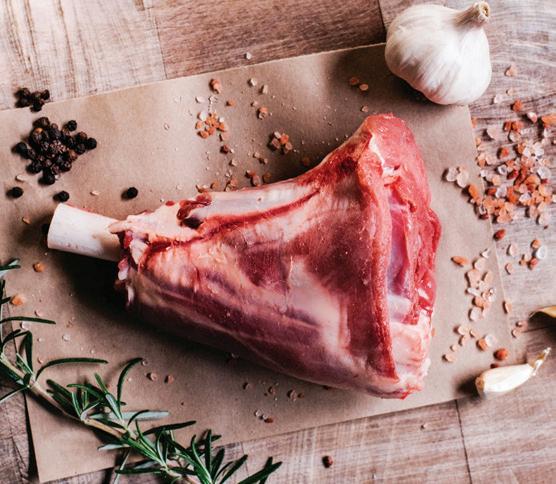
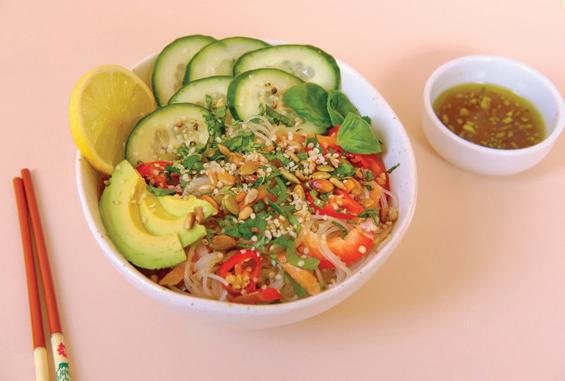

florence@florencecharvin.com

FLORENCE CHARVIN PHOTOGRAPHER
MEAN, BEANY MACHINE
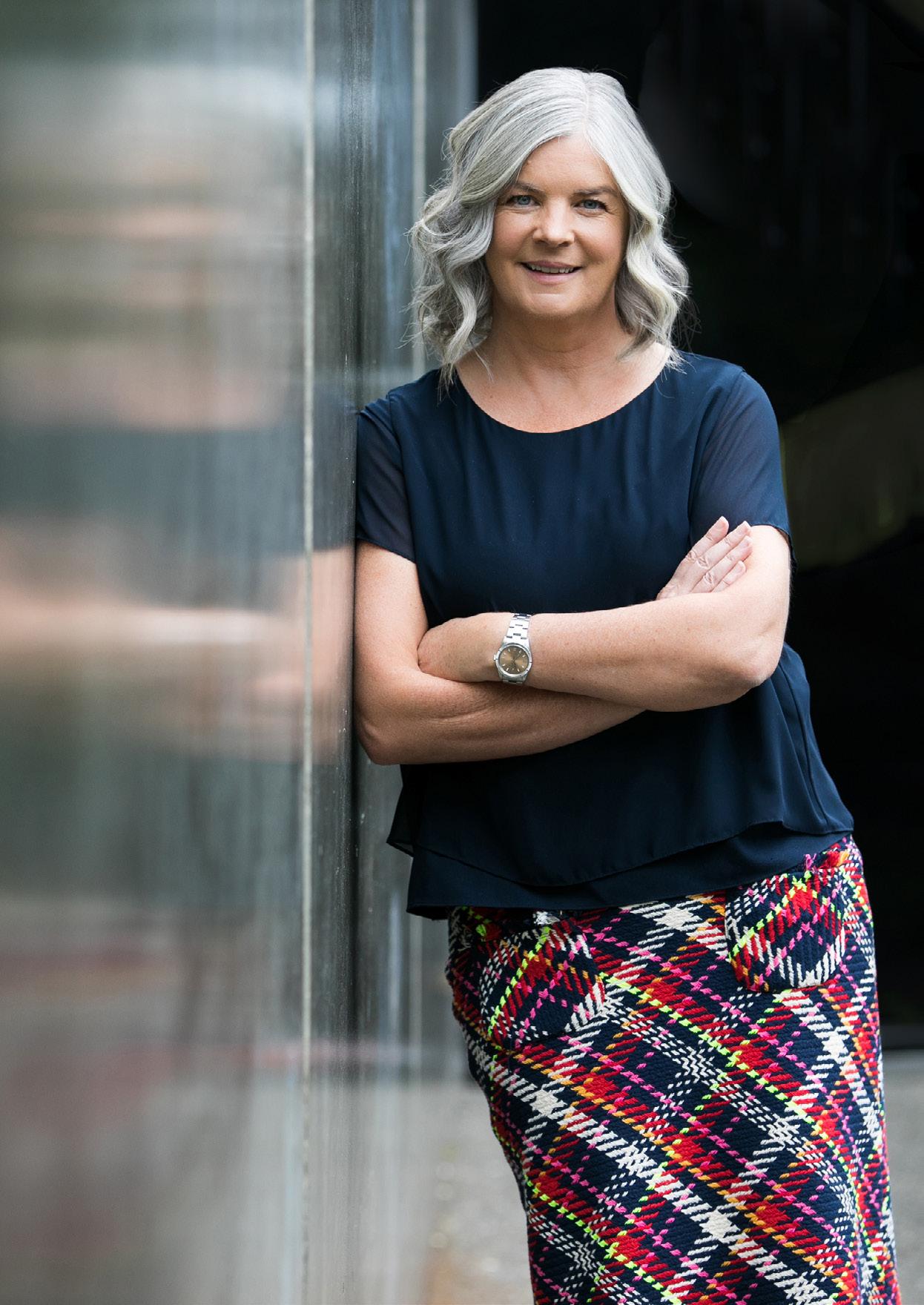
“Some of our best people started life as children. So take the time to be with your kids. You don’t have to explain it to us.”
Sue de Bievre
BayBiz Innovators Fiona
Fraser
ready to sink his teeth into something new. “We’d first met in the 1990s at the Holy Cow nightclub and had always stayed in touch. One day I asked him, ‘Do you think we could break the current model, and build a completely online platform for accountants to use to interact with their clients?’ And he said ‘of course we can.’ So we spent six months in a room coding.”
me and our children for the first two years – and I think I drew my first pay check in September 2015.”
Sue de Bievre is chatting via Zoom from London, where she’s spent the last month with her small, but growing, UK team. She has accountants in New Zealand, accountants in Australia, and her sights set on establishing a team of accountants in Canada.
All of them service small and medium businesses (SMEs) and like her, they all work from home. There are no glitzy offices or sterile boardrooms, and the accountants Beany employs to advise, assist (and simplify the tax obligations of) more than 6,000 business owners across the world are allowed – encouraged, even – to put family commitments ahead of work.
Arguably the best line on its website, in the section aimed at those looking to join the Beany team, is this one. “Some of our best people started life as children. So take the time to be with your kids. You don’t have to explain it to us.”
Sue’s a chartered accountant herself, who had dipped in and out of roles within big and small practices for over three decades when in 2013, increasingly disenchanted at the state of the sector, she started imagining a fresh approach.
“I remember thinking ‘Oh my God, in 30 years my profession hasn’t really changed at all’,” Sue begins. “My feeling was that accounting fees for small businesses were too high, when measured against the value that clients were receiving. There wasn’t a lot of feedback, or love, or respect, or mutuality in the relationship between an SME and their accountant. I thought about technology, and how we serviced customers, and the fact that we could all really be doing a lot better.”
Living in Taupō at the time, one of Sue’s best mates was Havelock Northraised John Curtis – a digital technologist and Weta Digital alumnus who was
With a Beany prototype complete, Sue recalls going to her former accountancy practice and offering to showcase her new product. “I felt I had this wonderful, new shiny thing, and I was confident that it was just what accountancy needed to perform better. But they said, ‘Sorry Sue – we’re actually doing it perfectly right now.’”
Luckily for Sue and John, there were plenty of businesses who were more evolved than those Sue had previously worked with. “We had precisely no security, no capital, and no backing,” Sue remembers. “But John and I both have quite a high tolerance for trying things and seeing what happens and we were both curious to see how our product would do in testing.
“So we invited 20 local business people to come and sit in front of a computer over two consecutive nights with our Beany test platform loaded up. And we said, ‘Use it, try and break it, let’s see what happens.’”
Of those 20 businesses, 17 put their hand up to purchase a Beany package. “That’s when we knew we had something, and that there was an appetite for it.”
For SMEs across the country, Beany provided a service nobody had previously thought of – a relationship with an accountant, enabled and enhanced by technology, and at an affordable price.
Before she and John had even formally registered the company in 2014, Sue was out generating revenue, selling to businesses hungry for a better way. When asked what word describes that first year in business, Sue laughs. “Unpaid!”
She recalls being buoyed by energy and enthusiasm, employing accountants to service customers and grow the business, but being unable to take a salary herself. “My husband supported
Sue and husband Louis moved to Havelock North in 2017, looking for a change of scenery and having already proven that they didn’t need to be in a metropolitan area to manage a thriving business. Things were progressing well, but with growth at the top of the agenda, they needed cash.
Expanding Beany
Beany’s first capital raise took place in 2015. A second in 2019 netted $1.5 million, attracting big-name investors such as K1W1 (Sir Stephen Tindle’s fund) and Ice Angels, the angel investment division of business incubator Icehouse.
Other capital raises have followed, which Sue says add up to a healthy $5 million, and it’s that security that has helped enable her and John to take the platform offshore. “We’ve extended into Australia and the UK, and put country managers in to oversee those territories,” she explains.

The benefit of the Beany software, she says, is how easily it can be replicated, for just about any market. “Outside of New Zealand, it really is just 90% carbon copy, along with about 10% nuance – things like the connection between the platform and the Australian Tax Office or the HM Revenue and Customs in the UK.”
She smiles. “I remember one sweaty moment when we turned Australia on. It’s all run off the same base platform so in theory, when we flipped the switch, the only thing that changed would be that Australia would be open for business. But we did have this horror creeping into the back of our minds that it might inadvertently collapse the New Zealand site. I remember John and I, that weekend, being really stressed about pushing the button. Like ‘should we do it now, John? Maybe later…’ But, much to our relief, it worked.”
Beany customers across the world have warmed quickly to being ‘matched’ with an accountant that can best service their individual needs –there are agriculture, hospitality, and media specialists, as examples – and transact entirely online and via video.
You won’t find Sue de Bievre sitting in a glass-walled office suite atop a city skyrise. This entrepreneur has built a $30 million global accounting business from her suburban living room.
September + October 2023 BAYBUZZ 55
They grow a relationship with their assigned accountant over time, plan their year, ask questions and interrogate their accounts, all within the Beany platform and using Xero as the software partner.
Plugin Accountant
And Sue’s not stopping with Beany. Her latest project, newly launched, is for the bigger boys (and girls) in practice as accountants. For them, there’s a platform called Plugin Accountant, which onboards new clients efficiently and effectively (including simplifying the verification of paperwork to meet laborious anti-money laundering obligations) through the click of a mouse.
This second B2B focused business came about when Sue was discussing the potential of her and John’s proprietary software with the then-CEO of Xero, Steve Vamos. “He told me that what we had developed was amazing, had huge commercial value, and that we needed to monetise it.”
Plugin Accountant has proven so popular since its launch in January that in April, Sue had to temporarily close the books to new clients. “We just needed to slow the pipeline down a little while we onboarded the customers we have – it won’t be long until we’re raring to go again.”
Happily ensconced in Havelock North (John remains based in Taupō, where he’s also founded a co-working space called Kloud), Sue says she thanks her lucky stars that the two met and became friends all those years ago. Although the

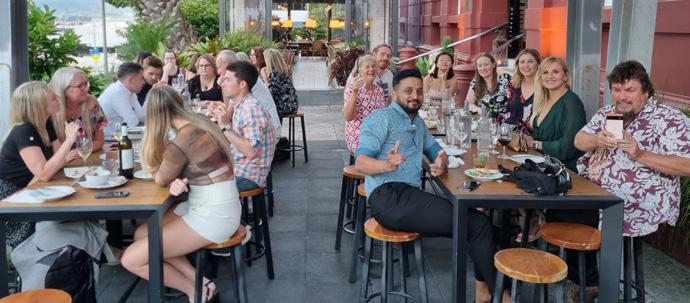
commonly held belief is that you should never go into business with a mate, Sue believes it’s been “effortless”.
“Some people refer to John as my second husband!” she laughs. “I definitely do love John, and the partnership has been ideal. He’s an incredible talent – a genius – and although we sometimes get shirty with each other, I honestly don’t recall any major tension between us, ever. He respects my ability to resource the company and run teams, and I respect his to generate amazing, innovative technology.”
For Sue, the intersection of customer service and tech has been a winning formula – and an ever evolving one at that. Thousands of iterations later (Sue says the Beany platform is updated and improved an average of 2.6 times each week), she says she still marvels at what is able to be achieved with what she likes to call “non-binary thinking.”
“What drives me is this constant sense of wonder around the technology, and a deep appreciation of my customers for believing in us, and my amazing team who I just love,” says Sue. As well a healthy dose of competition. “We’re miles in advance of our competitors and my strategic goal is to maintain that lead.”
www.beany.com


www.pluginaccountant.com
Fiona Fraser
is the
director of Contentment PR & Communications. www.contentment.co.nz

“What drives me is this constant sense of wonder around the technology, and a deep appreciation of my customers for believing in us, and my amazing team who I just love.”
Sue de Bievre
THE STATION
PUT YOU ON THE AIR Radio Hawke’s Bay has been ‘Putting the community on the Air’ since 1995! Got an idea for a program? Call Kelly on 06 878 8710 56 BAYBUZZ September + October 2023
Some of the largest team (NZ) and the Beany baby, UK team.
WHERE WE
Are you worried about your vision getting worse?
Orthokeratology (Ortho K) works by wearing a specially designed contact lens which gently reshapes the corneal surface while you sleep

Upon waking, the contact lens is removed and the reshaped cornea gives clear natural vision for the entire day


Shattky Optometrists delivers the highest quality eyecare and eyewear for all ages For more information visit Shattky today in Hastings or Waipukurau
HASTINGS / 116 Russell Street South / 06 876 3777
WAIPUKURAU / 36 Ruataniwha Street / 06 858 9117
shattkysoptometrists shattkyoptometrists

www.shattky.co.nz
At Becker Building we are passionate about energy efficient design and building healthier homes. We can manage the whole process from design to completion, or you can bring your design to us. Available for new builds, renovations, extensions and light commercial.
www.beckerbuilding.co.nz
karl@beckerbuilding.co.nz 022 301 9501
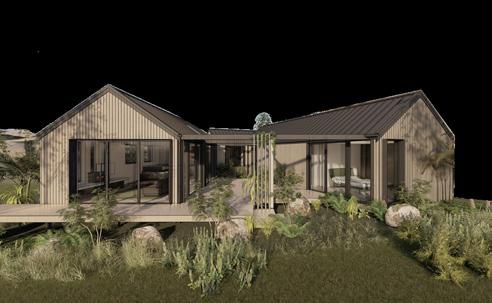
Getting Blurry vision? Sick of wearing glasses? Lacking confidence? Active in sports? Contact Lenses annoying? Are you or your family Would you like to know more? Call Shattky Optometrists to book an Ortho K Screening appointment with Tim Eagle
Shhh.... They're correcting their vision
September + October 2023 BAYBUZZ 57
BayBiz John Norling, Jarden
Weighing up the election impact on New Zealand’s financial markets
New Zealand’s next general election is fast approaching. Many assume our financial markets will take a hit in the lead-up to Saturday, October 14, but history suggests that may not be the case.
How is 2023 shaping up?
Labour had a decisive victory in the 2020 election, getting 65 of the 120 seats in Parliament, but the battle ahead is much tougher for the party. High inflation is clearly an issue for the government. As were several policies, many of which have subsequently been axed or delayed by the new prime minister, Chris Hipkins.
The election season will see further policies announced by all sides. Furthermore, negotiations with support parties inevitably mean some policies may end up being cut or altered to get the support needed to govern.
Labour and National both know the economy, health and housing are key. As such, each major party offers policies aiming to tackle these issues.
Labour is also focusing much of its pre-election policies on child poverty, climate change and working in partnership with Māori. On the other hand, National is focusing on building infrastructure, law and order and other more niche matters such as harnessing biotech, the welfare system, and agriculture.
Looking at the policies from both parties there is a clear drive for electrification of the New Zealand economy supplied from renewable sources. This will be welcomed by electricity generators and electricity distributors alike, and will likely have a positive impact on listed companies operating in this space.
Additionally, the focus on housing and building infrastructure is positive for the building materials and construction companies listed on the NZX.
Election’s impact on NZ financial markets
At any point in time there are typically multiple factors impacting New Zealand’s financial markets. Generally, elections pass with limited impact on them, but very occasionally there is an exception.
The final election held under the first-past-the-post electoral system in 1993 resulted in a hung parliament with the Alliance and New Zealand First parties holding the balance of power. This uncertainty caused significant financial market volatility, particularly on the Monday following the election.
This was resolved when the Waitaki electorate swung from Labour to National, giving National a one-seat majority. Financial markets quickly returned to normal.
As short-term interest rates are driven by the Reserve Bank of New Zealand’s monetary policy settings, they are highly unlikely to be influenced by elections. Examining long-term interest rates, we observe a multi-decade decline in New Zealand and elsewhere.
Consequently, when examining long-term interest rates we see that they generally fell both before and after the past 10 general elections. This is not a surprise given the significant impact of global long-term interest rates on New Zealand’s long-term interest rates.
What may be impacted is the New Zealand dollar. Examining changes in the value of our dollar over the past 10 elections suggests modest New Zealand dollar weakness leading up to the election, typically due to uncertainty around who will form the government, and then strength once the uncertainty dissipates.
A closer look at the data shows the massive effect specific events, such as the global financial crisis around the time of the 2008 election, and easing monetary policy in 2015 after the 2014 election had on the New Zealand dollar. This completely overshadowed any election impact.
Average change in the NZD/USD in the months before and after the last 10 elections

In examining the impact of New Zealand elections, we’ve looked at each election since 1993 and compared the performance of the New Zealand equity market with that of our closest neighbour, Australia, and the world’s largest equity market, the United States.
For many of the years shown there is a significant difference in performance between the best and worst of those three equity markets. We observe that in the period ahead of an election the New Zealand equity market only underperformed three times, 2005, 2011, and 2020. Meanwhile, it outperformed five times and was in line or middle of the pack two times. While the small number of data points mean it’s important not to read too much into this, it suggests that in the lead-up to the polls, elections are neutral-to-positive for New Zealand equity markets.
The impact in the three months post-election only shows one period of underperformance in 1999. Of the rest, three show outperformance while six show inline or middle of the pack performance. In this case the indication is the immediate post-election period is typically neutral for New Zealand equities.
58 BAYBUZZ September + October 2023
In conclusion, we expect the upcoming election to have limited impact on long-term interest rates and effectively no impact on short-term interest rates. However, there is some evidence that in the run up to an election the New Zealand dollar weakens due to election uncertainty, but it quickly recovers post-election.

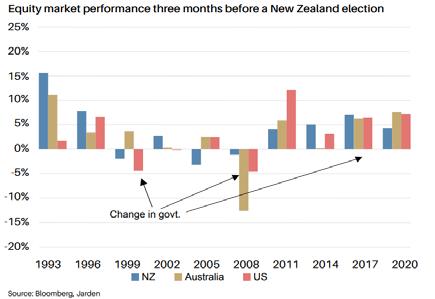
For the New Zealand equity market, the history available suggests elections are neutral on equity market performance after an election and are neutral to potentially positive ahead of an election.
More important for New Zealand equities are the political party policies that have an impact on particular industries listed on the local stock exchange. Only time will tell what policies will have such effect this year.

John Norling is Head of Wealth Research at Jarden. The information and commentary in this article are provided for general information purposes only. It reflects views and research available at the time of publication, using external sources, systems and other data and information we believe to be accurate, complete and reliable at the time of preparation. We make no representation or warranty as to the accuracy, correctness and completeness of that information, and will not be liable or responsible for any error or omission. It is not to be relied upon as a basis for making any investment decision. Please seek specific investment advice before making any investment decision or taking any action. Jarden Securities Limited is an NZX Firm. A financial advice provider disclosure statement is available free of charge at https://www.jarden.co.nz/our-services/wealthmanagement/financial-advice-provider-disclosure-statement

Strong investment decisions built on trust
September + October 2023 BAYBUZZ 59
Equity
three months before
Equity
Jarden’s local wealth management experts are on your side, they’ll make sure your investments are taken care of – guiding you toward your long term financial goals. Find out more jarden.co.nz Jarden
available
www.jarden.co.nz.
WEALTH MANAGEMENT
market performance
a New Zealand election
market performance three months after a New Zealand election
Securities Limited is an NZX Firm. Jarden Financial Advice Provider Disclosure Statement is publicly
at
Jarden is not a registered bank in New Zealand.
Dom Salmon

Sustainability can’t be a political football
Election season is here, along with all the usual messaging and political promises. But whoever steers Aotearoa New Zealand for the next three years should have a common focus around the circular economy and sustainability.
It’s abundantly clear the country needs to build resilience in the face of growing threats from extreme weather, meet pressure from international markets for sustainability, grow a circular economy and increase our action on climate change.
The election is all but certain to see a change in government – whether National takes back the reins or Labour stays in power through a coalition. Either result could see a shakeup in government’s approach to wider sustainability issues and, hopefully, a sharper focus on setting the policies to meet the country’s needs and goals.
We’re not starting from scratch
The good news is the last two
terms have seen the government make some notable headway. From single-use plastic phase-outs to reforming the kerbside recycling system (including food scrap collections), passing the country’s first zero carbon bill and expanding and increasing the waste disposal levy.
One of the most significant in terms of advancing a circular economy was the declaration of six product categories as ‘priority products’. This ushers in regulated product stewardship for the first time in New Zealand.
While not widely known among the public, it was a significant step towards a circular economy. It will compel those who make, import, and sell the affected products to ensure they are reused, recycled, or properly disposed of at end of life through a product stewardship scheme.
Single-use plastic packaging, tyres, synthetic greenhouse gases, e-waste, agrichemicals and their con-
The good news is the last two terms have seen the government make some notable headway. From single-use plastic phaseouts to reforming the kerbside recycling system (including food scrap collections), passing the country’s first zero carbon bill and expanding and increasing the waste disposal levy.
tainers, and farm plastics were all part of the announcement.
Tyres, through the Tyrewise stewardship scheme, will be the first out the blocks when it goes live next year. Work is being done on the others by industry and product stewardship specialists, but there is significant work ‘behind the scenes’ at the Ministry for the Environment too.
This is to ensure the regulatory
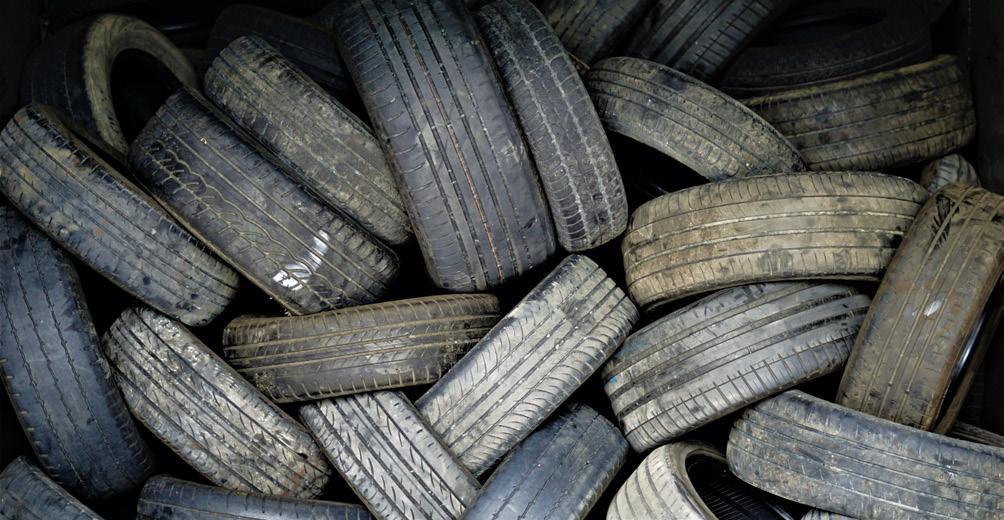
Ideas
Opinion
+
60 BAYBUZZ September + October 2023
There is also a very real financial incentive to hold up our end, with the potential for a carbon offset bill of anything from $3.3 billion to $23.7 billion by 2030 if we don’t cut our current greenhouse gas emissions trajectory.
framework and levers are correct and in place, so these schemes function well. It’s vital that resources are available for this work to continue so these schemes don’t get bogged down.
Staying competitive on the world stage
New Zealand has long banked on its ‘clean, green’ image to compete in international markets. With the increase in awareness and drive by customers worldwide for greater sustainability – alongside fears of greenwashing – there are now metrics to back these claims.
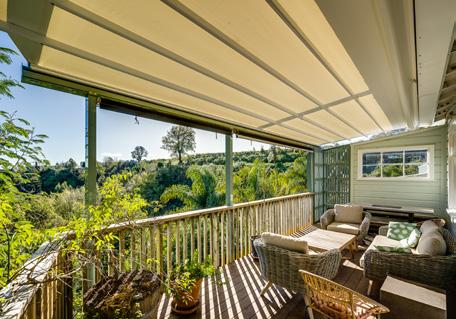
For example, major overseas supermarkets are using lifecycle analysis when selecting their suppliers and products. This takes a holistic look at the sustainability of the items they stock on their shelves. Glossy marketing won’t cut it anymore – facts and figures are needed too.
Aotearoa is heavily reliant on exports, particularly from primary industries, and if we want to be competitive on the international market, we need to show leadership in the sustainability and carbon reduction space.
This means investing in more
sustainable and lower-emissions production methods, supporting primary producers to transition away from fossil fuels and incentivising biodiversity and regenerative farming practices. Reducing waste, and dealing with the waste we do produce onshore, is also essential.
Building resilience to extreme weather
While it’s vital we build a more sustainable New Zealand and reduce our contribution to global emissions, there’s no doubt the impacts of climate change are already being seen. The upper North Island flooding and Cyclone Gabrielle were a big eye opener for just how vulnerable our homes, infrastructure, and livelihoods are. Building resilience into our infrastructure, better planning for new developments, improving preparedness for extreme weather events, and investing in work to determine where our biggest vulnerabilities lie, are all priorities which can’t be kicked down the road.
These can’t be matters of political convenience. They directly affect all New Zealanders and demand apolitical attention.
Meeting climate change commitments
New Zealand, like 194 other countries, is a signatory to the Paris Agreement – an international treaty to reduce greenhouse gas emissions enough to keep the rise in global temperatures below 2 °C above pre-industrial levels. The preferred goal is to keep warming to 1.5 °C to avoid the worst effects of
climate change.
Detractors would argue our emissions are too small to have any real effect on global warming, but the world’s smallest emitting countries cumulatively account for around 25% of all emissions. I would add that throwing our hands in the air, saying the problem is too big for us, and admitting defeat isn’t the Kiwi way.
There is also a very real financial incentive to hold up our end, with the potential for a carbon offset bill of anything from $3.3 billion to $23.7 billion by 2030 if we don’t cut our current greenhouse gas emissions trajectory. This will require us to buy carbon credits to balance the emissions books, meaning the bill is very much determined by how much we can cut our emissions and what carbon credits cost in 2030.
It was encouraging to see government change the settings for the Emissions Trading Scheme, which saw the price of carbon credits end its freefall and recover sharply. While it makes carbon credits more expensive, it gives the country the certainty it needs and sends the right signals to drive emissions down. The economic lever for change is a powerful one. Government has a lot of powerful levers at its disposal, and I challenge the next administration to use them.
3R design, implement and manage product stewardship schemes for individual businesses or industry-wide groups. They also help businesses take a fresh look at their waste to first minimise and then recover what would otherwise be wasted.
TRANSFORM YOUR OUTDOOR SPACE info@douglasinnovation.nz | douglasinnovation.nz Hastings Showroom – 413 Queen St West | 06 878 6300 At
Retractable Roofs Redefining outdoor living with For a custom space, talk to our team at Douglas. Douglas_1-3 Page Horizontal BB Ad_Sep-Oct23.indd 1 4/08/2023 11:08:24 am September + October 2023 BAYBUZZ 61
Douglas our team have installed Oztech Retractable Roofs all over the bay, from Malo and Smith & Sheth to the treetops on Napier Hill.
Ideas + Opinion Paul Paynter
Meet Jim, soon retired
“If there is a light at the end of the tunnel, I can’t see it yet.” said apple grower Stu Kilmeister in the HB Today recently. That sentiment perfectly encapsulates the mood that pervades our rural community.
Cyclone Gabrielle is yesterday’s news but it’s still the most important news for our region. The economic engine of Hawke’s Bay has suffered significant damage and it will affect every café and nail salon for years to come. While we can’t undo the damage that was done, we can monitor the recovery to ensure that the response from central and local government is working.
On this front, I have my doubts.
The biggest financial impacts were borne by the capital intensive apple industry, due to the preponderance of orchards in Pakowhai and Twyford, Esk Valley and all the way up the Tutaekuri River to Puketapu.
This industry is worth about $700 million to our region annually. The rockstar apple industry is now in a serious financial pickle and Gabrielle was the latest and most decisive blow.
Before this we had Covid, in which labour was very scarce due to the limited RSEs allowed to enter NZ, despite the likes of Samoa being ‘covid free’. When they did arrive there was a hefty bill for a two week quarantine in hotels that were more likely to infect them than sanitise them. Our border closures also prevented the usual influx of backpackers. These two groups make up 70% of our harvest labour force.
With closed borders unemployment plummeted in 2021 to the lowest levels on record. It was difficult to secure workers and they were expensive. Worst of all, growers took on many staff that proved to be ‘unemployable’.
The economic engine of Hawke’s Bay has suffered significant damage and it will affect every café and nail salon for years to come.
I’m not being cruel here, but the bottom end of our society is burdened by drug addiction, mental health issues and other factors that are so debilitating that they can’t reliably function in the workplace.
The third factor was the collapse of the European apple market in 2022. Poland is the biggest apple producer in Europe and their key market is usually Russia. A falling out over Ukraine led them to ship west, collapsing an already war-worried market. Many growers here received less than half their costs of production.
By the time we rolled into 2023 our industry was pretty beaten up and in need of a solid year. Despite the wet production season the crop looked very good until Gabrielle hit. No only was a significant part of the crop destroyed, but what remains was of mixed quality with rots and shrivel being commonplace.
The government response was and remains ponderously slow. The solution presented now relies on loans from Kanoa. Kanoa is the most successful Māori rebrand of a government agency, as the English name is the Regional Economic Development and Investment Unit.
The Kanoa loans are interest free until the recipient returns to profitability. ‘How does this play out in practice?’ I hear you say, because maths was your favourite subject at school.
Meet Jim
Take Jim, a 64 year-old grower who has been diligent and built up 40 hectares of orchards over his career. It was worth $10 million, with say debt of $3 million. He has $7 million in equity. You can think of him as a fat cat in need of a wealth tax; until you look more closely at his plight:
2022 losses due to market collapse $1 million
to market collapse $1
2023 crop lost to cyclone $1 million
million $1 million
Clean up costs (over and above government grants) $0.5 million
20% of orchards destroyed by Gabrielle $2 million
Clean up costs (over and above government grants) $0.5 million 20% of orchards destroyed by Gabrielle $2 million 2024 forecast losses based on R&M/reduced production $0.5 million
2024 forecast losses based on R&M/reduced production $0.5 million
Total balance sheet damage $5 million
Total balance sheet damage $5 million
So Jim’s assets of $10 million has quickly turn into $5 million, through no fault of his own. The painful thing is that there are no extraneous forces that delete debt – he still owes $3 million, and at a 60% debt level and faced with an operational shambles, he’s unbankable. In the brutal, Darwinian world of capitalism you could reasonably say the bank should sell him up. The grower would lose everything, but someone will buy his orchard cheaply, restore it and prosper. The only problem is that there are many people in this situation, no buyers for storm ravaged orchards and a paucity of operational talent. The economic impacts to our region and the banks are quite unpalatable.

Soft landing?
The government needed to engineer a soft landing.
62 BAYBUZZ September + October 2023
So, Jim could borrow $2 million from Kanoa and return his orchard to its former glory – but there are a few impediments. Firstly, it’s unlikely that he meets the criterion of having lost ‘30% of uninsurable productive capacity’. In my view government assistance would be better targeted at those that have lost 20% – they have a better chance of recovery.
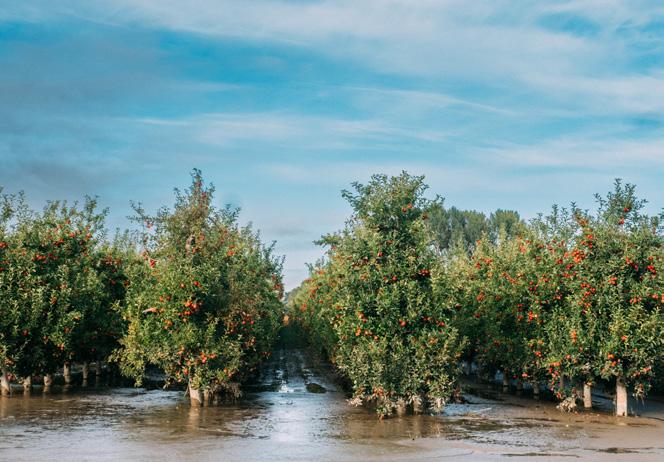
Secondly, Jim probably needs the $2 million for seasonal funding as his high debt levels will make the bank unwilling to make additional loans. Thirdly an additional $2 million of debt, that will eventually be interest bearing and need to be paid back, makes Jim’s business 100% debt funded. That creates a debt hole that will be very hard to climb out of. Moreover, any minor hiccups will be fatal. The government is absolutely the lender of last resort.
And finally, there is the age issue. At 64, Jim is about the typical age for a farmer across many sectors. His pathway is to try to return the remaining business to profit and then to use surplus funds to replant or retire debt. If he’s careful and prudent in his approach, it will take at least a decade to get back to where he was preGabrielle. Will Jim choose to risk his remaining capital to pursue this path, or is he better to use his last million or so to by a freehold house and retire?
Corporate welfare though handouts are usually offensive and electing to offer discounted loans is a surprisingly commercial approach. It creates the right commercial incentives. If you must pay the money back, you won’t spend it frivolously.
The challenge is that getting things right philosophically doesn’t mean they’ll deliver the right outcomes for our region. For Jim to take on more debt when he has a debt problem is a frightening and quite possibly, foolish option. I’ve crunched the numbers and the bank is right. The only realistic way to recover from serious financial trouble is to recapitalise the balance sheet. That’s certainly the case if a speedy path to economic recovery is sought. The government’s recovery package aims to ‘help North Island land-based primary producers’ which is a less ambitious goal.
Kanoa have a pool of $240 million of potential loans for all affected businesses across all the impacted regions. This sum looks short by a factor of 10, but I’ve crunched the numbers and suspect that many will
decline the offer.

The real costs of putting right the farms, orchards and vineyards would be closer to $2 billion than $1 billion, for Hawke’s Bay alone. It is essential that the public here are made aware of the quantum of the ‘Expressions of Interest’ and the completed applications as they emerge. They are the best guide we have as to whether the government response has been effective.

If there is not an appetite for loans that causes the $240 million to be significantly increased, then it suggests our local economy is set to shrink significantly. If that happens, make no mistake – you will feel it.
 Paul Paynter is our resident iconoclast and cider maker. Weather permitting, he grows stuff at Yummyfruit.
Paul Paynter is our resident iconoclast and cider maker. Weather permitting, he grows stuff at Yummyfruit.
We can renovate your Bathroom & Wardrobe! AWNINGS | BALUSTRAUDE | BATHROOMS | FENCING & GATES | INSECT S CREENS | SECURITY SCREENS & ROLLER SHUTTERS | SHOWERS WARDROBE DOORS & ORGANIZERS With our own Designers, Builders & Installers, the team at HomePlus can arrange your Bathroom Renova on from concept to comple on From Wire Ven ated Wardrobe Organizer to our Wall Hung or Floor Mounted Melamine Systems, HomePlus has a range to suit any budget or home. Visit our Showroom at 1014 O mahu Road, HASTINGS or Call Now (06) 879 8397 for your FREE Measure & Quote! September + October 2023 BAYBUZZ 63
Photo: Florence Charvin
Ideas + Opinion
Martin Williams
Gabrielle’s warning – time to get radical
My message to the August Regional Transport Committee meeting was blunt: “It’s time we got radical about transport in Hawke’s Bay”.
Auckland Council was taken to Court last year for not being radical enough about reducing carbon dioxide emissions in its most recent Transport Plan for that region. In Hawke’s Bay, I would expect an equivalent backlash if we did not direct our transport planners to forget business as usual and deliver a step change – even ‘disrupt’ approach – in our next Transport Plan, due out for consultation early next year.
All the focus right now is of course on recovering and rebuilding as a region from Cyclone Gabrielle. The ‘build back better’ mantra however begs an obvious question, what is ‘better’ for our transport system in 2023 when we are already at, if not past, the IPCC determined 1.5° tipping point for climate change and the UN Secretary General warns we are entering the age of “global boiling”?
Bearing in mind the many hundreds of millions of dollars of damage caused to our regional state highway, road and bridge network from just one greenhouse gas fuelled cyclone, I frankly despair at the lack of imagination and vision when I see the major parties campaigning on new roads as a blueprint for getting New Zealand ‘back on track’.
Until now I had seen the clarion call for four-laning the expressway as the Hawke’s Bay version of this ‘driving forward into the past’ approach.
This debate has been put to rest, however, with funding for four-laning of the expressway confirmed by both National and the current Government, but (from the latter) as part of investment in a wider transport system that can reduce overall emissions and improve resilience. More on this below.
In the silver lining category, Cyclone Gabrielle has dealt a hand of opportunity not seen in Hawke’s Bay for generations. We have to play that hand with conviction, and be bold.
In addition to the over $1 billion directed to repairing and rebuilding transport infrastructure in regions affected by Cyclone Gabrielle by the Government, a further $6 billion National Resilience Plan fund was announced in Budget 2023, which Waka Kotahi plans to lean on for some very significant state highway corridor improvements to both Taupō and Wairoa in the coming years. Beyond that, the 2024 Government Policy Statement (GPS) on land transport announced mid-August squarely confronts the need to proactively invest in road maintenance and renewals to ensure better resilience to severe weather events and other natural hazards, with substantially increased funding priority to these strategic objectives.
Daunting realities
Despite this heightened level of central government interest and support, we face some daunting realities in working through the options now in front of us, however bold and radical we might want to be.
There are over 4,500 kilometres of roads in Hawke’s Bay. Hastings District alone faces an estimated $800 million repair bill for damaged roads and bridges, way beyond its funding capacity to meet. Central Hawke’s Bay and Wairoa are in the same boat, but with a much smaller ratepayer base.
On the flipside, over 20% of our regional emissions come from transport, and nearly half of that from car travel (the rest from freight and light commercial vehicles). Regionwide only 0.5% of trips to work are by bus. We have one of the highest rates of private car ownership in the country. While our regional cycling culture is
legion, Napier is reportedly the least safe city to cycle in in New Zealand, and we have one of the highest overweight and obesity rates in the country. Outside Hastings and Napier, Hawke’s Bay basically has no public transport at all. For many rural communities, a morning traffic jam on a two lane tar-seal road like the current expressway would seem like a first world problem, even ‘luxury’.
Alongside our rebuilding task, we also cannot ignore central government direction through the Emissions Reduction Plan to reduce vehicle kilometres travelled by about 20% through “improved urban form and providing better travel options”, as part of a quest to reduce transport emissions nationwide, by 41% from 2019 levels, by 2035.
Overall, bearing in mind the scale and range of the challenges faced, it would be at best naïve to think that simply building more roads or four-laning the expressway was going to make our transport system more resilient to climate change, or radically reduce carbon dioxide emissions from our transport fleet.
Toward multi-modal transport
With all of that in mind, at our most recent Transport Committee meeting, we resolved to consult on a new Transport Plan which would put resilience at the forefront of all new transport infrastructure investments, so our roads and bridges can stand up to what future severe weather events might throw at them. But in doing so we also aim to deliver a ‘multi-modal transport system’ giving people choices (whether to take the bus, walk or cycle); keep our rural communities effectively connected, and indeed put our communities at the centre of future transport planning.
Our vision for a transformed Hawkes’ Bay transport system would
64 BAYBUZZ September + October 2023
certainly be more achievable if the greater funding priority on resilience, road maintenance, public transport, rail and cycling signalled under the draft GPS, is politically secure post-election. But this inevitably comes at a cost, with increased fuel taxes and road use charges also proposed, so we will need to watch this space. There is no hiding from this. However you slice and dice it, everyone will ultimately have to pay some share for the ‘fit for future’ transport system now so desperately needed, nationwide. An honest bi-partisan acceptance of this reality across Parliament would be a great start towards that future.
Returning to what we can control, our vision does not just see roads as places for cars, but for people, and as pathways to the type of society, environment and community we want to live in, rather than simply drive through.
To give an example, at the February Transport Committee meeting we were treated to a compelling deputation from Te Whatu Ora Hawke’s Bay recommending a direct ‘cycle highway’ from the bottom of Heretaunga Street to the top of Kennedy Road, connecting Hastings and Napier, via the hospital and EIT.
E-bikes have expanded the comfort zone and range for the cycling community substantially, but the number
There are over 4,500 kilometres of roads in Hawke’s Bay. Hastings District alone faces an estimated $800 million repair bill for damaged roads and bridges, way beyond its funding capacity to meet.

one barrier to taking up cycling is safety. Separate purpose-built ‘active transport’ corridors would solve that problem. We could (for example) dedicate the Te Whatu Ora proposed cycle highway to public and active transport, and conversely give freight and commercial traffic a freer and faster run on (say) Taradale Road in Napier and St Aubyn Street in Hastings.
Likewise, and in my opinion, rather than looking at the expressway in isolation we should bid for Crown investment under the new GPS to support a multimodal or dual corridor approach. One option is dedicated bus or cycle lanes on the expressway itself. Another is where extra lanes on the expressway are complemented by the type of public and active transport corridor or ‘cycling highway’ proposed by Te Whatu Ora, but on a different route. Similarly, we can look at repurposing parts of our CBD street network, not just as places for cars to drive and
park, but instead for people to linger, be entertained, dine and shop.
To get folk into town. our 20222025 Public Transport Plan would deliver a doubling if not trebling of the frequency of buses on the key routes both between and within Napier and Hastings, and a peak time bus service from Central Hawke’s Bay to Hastings. This could all be supplemented by MyWay to ensure better network coverage in both cities, as being trialled (successfully in terms of patronage) in Hastings, but again everything hinges on sufficient secure public transport funding, post-election.
You might fairly wonder whether any of this sounds that radical? Some of these ideas are ‘old news’ to progressive transport planning experts. But we are undoubtedly now at a crossroads in our vision and planning as we look to design a regional transport system fit for the future. One that not only keeps our rural communities better connected in the face of climate change, but transforms the way city folk get around.
That defines what “better” should be as we build towards a region of healthier people, communities and environment.
HBRC councillor Martin Williams is chair of the Hawke’s Bay Regional Transport Committee.
September + October 2023 BAYBUZZ 65
Photo: Florence Charvin
WRITTEN BY ZOE BARNES FOR HASTINGS CITY BUSINESS ASSOCIATION
WRITTEN BY ZOE BARNES FOR HASTINGS CITY BUSINESS ASSOCIATION


HASTINGS CITY HIDDEN GEMS
HASTINGS CITY HIDDEN GEMS
8 BUSINESSES THAT FLY UNDER THE RADAR, THAT YOU NEED TO VISIT ASAP.
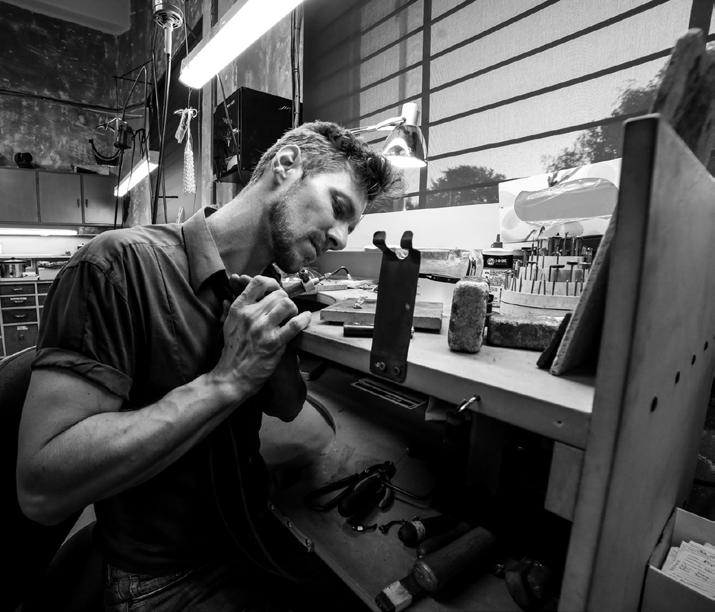

We Hastings folk are an unassuming bunch. We don’t like to toot our own horns too loudly, we like to keep our heads down - Influencers in the Wild won’t be getting too much content out of us. Because of this, we have taken it upon ourselves to hunt down some of Hastings City’s most modest, humble, hard workers who are absolutely smashing it at their day to day and highlight them to you. While you may or may not find them online, you absolutely should visit them IRL (in real life). Introducing eight hidden gems in Hastings City - independently owned and operated, and doing some heavy lifting contributing to the vibe of our town centre - so let’s get those jungle drums beating, start the phone tree, get that word of mouth going, and discover what you’ve been missing.
We Hastings folk are an unassuming bunch. We don’t like to toot our own horns too loudly, we like to keep our heads down - Influencers in the Wild won’t be getting too much content out of us. Because of this, we have taken it upon ourselves to hunt down some of Hastings City’s most modest, humble, hard workers who are absolutely smashing it at their day to day and highlight them to you. While you may or may not find them online, you absolutely should visit them IRL (in real life). Introducing eight hidden gems in Hastings City - independently owned and operated, and doing some heavy lifting contributing to the vibe of our town centre - so let’s get those jungle drums beating, start the phone tree, get that word of mouth going, and discover what you’ve been missing.
THE LITTLE RED BOOKSHOP | 205 Heretaunga Street East
THE LITTLE RED BOOKSHOP | 205 Heretaunga Street East
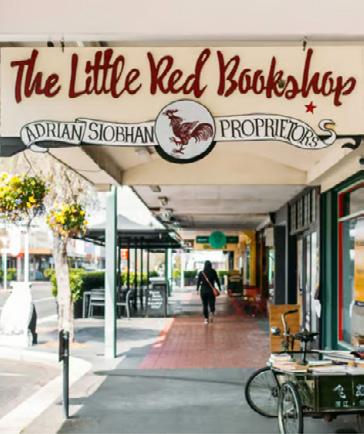



Hastings’ worst kept secret, The Little Red Bookshop is an absolute treasure trove of books, vinyl records and board games. Every wall is lined with bookshelves teeming with pre-loved books of every variety - fiction, travel, kids, autobiographies - what they don’t have is simply not worth reading. As Neat Places so rightly put it recently, “A visit to The Little Red Bookshop is a chance to journey down memory lane, embrace your inner bookworm and come away with a find or two”.
Hastings’ worst kept secret, The Little Red Bookshop is an absolute treasure trove of books, vinyl records and board games. Every wall is lined with bookshelves teeming with pre-loved books of every variety - fiction, travel, kids, autobiographies - what they don’t have is simply not worth reading. As Neat Places so rightly put it recently, “A visit to The Little Red Bookshop is a chance to journey down memory lane, embrace your inner bookworm and come away with a find or two”.
8 BUSINESSES THAT FLY UNDER THE RADAR, THAT YOU NEED TO VISIT ASAP.
COCO & CO
THE NAKED JEWELLER
THE LITTLE RED BOOKSHOP
COCO AND CO | 240 Heretaunga Street East
An independent, not for profit retail store, nestled into the heart of Hastings, Coco and Co promotes and sells beautiful products made by craftspeople throughout New Zealand. Stocking clothing, accessories, homewares, giftware and even handmade kids costumes, this is the ultimate store if you’re looking for something unique to give to someone, or to yourself. Staffed by volunteers this store is a fabulous supporter of home grown talent creating one of a kind pieces.
THE NAKED JEWELLER | Cnr Russell and Eastbourne Streets

The immensely talented team at The Naked Jeweller create bespoke, show stopping pieces that are made to the absolute highest standard. With a combined experience of over 100 years, the team love to make, repair and rework jewellery and watches, with their showroom featuring many hand-crafted one of a kind pieces. Watch the jewellers melting, forging, cutting and polishing as you browse the gorgeous products - it is a fascinating process.
Disclaimer: you will not find any naked jewellers in this store (we think).
F.W. LILEY | 312 Heretaunga Street West
If you are looking for a gift, or to update your dinnerware, F.W. Liley has you covered. Their store is absolutely packed to the rafters with whiskey glasses and decanters, crystal vases, bunnykins plates, knife sets, wine glasses, high tea stands, salt and pepper shakers and anything else you could possibly ever need. If you love beautiful things, you’ll love this store.

HOLY CREPE | Bay Plaza, 221 Russell Street North
Oh la la! The newest addition to Bay Plaza, Holy Crepe, is serving up authentic french crepes seven days a week to hungry visitors. With flavours such as nutella and banana for the sweet tooths, and ham, egg and cheese for the salty soldiers, the crepes are reasonably priced and are perfect for little ones and big ones alike.
SHANEOS BAKE HOUSE | 302 Hastings Street South
Now, being good Hawke’s Bay locals, we like to think of ourselves as meatball aficionados (if you don’t know what a meatball is, clearly you are not a true Hawke’s Baylien), there’s very rarely a meatball we don’t like but we’ll tell you what, we’ve done the legwork and Shaneos meatballs are the best in the Bay. Located in the little corner site by Harvey Norman, this bakery offers up the tastiest pies, the most moorish donuts, freshest sandwiches and strongest coffee that you could ask for. It is a must visit, run - don’t walk.
ASIAN SATAY NOODLE HOUSE | 106 Market Street North

A stalwart of Hastings dining, Asian Satay Noodle House has been serving delicious Asian food to hungry customers for upwards of 20 years. It’s simple interior and generous portions, at prices that won’t break the bank keep customers coming back time and time again. Don’t forget to pack your appetite when you visit though - you’ll need it!
MP FOODS | 212 Saint Aubyn Street West
Take a trip around the world’s cuisine at MP Foods. Stocking products from every corner of the globe you can discover all manner of flavours, products and meal ideas just from a simple wander around this Alladins cave of cuisine. Find bulk items, hard to find ingredients and even delicious international sweet treats all under one roof. Your at home cooking will never be the same again.
 F.W. LILEY
ASIAN SATAY NOODLE HOUSE
F.W. LILEY
ASIAN SATAY NOODLE HOUSE
ADVERTORIAL
MP FOODS
Modern Bathroom
Englefield is dedicated to delivering marketleading products. This is completed with the ease of installation and best in class aesthetics, operation and feel. For example, with easy installation and great design features, the beautifully engineered Valencia Elite shower creates a modern, clean and uncluttered look, inside and out.

Bathroom furniture plays an important storage role as well as making a visual statement. All Englefield vanities are available in classic white and most are also available in two attractive ‘timber look’ finishes.
Tapware and bathroom accessories are the most used fittings in your bathroom. Just changing the accessory is a simple and affordable way to give your existing bathroom a new look. Coordinate all the tapware with any of the Englefield accessory range in your bathroom for a seamless design.
Invсt in Quality, Beauty & Functionally
Holders Plumbing Plus is dedicated to ensuring our customers are shown the best quality products, for a great price and with spectacular service. Ellison Road, Hastings hosts our beautiful Boutique Villa Showroom which is located just behind our drive thru trade store on Warren Street, Hastings. Here you will find our young vibrate Zoe who is super enthusiastic about creating spaces that you’ll love! Further to this, Holders hosts the largest bathroom showroom in Hawkes Bay, which is located on Taradale Road in Napier. Sarah is located at this store and she comes with a history in selling Bathware overseas and is extremely passionate about achieving your new dream space!

Make sure you head into one of our showrooms, meet the team and get inspired for your next project today!
Open Monday to Friday, 9am til 4pm and Saturday 9am til 12pm 302 Ellison Road, Hastings or 118 Taradale Road, Napier
Englefield is available to view and purchase through our showrooms

O L D E R S PLUMBING SUPPLIES | BATHROOM SHOWROOM
BATHROOM
H
KITCHEN |
| LAUNDRY
Pictured: Valencia Elite shower, Studio II Bath, Valencia Vanity, Evora Toilet Suite and completed with Studio Pin tapware
Life
Whāia te iti kahurangi ki te tūohu koe me he maunga teitei –Congratulations to the Kahurangi NZ Māori Dance Company as it takes to the stage for its 40th year.
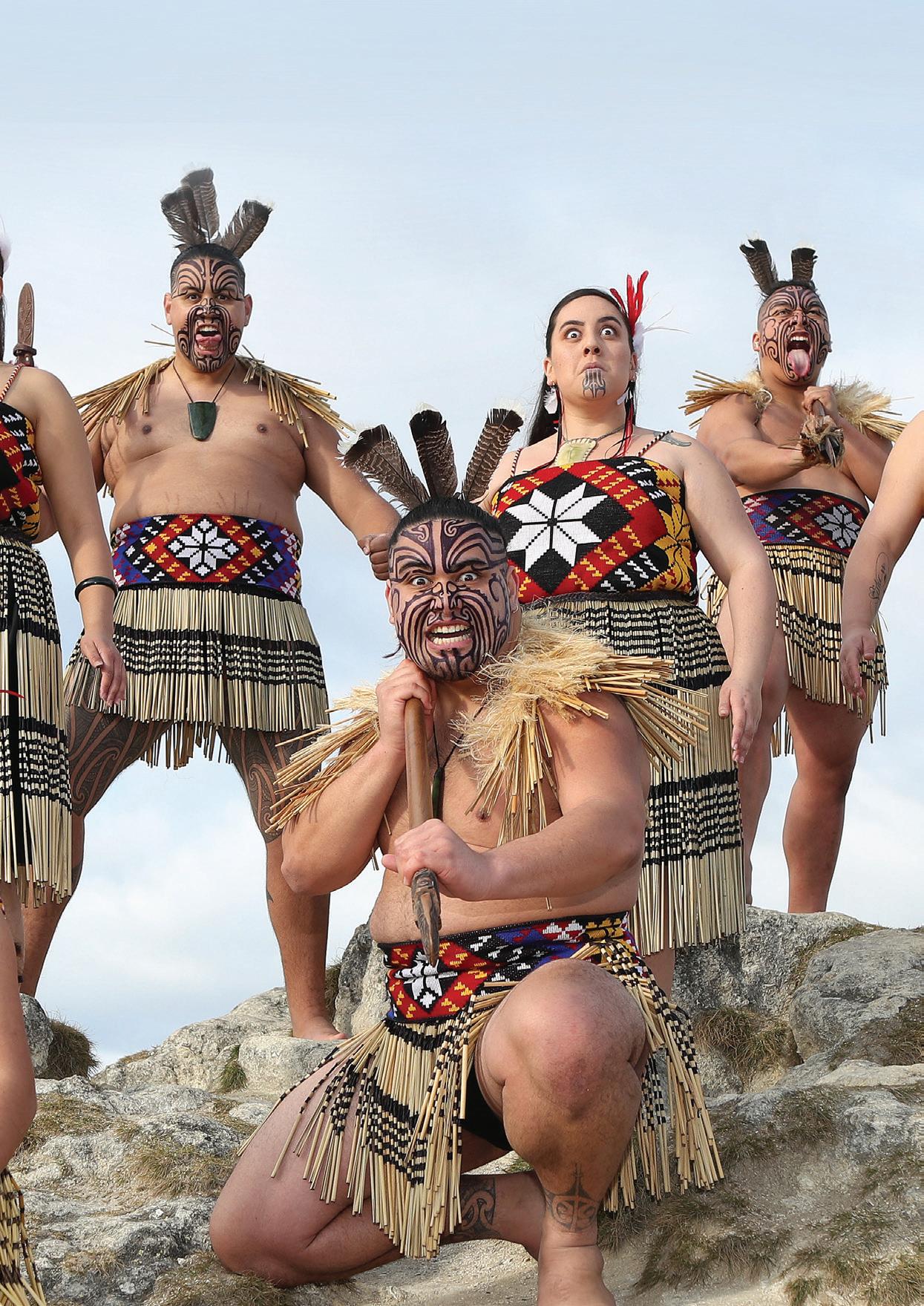
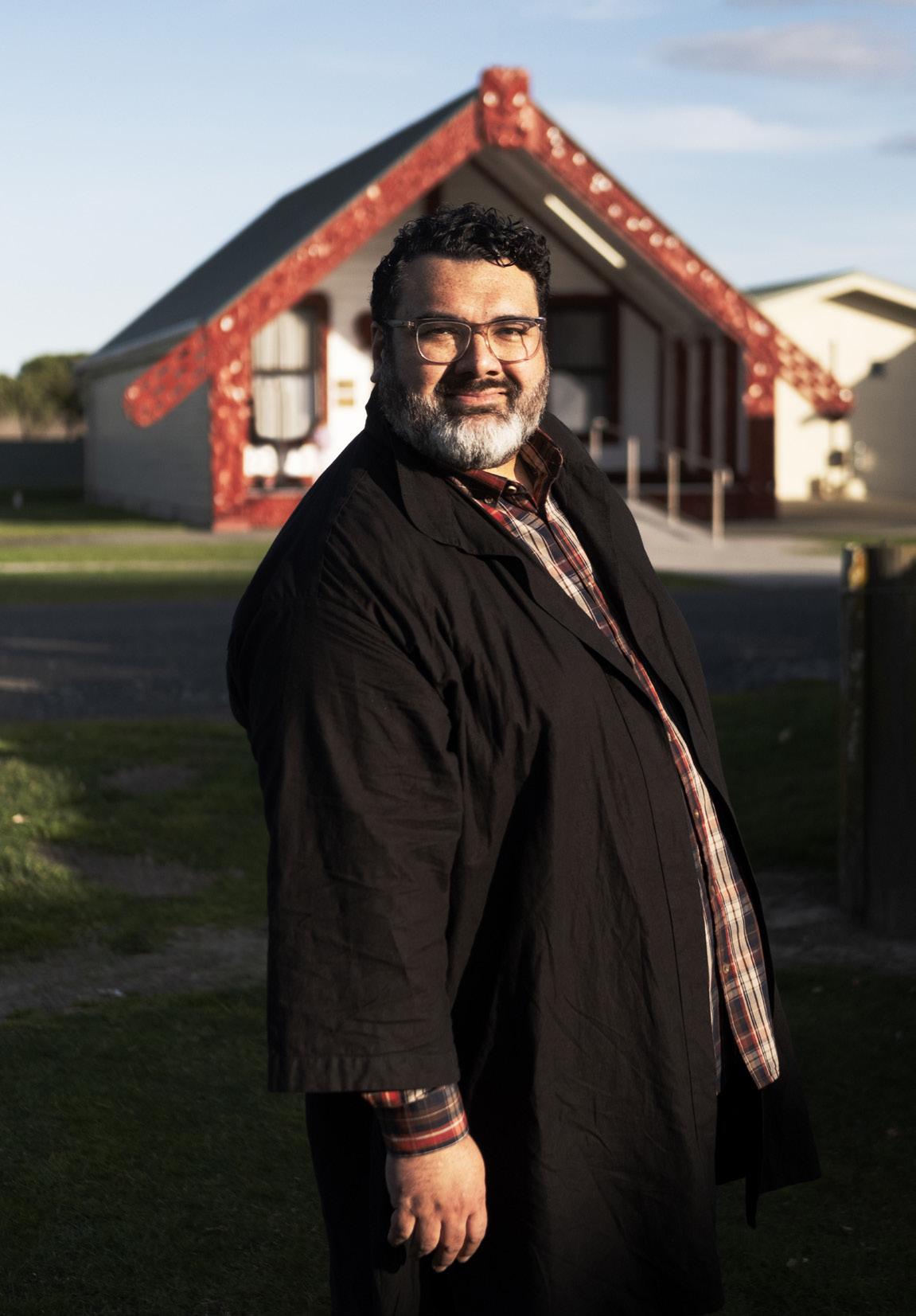
Life Michal McKay
BUILDING BRIDGES –KI TE HANGA PIRITI
This ancient Māori whakatauki calls for everyone to come together and share their collective strengths. Strengths that form a powerful bond that will realise extraordinary outcomes. And – most importantly – outcomes accessible to all.
Story Michal McKay
This is the mantra of the ninth Hawke’s Bay Arts Festival.
And exemplifies its underlying message woven by the strands of the fifteen days of performance art as it takes you on a journey of culture, discovery, and upliftment ... one richly bestowed with Polynesian talent.
That underlying message has much to do with having the advice of a Pou Ārahi.
A Pou Ārahi provides a bridge between two cultures; his or her focus is on embedding Te Ao Māori values and encouraging the use of Te Ao Māori, fostering an organisational culture that promotes inclusion, cultural competence, strong ethical practices, and accountability by providing expert cultural advice.
Used now in many and very widely diverse areas, ranging from business to education and even the Department of Corrections, Hawke’s Bay is also one of three key trial areas that are part of a four-year programme based on the philosophy of Pou Ārihi.
Meet Howard ‘Howie’ McGuire
Howie is the Pou Ārahi for Arts Inc. and the ninth Hawke’s Bay Arts Festival. He came to Arts Inc. literally by osmosis. Mere Boynton who is well versed in all things Toi Māori, had been helping both Pitsch Leiser, the festival director and Andy Heast, chair of Arts Inc.
Howie recounts, “Pitsch and I spoke some years ago about becoming a part of the Festival and I was really interested – then Mere Boynton moved here, and she was the absolute right fit for the festival ... We knew each other from Wellington days, and I had worked with her. Then Mere moved on and Pitsch got in touch, and I started adding Kaupapa Māori in subtle ways to the festival. It was really to ignite that Māoridom space – that’s what makes it so special and provides another perspective.”
Pitsch and Andy are responsible for the production of the festival – and conscious of the importance of community appeal. Obviously, they have a strong vested interest in the festival’s outcomes; their concerns being not only talent and performance but that those performances draw the crowds. There
is also the underlying issue of ensuring the subtle principles of anything related to Māoridom are adhered to.

“I’ve always been a fan of Pitsch’s programming, even though he is not from here, he just seems to instinctively know. And Andy too. They both have these inbuilt antennae. But there are still some sensitivities that only someone who has been brought up in a marae/Te Ao Māori would be aware of and it is my job to ease those out.
So, what is the experience that makes Howie such an able contributor to the Festival?
Entertainer and entrepreneur
Howie’s talents lie in the broad structure of musical entertainment. He has a beautiful voice, so he plotted his career path to be in performance art, with care. “A career as a soloist singing at events put on by corporates means you need your wits about you,” explains Howie, who has had great success in his chosen direction. Whether it be a solo performance for a select and small group of customers or a big event, contracts are detailed “and for those I too have to be savvy about the business end,” he continues. “So,
“Nāku te rourou, nāu te rourou ka ora ai te iwi.”
“With your basket and my basket, we will thrive.”
Howie McGuire at Kohupātiki marae.
September + October 2023 BAYBUZZ 71
Photo: Florence Charvin
my experience has been not only in the musical area but also very strongly involved in the business side.”
The festival mission is to entertain, uplift and educate – the added value of having someone on board who understands finance is that the tills at the end of the day need to ring. And ring. “And having that extra string to my bow is valuable.”
Howie’s beginnings were typical of the Māori way of life. “I was born and raised here – my mother is from the Kohupātiki marae down the road from Pākowhai on the lower reaches of Te Awa o Mokotūāraro. Its principal hapū is Ngāti Hori of Ngāti Kahungunu. Dad is from Ngati Porou and Rongowhakaata.
“As a child most of my days I spent on the marae with my Kuia, her daughters - my mother and her sisters - who all ran a tight ship. What can I say, I come from a matriarchal whānau everything was polished by hand, floors, linen starched and flowers in crystal vases and bowls adorned with pūhā, karengo (seaweed), pātiki (flounder) and on the odd occasion tītī (mutton bird), and fresh rēwana with real butter.
“Music was a huge part of my life. My mother and my grandmother sang in the Heretaunga Māori Choir.”
(Another great musical export of Hawke’s Bay, they travelled internationally during the 30s & 50s.) “They both played the piano as did my older brother and younger sister.” (He is one of four siblings.) Then there were the many aunties and uncles who played both the piano and the guitar.
Ready to sing
“My music theory training started at high school; performance started with kapa haka on the marae and then school. But singing is my area of the music world and naturally I was in the school choir and played in school bands and school musicals. Following on from school I went to EIT where I completed a Diploma of Performing Arts Voice. From there I went to the Conservatorium of Music (now NZ School of Music, Te Kōkī) in Wellington where I studied performance majoring in voice. All in all I spent five years focusing on music and after Uni – I was ready to sing!
Like most singers Howie joined the local choirs, New Zealand Opera for a while, Gilbert and Sullivan Society, and performed as a soloist with Orchestra Wellington on occasions. And during this period, he
was fortunate to be introduced to an exceptional group of musicians within the orchestra. “Each of us hailed from diverse cultural backgrounds and this experience played a pivotal role in shaping my musical aspirations. Not only did it deepen my comprehension of musical genres but also expanded my reverence for the language of music – that transcends boundaries,” he comments with feeling.
“When I look back at this experience some twenty odd years ago, at the very core of it is waiata Māori (māori songs I had grown up singing) but what made this more exciting was I was being me, with an operatic voice, singing waiata Māori with a string quartet and a percussionist. I was preparing myself for a career as a freelance singer catering to anyone who needed entertainment.”
The business side
Howie was aware, however, of the need to be prepared from a business perspective if he expected to make his career in the music world.
Like most students, throughout his studying he took on casual jobs. One that was to have a strong influence was with Westpac Stadium working in hospitality – “a pretty big organisation which was the ideal package for me if I was to be in that world.” The Westpac Stadium was to be a stable passage of work for him for about seven years. During that time – while working his way up the ladder – he was also studying and came away ‘with a piece of paper’. Namely a graduate diploma in business management.
That path he plotted also included hospitality. “Well, think about it – if you are singing for a corporate’s special event, guests need to be well hosted – so ‘wining and dining’ included the
crème de la crème - I did get involved in that and I learned a lot from it.”
He moved into a role in hospitality at Te Papa Museum, at that time involved with the world premier of Lord of the Rings –“putting out the red carpet for the world stars was something else – Liv Tyler, Elijah Wood, Viggo Mortensen, Cate Blanchett, Ian McKellen, Orlando Bloom, Hugo Weaving were part of the ensemble cast – a lot of stories I could tell about that time!” he laughs.
That was before he returned to Westpac, which had been taken over by a new hospitality company “and the new general manager was an old colleague. I became Corporate Hospitality Services Manager –and I really learned the ropes – that kind of training stretched my accomplishments within the arts world. I learned how to produce shows and establish professional connections with clients in a business-oriented manner.”
His journey encompassed participation and performance in events like the NZ Arts Festival, along with serving as an Events Contractor for Wellington City Council’s community initiatives. Following his tenure at Westpac Stadium, Howie took charge of a small functions and events venue, which later became the host for the NZ Jazz Festival.
With over twenty years dedicated to studying and working in Wellington’s arts, hospitality, and events sector, you can imagine the wealth of experience that comes with it.
“And all the time ‘singing for my supper.’ Not always opera – waiata, Gilbert and Sullivan, jazz ballads, Italian and Russian folk songs, German and French arts songs.”
“I learnt what made a festival look and feel good. Caring for the artists so they feel valued is another point. When you are performing you give it your all – so it is important to show that you appreciate that.”
Just as the Cook Islanders are known as the entertainers of the Pacific, so the region of Hawke’s Bay has a reputation for its communities being great entertainers. “Hastings in particular is recognised for its entertaining with performance art at the centre,” Howie reveals. “Our mana whenua is the foundation. We just know how to entertain.”
And indeed many label Howie ‘a born entertainer,” and will vouch for his many talents.
Now that experience is being tapped by the Arts Festival.
Having met up with Pitsch when the first festival was in its infancy, “even then he and Andy knew well that a regional festival had to reflect the spirit of their community. And what it has become is truly of international standard. But even so there is a need every year to draw people with new thinking – we need to broaden our horizons – and that is
“It is wonderful to be working with Howie implementing Tikanga* into the organisation as I am currently studying, He Papa Tikanga through Te Wānanga o Aotearoa.”
Rachel Chapman, marketing and communications manager, Hawke’s Bay Arts Festival
*Tikanga (engaging in a tikanga process involves having more robust conversations with Māori leading us through the process)
72 BAYBUZZ September + October 2023
where I can help. It is now not only Māori talent that needs to be tapped but there are so many different races and creeds living here – so my thinking must not only be about Māori, but also how that inter-relates with all the others.
“Making sure the shows are appropriate for our community is another responsibility,” he continues. “Some of the more ‘Avant’ shows particularly. They can be controversial and my job is to be the cultural curator. For example some of the language can often be misconstrued – and we need to be quick to correct that.
“Really, my role involves working closely with mana whenua and our artists to help inform how we as an organisation move forward together for the benefit of all involved, shaping both our direction and our collaborative approach.”

HOWIE’S PICKS
Given his particular involvement with the many Polynesian artists who will be playing such a strong role of their own during the Festival –obviously what Howie would suggest is of great interest. Here are his recommendations.
Kahurangi!
Ahakoa He Iti, He Ponamu!
The 40th anniversary celebration of the life works of Kahurangi NZ Maori Dance Company and its founder Tama Huata respected Te Matau-a-Māui arts identity. As Howie points out – “This is a top-grade international company. We should be so proud of their talent and skill. They were the first professional dance company to go overseas and be recognised. And they paved the way for all - plus their contribution to tourism in New Zealand is so valuable. Their company really opened the curtains for
Māori culture and Tama himself was part of a legacy he gave to Hawke’s Bay. This is a show which cannot be missed.”

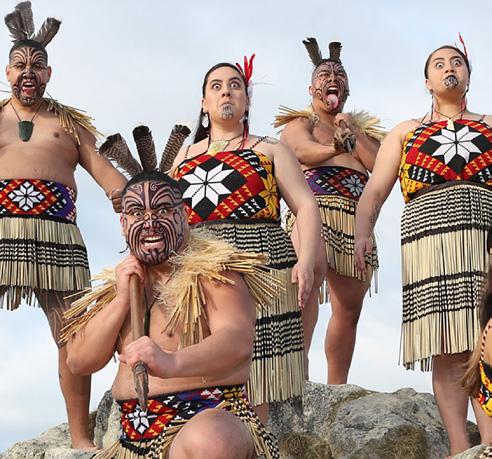
UPU
Borders disappear and for just over an hour, the theatre becomes a sea of islands. Be transported across an ocean to hear the voices dealing with colonisation, family, climate change, love, sex, religion, power, and tourists.
“Curated by award-winning poet Grace Iwashita-Taylor and led by powerhouse director Fasitua Amosa. UPU is for the trailblazers,” says Howie, “and performed by a stellar cast of some of the best Polynesian actors in Aotearoa today.”
Ko Au: Malosi
A powerful collaborative piece directed by Seidah Tuaoi and Joshua Mitikulena; plus, South Auckland’s Street dance and dancers from the USA and Australia. This is their second time
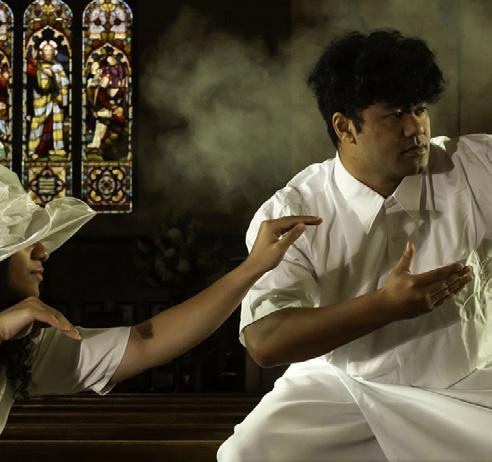 CLOCKWISE FROM TOP LEFT: Kahurangi! Ahakoa He Iti, He Ponamu!; UPU; Ha-Wai-Ki-Nui; Ko Au: Malosi.
CLOCKWISE FROM TOP LEFT: Kahurangi! Ahakoa He Iti, He Ponamu!; UPU; Ha-Wai-Ki-Nui; Ko Au: Malosi.
with the festival. Exploring the notion of strength from a New Zealand born Samoan perspective within the context of living in Samoa. “This is an exploration of cultural identity and honouring the land on which we stand.”
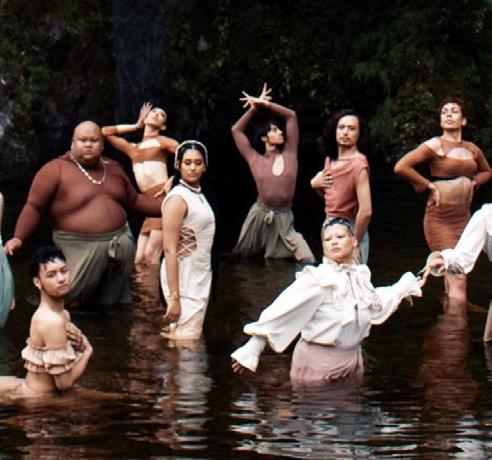
Ha-Wai-Ki-Nui
Created as a response to the cyclone. It is free and a ‘must be seen’.
“Getting the balance right in a festival means creating a future audience – this is it. A selection of 30 local national and international artists have created painting, sculpture, weaving and mixed media to be explored and contemplated as we reposition our thoughts about water.”
Gráda
Traditional Irish music influenced by jazz, folk, world, and Americana – the
band has toured extensively with headline performances at multiple European and American folk festivals. And includes members from Ireland and New Zealand.


“Every festival there is one that stands out – this is it,” comments Howie.
When Poetry and Song Collide
It has been said that music is poetry of the air, and that poetry is music. This is the story of the magic that happens when poetry and song collide.
From Howie’s perspective – “Kids love poetry – And this is from the best. James K Baxter, Hone Tuwhare, Witi Ihimaera and Katherine Mansfield.”
Arawhata!
A joyful celebration of diversity, Wellington Ballroom brings a one-ofa-kind show capturing the essence and experiences of queer, indigenous people of colour fusing the art form of underground ballroom with the
cultures which flow through the performers’ veins.
A winner of several awards “this is a special kind of entertainment which has come out of the Wellington scene and is pretty colourful.”
Theia X Te Kaahu –Girl In A Savage World Singer, songwriter Theia is fresh from touring the United States and Canada and also winner of the Taite Prize for Best Independent Debut with her album Te Kaahu O Rangi Theia. She presents songs from the alt pop album alone with dreamy waiata from her award winning project Te Kaahu.
Billboard magazine labelled her as ‘one of the most exciting voices in pop to emerge from New Zealand in the last five years.’
The Hawke’s Bay Arts Festival runs from 13-29 October www.hbaf.co.nz

74 BAYBUZZ September + October 2023
CLOCKWISE FROM TOP LEFT: Gráda; When Poetry and Song Collide; Theia X Te Kaahu – Girl In A Savage World; Arawhata!.


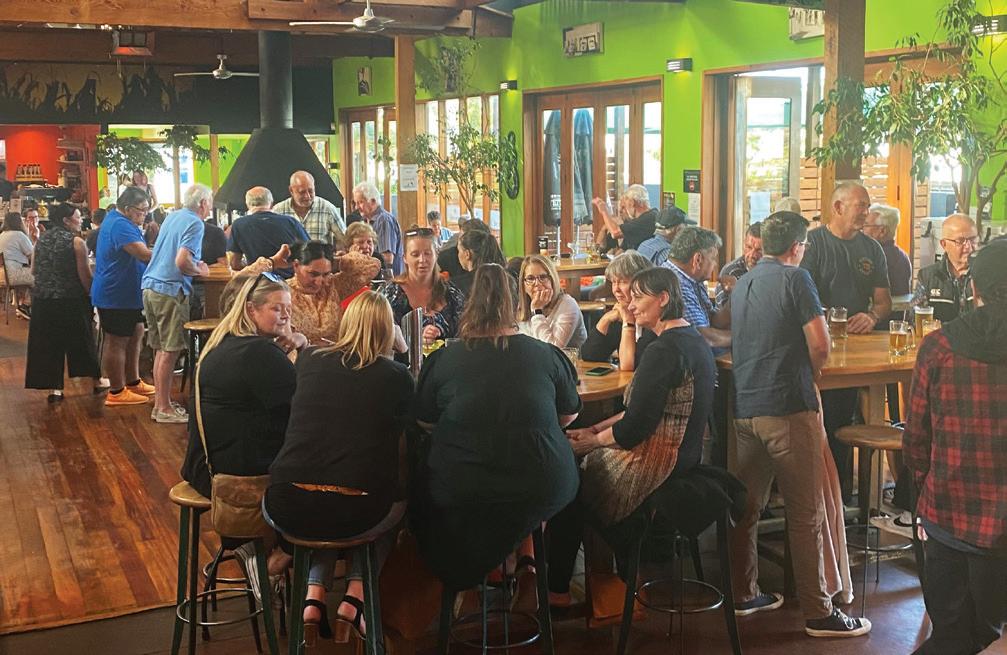

A L E X A N D E R S A P P A R E L H A S T I N G S H E R E T A U N G A S T W E S T H A S T I N G S A L E X A N D E R S A P P A R E L . C O . N Z V A S S A L L I W O M E N S N E W S P R I N G / S U M M E R C O L L E C T I O N N O W I N S T O R E
Open Tuesday to Saturday
Hours may
holiday
of the $17 lunch and other great
JARKS RESTAURANT & BAR, 118 Maraekakaho Rd, Hastings • Ph 06 870 8333 • JARKS jarks.co.nz
From 11am for lunch & evening service Bookings recommended
change through
periods Home
deals
Life Books / Lizzie Russell
Listen up, readers …
Alongside the Hawke’s Bay Arts Festival sits the Hawke’s Bay Readers & Writers Festival. As ever, this year HBRW offers a line-up that promises to surprise and delight, educate and inform.
Here are some expected highlights, which sit amidst a strong programme of 11 events over one weekend (October 27-29).
WILD LIFE
Big moment for fans of RNZ’s charming Critter of the Week programme! Jesse Mulligan chats to Forest & Bird CEO Nicola Toki in the flesh, about developing a love for and engaging with our natural environment at any age.
Saturday, October 28, 2pm at the Havelock North Function Centre
THERE’S A CURE FOR THIS
Dr Emma Espiner (Ngāti Tukorehe, Ngāti Porou) retrained as a medical doctor from 2015 (just in time for youknow-what), having built a career as a writer, broadcaster and commentator. Here she talks with Ockham NZ Book Award Winner Noelle McCarthy about her candid and thoughtful memoir, There’s a Cure for This. The pairing of these two writers is particularly deft, given Noelle’s stunning 2022 memoir, Grand: Becoming my mother’s daughter Friday, October 27, 8pm at the Havelock North Function Centre

NEW VOICES

If you’re interested in the up-and-comers of the Aotearoa literary scene, this is one discussion worth getting to. The stellar line-up consists of Josie Shapiro (winner of the inaugural Allen and Unwin Commercial Fiction Prize for her debut novel Everything is Beautiful and Everything Hurts), Nafanua Kersel (Faleālupo, Malaelā, Mosula, Satufia, Tuaefu, winner the 2022 Biggs Family Prize in Poetry), Airana Ngarewa (Ngāti Ruanui, the big winner in the 2022 Ronald Hugh Morrieson awards) and Whiti Hereaka (Ngāti Tūwharetoa, Te Arawa, Tūhourangi, Ngāti Whakaue, Ngāti Tumatawera, Tainui and Pākehā, 2022 winner of the Jann Medlicott

Acorn Award for Fiction at the Ockham NZ Book Awards). Entry is by koha, but you must reserve seats.
Saturday, October 28, 4pm at Flaxmere Library
PECK-CHA-KUCHA
Catherine Chidgey’s novel The Axeman’s Carnival is narrated by a magpie. Poet and author Marty Smith adores and has cared for two special baby magpies in recent years. The prospect of a conversation between the two of them has that perfect mix of inevitability and bird-like mystery.
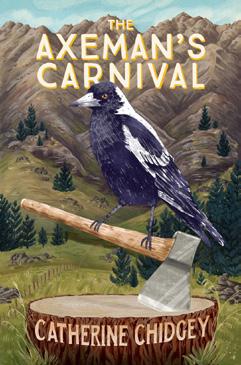
(Also, Hawk-eyed Instagram watchers may have spotted Sarah Jessica Parker’s snap of Catherine’s latest book, Pet on her stories … She’s made it!)
Sunday, October 29, 2pm at the Havelock North Function Centre
To book tickets and for information on all HBRW events, see hbaf.co.nz
76 BAYBUZZ September + October 2023
Have you been wondering what those big tanks in Hastings are?
Discover Waiaroha with guided tours, entertainment, hands-on activities for all ages and more. All free!
Waiaroha opening weekend Sat 7 and Sun 8 October
Corner Southampton Street East and Hastings Street South
 Story by Rosheen FitzGerald
Photos by Florence Charvin
Story by Rosheen FitzGerald
Photos by Florence Charvin
ARTIST BEN PEARCE, ENABLED BY ARA TRUST
Every artist dreams of being able to turn their passion into a viable career. Creative practice is typically motivated by love, not money.
The few artists who do attain the ability to support themselves with their work put in years of hard slog, side hustles and straight jobs. Along the way they may be tempted to compromise creative integrity for commercial success – to produce work that appeals to an affluent audience rather than that which authentically reflects their artistic heart.
To combat this problem local philanthropists and art aficionados, Jenn Kight, Bry Mossman, Mary Stewart and Lyn Williams, founded the ARA Charitable Trust with the goal of Assisting Regional Artists in Heretaunga and Tairawhiti. They solicited (tax deductible) donations of $1,500 apiece from twenty art lovers, to crowd fund a living wage of $30,000 awarded to a single local mid-career contemporary artist annually, to alleviate financial and time pressures and allow them to create freely.
Donors form a club of sorts, meeting regularly to engage in events of artistic appreciation. They are invited to visit the artist’s studio, to a lecture event, and are given a private preview of the body of work created in the year of residency with first rights of purchase.
The Trust took nominations from galleries, with final selection by independent curator and former director of Porirua’s Pātaka Art + Museum, Helen Kegley. Her choice for the inaugural award was Napier-based sculptor, Ben Pearce.
Pearce creates compulsively and vociferously,
having maintained a consistent exhibiting schedule in the twenty years since he graduated from Whanganui Quay School of Fine Arts. His work is in constant evolution, his practice and its product changing and developing as he grows both as a person and as an artist.
The unifying factor running throughout is the strange unsettling sense each piece leaves with the perceiver. They act less as discrete artworks in the service of beauty than inner mirrors, depicting the odd landscapes of the mind. Pearce plays with perception, memory and emotion, almost daring his audience to leave the safe spaces of that which they know to be true in favour of an imagined world of possibilities.
Pearce is an artist who refuses to be confined by scale, material or genre. His graduate project, Boris Bing, was a wearable performance piece, the costume a conglomerate of beloved stuffed animals and road kill, part adorable, part terrifying.
His installation, Life Will Go On Long After Money, recreated at 75% scale the ramshackle dwelling constructed in Nelson, which Pearce ended up claiming as an artwork, though it began as an honest attempt to opt out of an increasingly unliveable society. As part of its tour, the piece was installed in the Holt at Hastings City Art Gallery, accompanied by a poignant looping video, further immersing the viewer in the experience.
The ARA grant is by no means the first time Pearce been awarded. He was shortlisted for a Wallace award, and won one of their People’s Choice Awards for the first of his Caverns series — small wooden works, fierce on the outside, inviting on the inside. Great Grandfather Clock, an improbably proportioned piece acquired for MTG’s permanent collection, won the 2009 Waikato Youth Award. Mergar, a composite of blackboard, acrylic and walnut, speaking to transformation, won the Molly Morpeth Canaday prize in 2014. Stone Age Eight Gauge, a series of imagined
September + October 2023 BAYBUZZ 79
He already had a backlog of five commissioned works to get started on. Some clients had been waiting a year for their pieces. A megalith in corten, reminiscent of a futuristic Stonehenge, is partially assembled on his studio’s covered deck, waiting to take its place in a private residence.
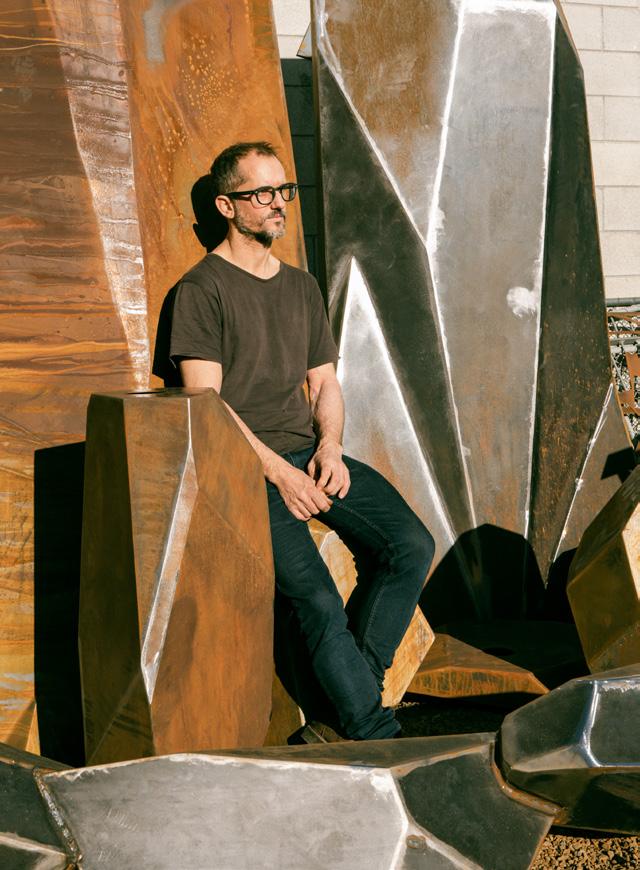
relics, won the Number 8 Wire Award in 2016, recognising works made from this most colloquial of materials. Acclaimed collector Warwick Brown included Pearce in his list of 100 New Zealand artists to watch, Seen this Century, testament that his work will only increase in value.
Last year his work was chosen by Wellington Sculpture Trust to fill the four plinths on the waterfront outside Te Papa. The series, #Paper Pals Aotearoa –oversized colourful origami animals rendered in metal – display a playful childlike wonder, while simultaneously posing environmental questions.
All this Pearce achieved while working Monday to Thursday at David Trubridge’s Whakatū workshop, leaving only Fridays during the school day to focus on his own artwork. “It was a really stressful state to be in,” he remembers, “I had all these opportunities ahead but I couldn’t really take them up … I was just starting to get a more consistent showing. Works were just starting to sell but not enough to have more than a day off.”
The direction Pearce’s practice has taken of late – working primarily in metal, cutting and welding together pieces of corten steel – exacerbated the problem. A large scale piece could take half a year of careful saving to invest in materials, and the acetylene gas required to weld them together. For a solo show, the investment could be close to $30,000 on materials alone – the total sum of the ARA grant. Add to this rent on his Omahu Road studio space, insurance, freight –around $1,000 to ship a single piece to the South Island – and the ever growing cost of raising a young family. As talented and recognised as he was, Pearce simply needed the job with Trubridge to stay afloat.
The day the first instalment of the ARA grant landed in his bank account Pearce handed in his notice with Trubridge, not without regret. He credits the seventeen years spent working there as “a big
part of evolving my brain”. Yet he was mindful to make the most of the opportunity the grant gave him. “I hit the ground running the day I left,” he recalls.
He already had a backlog of five commissioned works to get started on. Some clients had been waiting a year for their pieces. A megalith in corten, reminiscent of a futuristic Stonehenge, is partially assembled on his studio’s covered deck, waiting to take its place in a private residence. Creating site specific pieces is a process Pearce enjoys, working with clients to make something that speaks to their space. He is sometimes approached by art consultants, who source or commission works for galleries or homes. The often arduous and nail biting installation process has allowed him to be inspired by the homes of those who own his work.
Galleries are his other major clients. Pearce is represented in Hawke’s Bay by Hastings’ Parlour Projects, alas temporarily without a bricks and mortar space. The gallery’s keen-eyed curator, Sophie Wallace, nominated him for the ARA grant, and has cast a watchful eye over his transition to full-time artistry, advising and analysing.
For the last five years, Dunedin’s Milford Gallery has shown Pearce’s work. It’s a connection he values, appreciating the care and attention with which they represent him. He feels the sparseness of the South Island environment suits his style. “Big sculptures
80 BAYBUZZ September + October 2023
OPPOSITE: Soar takes pride of place in Annabel Toogood and Rowan Brookfield’s garden in Havelock North.
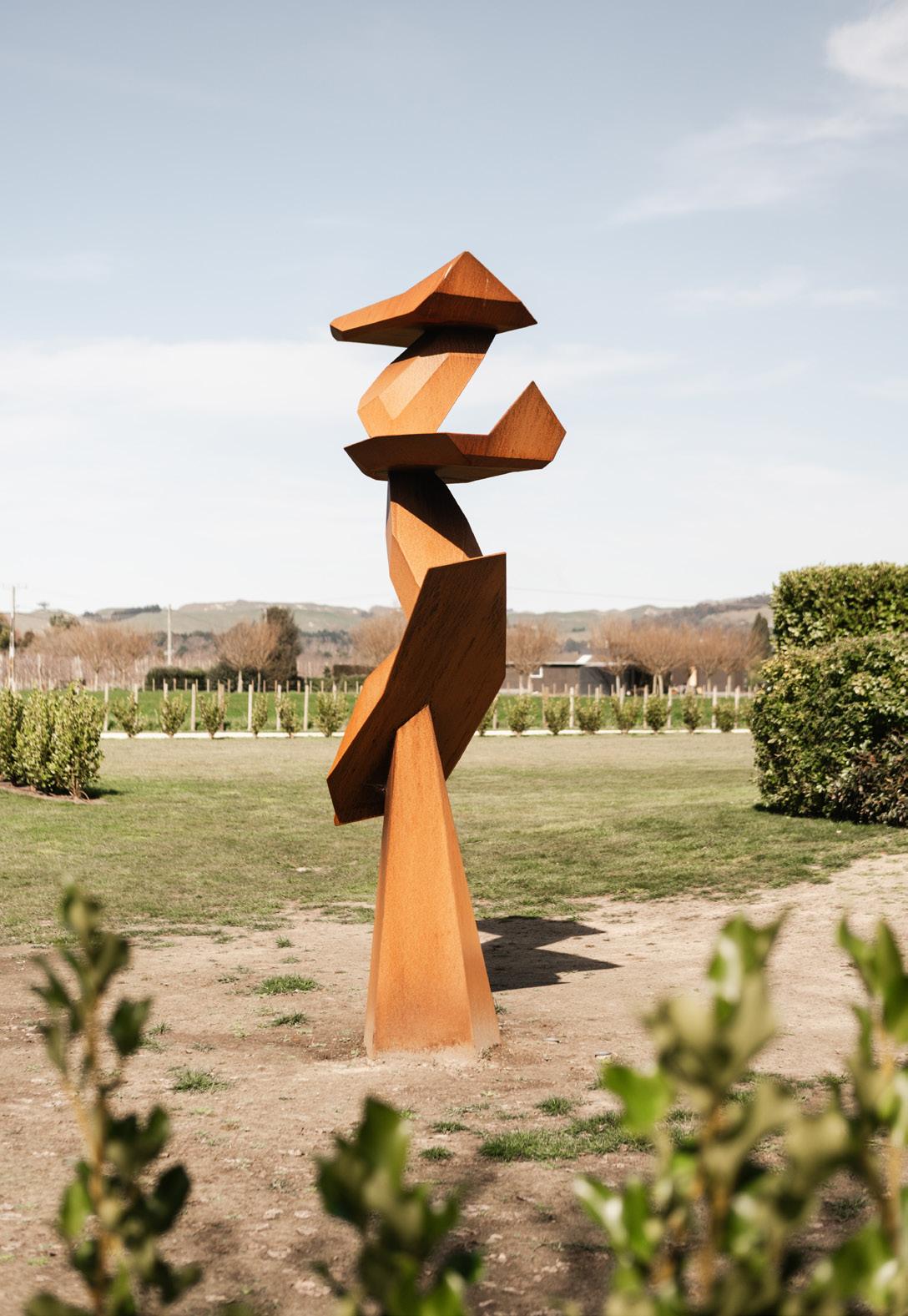
September + October 2023 BAYBUZZ 81
work against a rugged landscape,” he professes. Before the grant, though the gallery was supportive of his work, they were mindful of over promoting it because of the limits time and financial pressures put on his productivity. Once they knew he was fully committed to his craft he advanced in prominence. Several pieces feature in a group show there in September, and he has a solo show at the gallery in early 2025.
As part of the ARA residency, Pearce has produced works for a solo show here in Hawke’s Bay. Future Ancients runs for the first week in September at Black Barn’s Olive Shed. ARA gave Pearce full creative rein, asking only that their members be the first to see the new works. Relieving the pressure to create for sale has given his practice greater freedom, allowing him space to play.
Pearce has “been really pushing. There’s a lot of tension and balance in my work. Some angles feel off-putting, but together they work. I’m pushing those boundaries more. I’m playing with the inner engineering side of things where there’s hidden solid steel that makes real odd angles work.”

There’s a new boldness to these pieces, a grounded confidence. At the same time they display the
ambiguities that characterise Pearce as an artist –their solidity contrasting with the seeming impossibility of their structure. The finish too breathes life into what could be inert. It’s an alchemical process for Pearce, who says, “The works go through this cycle where they’re quite fabricated but then at the last minute once it’s all done I treat them and patina them – which takes quite a while – so they undergo a metamorphosis at the finish where it suddenly comes to life … It changes it.”
For Pearce, the ARA grant presented the opportunity to further his career and his practice in a way that, once the year is done, will make his work self-sustainable. His sales figures have doubled since going full-time and his trajectory is exponential. It’s a leap that many find daunting but the grant took some fear out of the process, leaving Pearce free to expand on his dreams.
Of the change he asks himself, “What do I want to be doing with my life eventually? I want to be making stuff.”
Future Ancients shows at The Olive Shed, Black Barn, from 1-8 September 2023.
82 BAYBUZZ September + October 2023
Breathe your best
In the cracking read – Breath: The New Science of a Lost Art – scientific journalist James Nestor estimates 80% of the world’s population is not breathing correctly. It therefore might seem ironic that most folk take breathing for granted. I mean why not? It’s the first thing we do when we come into the world and the last before we leave and unless you are gasping it is easy to overlook.
I must admit I am the opposite. I am an unashamed breathing obsessed nerd. I’ve read that many books and done a swag of breathing training. In fact, as I write this, I’m in Auckland doing a Buteyko Breathing course with
New Zealand’s leading authority Glen White. I mean how many breathing certificates does one girl need?

If I were on the psychiatrist chair it would probably stem back to a near drowning when I had just learnt to crawl and headed straight into a stream while on a picnic with family friends; only to be noticed just as I passed out by my Dad Charles, who did CPR. It was one of those family stories that came up periodically … along with the time I toddled around finishing the ladies’ cocktails.
Like many of our obsessions, I have found many avenues of exploration.
Fresh from a training with Christchurch-based Breathing Guru Donna Farhi 20 years ago, I went and nursed my Mum Beverley when she was dying with cancer and battling
for each breath. A collapsed lung and a lifetime mouth breathing affliction made each breath feel particularly precious. Coupled with that, my dear Dad was being hospitalised with asthma that had turned to emphysema which he attributed to the sprays he used on our family orchard without any protection in those days.
You could safely say that optimal breath was a family theme ripe to explore. It is not surprising that stressors and stress events are the number one contributor to dysfunctional breathing.
When I first arrived in Hawke’s Bay and taught regular yoga classes around the Bay, I noticed immediately how many poor breathers were out there. Here is the tricky thing about retraining breath to be optimal: If you tell someone
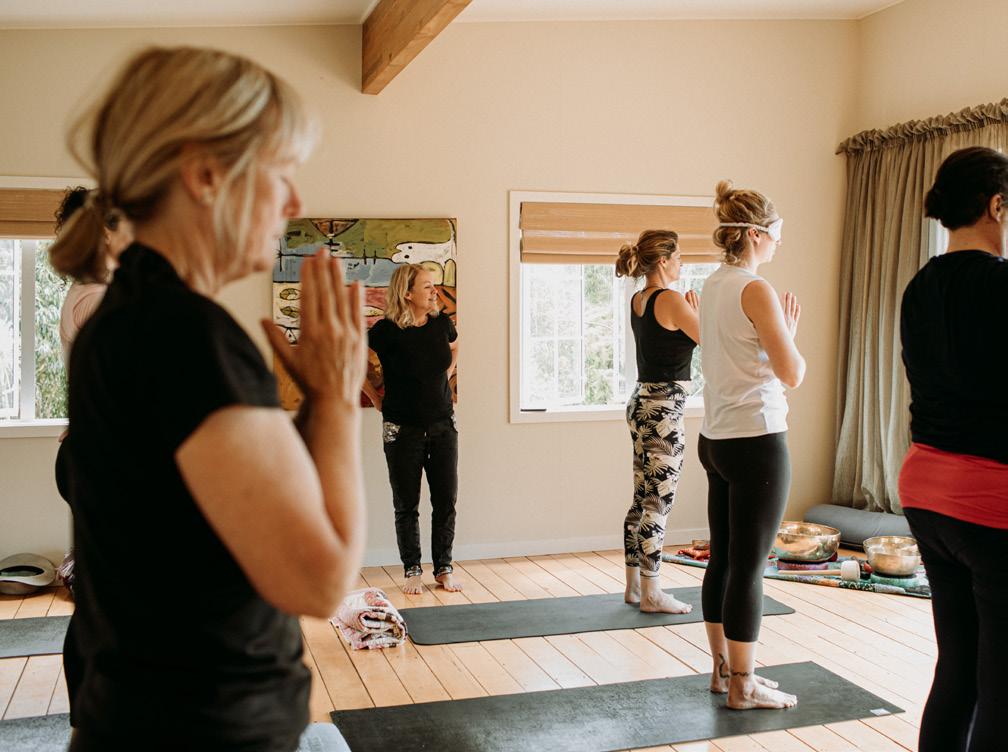
Life Wellbeing / Kate McLeay
“Here is the tricky thing about retraining breath to be optimal: If you tell someone they are breathing poorly it can make it much worse and, in my experience, harder to reset. As breathing is an involuntary process, you need to be relaxed and your nervous system in its sympathetic ‘rest and digest’ mode to retrain breathing patterns.”
since 1989
beer
they are breathing poorly it can make it much worse and, in my experience, harder to reset. As breathing is an involuntary process, you need to be relaxed and your nervous system in its sympathetic ‘rest and digest’ mode to retrain breathing patterns. And retraining breathing by not thinking about breathing can be a delicate balance.
My strategy was to quietly monitor breathing patterns of the regular students and if they didn’t improve week by week within the hothouse of the yoga room after a couple of months I would suggest that they visit Jo Eames, our legend OG Hawke’s Bay-based BradCliff Breathing Method Physiotherapist who works out of Focus Health.
Signs that you could do with some breath optimisations are vast. In the yoga room I would look for breaths per minute and keep an eye on anyone above 14 breaths a minute, also with a keen eye on the mouth breathers and upper chest breathers. Other indicators can include frequent yawning or sighing, throat clearing or coughing, shortness of breath, digestive issues, brain fog, audible breath at rest, chronic stress or anxiety, sleep issues, jaw clenching, panic attacks, frequent urination at night, postural problems, general fatigue or low energy or unexplained tension or muscle pain.
While breathing is primarily an involuntary process that sustains our life, exploring optimal breathing can indeed unlock a plethora of physical, mental and emotional benefits. From boosting energy levels, to reducing stress and improving overall wellbeing, it turns out the way we breathe can play a significant role in the quality of our life. While this fills books, classes,
courses and retreats – what are some simple ways to start?
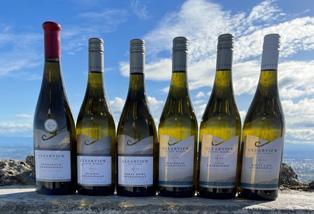
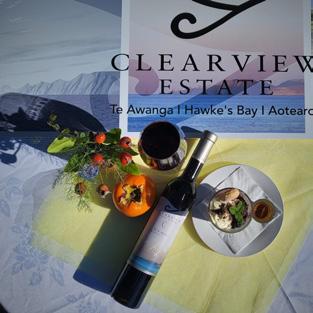

If I had to give three foundation pointers as a basis for optimal breathing, they would be:
1. Good Posture: You only need to hunch forward and check out your breath to understand the dramatic effect of posture on breathing. A posture of confidence with the essence of a smile not only boosts our feelgood hormones, but also gives our lungs and thoracic diaphragm muscle that attaches to the base of your rib cage (the primary muscle of respiration) room to do its best work. Optimal lung expansion, energy output and improved gas exchange affect every part of the body.
2. Nasal Breathing: Using your nose to breathe filters, humidifies and warms the air reducing inflammation and irritation as well as regulating volume and aiding optimal lung function. The nasal sinuses also produce nitric oxide which improves blood flow and oxygen delivery, regulates blood pressure and super charges the immune response. If you are a mouth breather then your risk of infections and viruses soars, along with dental issues, bad breath and impaired development of the jaw and facial bones.
3. Relaxation: Poor breathing patterns are often attributed to stress, whether it be a stress event or longer term mental/emotional, physical or chemical stress. It makes sense therefore that stepping out of the fray is the best place to start. The Waipukarau-based BradCliff Breathing Physios Rachel Kyle and Jane Kilmister from Plus Rehab CHB explain: “When we are physiologically relaxed more blood flows to the brain. The brain consumes 20% of our oxygen intake. Under stressful conditions this can be reduced by up to 50%.” Making restful relaxation a daily routine can go a long way to better breathing.

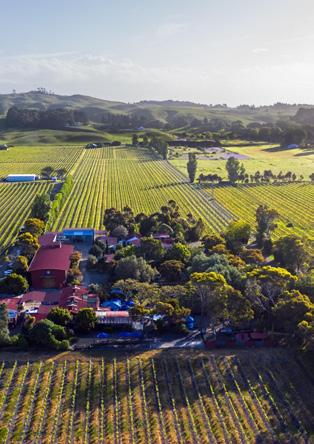
Choosing the best breathing techniques to enhance optimal breathing depends on your base line, health conditions, preferences and goals.
Here are three foundation breathing techniques to explore and unleash your potential. Start with a few minutes and gradually increase.
plates
friends & family gatherings work groups | lunch or evening menuofAotearoa open days Wed Thurs Frid Sat Sun cellar door 10am - 4pm restaurant 11am - 3pm the home of Chardonnay tutored wine tasting options on line BOOKING ahead is RECOMMENDED clearviewestate.co.nz (06) 8750150 194 Clifton Road | te awanga
coffee | lunch | wine |
platter | small
| mains
84 BAYBUZZ September + October 2023
1. Diaphragmatic Breath (aka Belly Breathing)
Engaging in low, light and slow breaths into the base of your lungs increases carbon dioxide in the blood, promoting oxygen release from haemoglobin. By breathing using the diaphragm as opposed to shallow chest breathing you can improve oxygen delivery to your cells, reduce stress and anxiety, improve digestion, enhance the immune response, potentially help manage pain and improve focus and mental clarity.
2. Brahmari Breathing (aka Humming Breath)
After breathing in through the nose with a closed mouth and the tip of the tongue resting behind your top front teeth you gently exhale through the nose making a sustained humming sound. According to Glen White from Buteyko Breathing NZ, “Humming breath leads to a 15-to-20-fold increase in nitric oxide levels helping to open up the airways and kills pathogens.”
3. Nadi Shodhana (aka Alternate Nostril Breathing)
A more advanced technique suitable if you are comfortably nasal
breathing and regularly and easily practice diaphragmatic breath. Sit comfortably upright & relaxed. Gently exhale through both nostrils then close off your right nostril with you right thumb. Inhale gently through left nostril. Close left nostril with your ring finger and exhale gently through your right nostril. Continue the pattern. This technique balances the hemispheres of the brain bringing harmony, regulating blood pressure, enhancing brain function and immune response and supporting emotional balance.
What is the hardest part of getting the best out of each breath? BradCliff Breathing Physio, Jo Eames, sums it up, “Getting people to take it on board. A lot of people want a quick fix. It takes 6 to 8 weeks with 10 minutes practice twice a day to retrain breathing patterns and if someone is not prepared to do this they will not change.”
The best news. Once you have optimal breathing as your default breath pattern you can in theory keep this with short periods of regular practice and in turn be more quickly aware when the waves of life steer you off course. Start now. Posture of confidence. Take a moment to pause. Breathe (low,
light and slow) and go forth with the essence of a smile. The best of the best exploring how to be even better.
Suggested reading:
• Breath: The New Science of A Lost Art by James Nestor
• The Breathing Book: Good Health and Vitality Through Essential Breath Work by Donna Farhi
• The Oxygen Advantage by Patrick McCowen
• How to Take a Breath by Tania Clifton-Smith
Kate McLeay runs wellness retreats including a Breathe Easy Retreat out at the iconic Cape South Country Estate and Wellness Retreat near Waimarama. She is a Reiki Master, yoga teacher and mindfulness coach.
www.katemcleay.com
Royston Hospital is pleased to sponsor robust examination of health issues in Hawke’s Bay. This reporting is prepared by BayBuzz. Any editorial views expressed are those of the BayBuzz team.
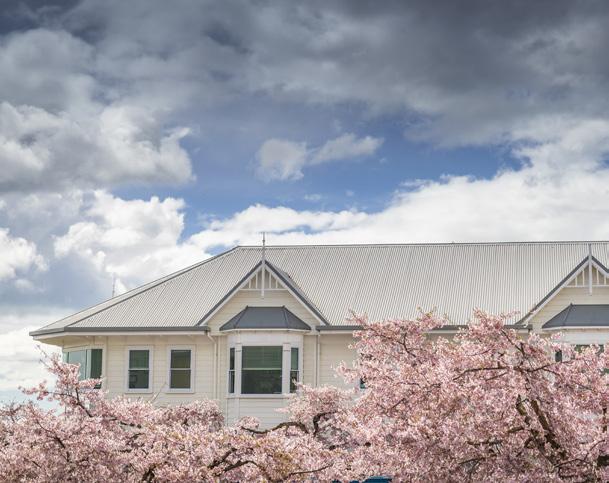

Over 100 years of exceptional care, right here at Royston Hospital royston.co.nz Evolution Healthcare September + October 2023 BAYBUZZ 85
We’re proud to be your private surgical hospital in Hawke’s Bay for over 100 years. Our commitment to you - our continuous investment to grow our hospital to meet our community needs, backed by a leading healthcare provider across Aotearoa, New Zealand!
 Beatrix from Alpha Domus with Alpha Domus Cumulus Blanc De Blanc Méthode.
Photos: Florence Charvin
Life Wine / Yvonne Lorkin
Beatrix from Alpha Domus with Alpha Domus Cumulus Blanc De Blanc Méthode.
Photos: Florence Charvin
Life Wine / Yvonne Lorkin
A SPARKLING TOAST TO SPRING
Well I’ll tell you one thing for a dollar. If anyone deserves a collective ‘raise your glasses’ this season it’s us Hawkesbayliens right?
It’s been three years of trying to catch a break, trying not to catch Covid, trying to travel, trying to do business, trying to pay our bills, trying to understand the price of cheese and the shortage of eggs. Trying to understand how our nation became so divided in terms of rabbit holes, racism and regression. Trying to avoid potholes. Trying to see life through the stressed eyes of our healthcare workers, our teachers and our kids. Throw in a deadly cyclone and it’s fair to say 2023 has been very, very trying.
Yet the sun is lifting longer in the sky, spring lambs are gambolling in the paddocks, asparagus tips are bursting through the dirt, the daffodils and freesias have already been out for ages because of, well, climate disruption. But we can see summer around the corner. And you’re reading this, that means you’re still here and you made it. Well done.
Speaking of things being made, we don’t often talk about the fact that Hawke’s Bay makes superbly stylish sparkling wine. And don’t we deserve some?!
So with that in mind, here’s a list of my favourite locally-grown sparkles, with which we can raise a toast this new season and our new selves.
Alpha Domus
Cumulus Blanc De Blanc Méthode $35

Excellent Hawke’s Bay Methode here from a brilliant Bridge Pa producer. Winemaker Barry Riwai is a master of creating subtlety and finesse in his fizz, and the Cumulus is no exception. Drinking it is literally like consuming a cloud. It’s so pillowy-light, delicate, and elegant on the nose, yet in the mouth it reveals a citrus-stacked palate that’s also crammed with cashew and vanilla biscuit brilliance. On the finish, it rocks rising dough notes and nutty nuances that round out into an awesome match for lemony seafood spaghetti and it’s also a perfect pairsome with tempura oysters – woof! alphadomus.co.nz
Osawa Prestige
Collection Hawke’s Bay Méthode
Traditionelle $45
With more trophies and medals than the whole Kerrigan Family pool room (shout out to fellow fans of The Castle), this is one of the finest sparkling wines to come out of Hawke’s Bay. Crafted from 48% pinot noir and 52% chardonnay by winemaker Rod McDonald for Osawa’s owner Taizo Osawa, it’s incredibly stylish and perfumed with lemon zest, almond meal, rising dough, and shortbread notes. All those good things wash across the palate, aided by an acidic backbone that’s rather extraordinary. Sophisticated, pillowy, and perfect with stuffed zucchini flowers. osawawines.co.nz
Swift Marceline
Hawke’s Bay Blanc De Blanc Methode

Traditionelle 2021 $40
If you’ve never tasted a wine named after a sausage dog, then here’s your chance. Named after
her beloved dachshund, winemaker
Lauren Swift has created an energetic, chardonnay-based, deliciously dry bubbly, with a funky, preserved lemon and baked apple ribbon running through it. Sealed with a crown seal and seriously fun. swiftwines.co.nz


Squawking Magpie Daisy Hawke’s Bay Méthode Traditionelle Rosé NV $32.95


You can’t look at this bot tle and not feel immediately happy. Immediately like it’s time to throw on a sundress or a pair of short shorts and go frolicking in the fields amongst the flowers, gambolling across the green grass. Crammed with soft raspberry, fresh citrus and apple notes and showing energetic, finely-tuned effervescence.
squawkingmagpie.co.nz
Mission Estate Fête Hand Harvested
Hawke’s Bay Cuvée $22
Paul Mooney has been the winemaker at Mission Estate for 44 years! So he knows a thing or three about creating crowd-pleasing, grin-inducing wines like this. The Fête is a a blend of pinot gris and chardonnay grapes which might be less than conventional in the fizz-o-sphere, yet it regularly racks up best-buy ratings from publications across the country. Crafted using the charmat process (where it’s carbonated in tank before bottling) it’s full-flavoured and generously proportioned with hints of nashi, soft lemony layers and a peaches-and-cream finish. Definitely a crowdpleaser. missionestate.co.nz
Leveret Estate IQ
Hawke’s Bay Brut NV

$19-$23
How crazy is it that we can buy the winner of the Champion Sparkling Wine trophy at the 2022
September + October 2023 BAYBUZZ 87
Hawke’s Bay Wine Awards for under twenty five bucks? Completely loco, because it’s so darn lovely. A blend of pinot noir, chardonnay and pinot meunier, the ‘IQ’ means ‘improving quietly’ and this bold, biscuity, creamy, cashew-laden bubbly has been doing just that, aging on its yeast lees for a minimum of 18 months before disgorging. These guys have been making high-end sparkling wine since aeons ago, and they know how to craft bright, citrusy, slightly dry, nutty fizz with creamy harmony, vibrancy and depth. It’s jaw-droppingly good with gooey baked camembert plus plum and beetroot chutney. wineportfolio.co.nz
de la Terre Hawke’s Bay
Blanc de Noirs Méthode
Traditionnelle 2018 $49
Crafted from barbera (the third most widely planted red grape in Italy yet a rare sight here in New Zealand), this blanc de noirs has huge depth and creamy complexity, with a slight pepper and cherry edge. With aromas of macadamia, peach, lemon, and almond biscotti leading to crisp, elevated awesomeness on the palate, it’s dry and dripping with don’t-mess-with-me deliciousness. Its structure is sexy and voluptuous and bursts with buttered scone and brioche goodness. Savour with crunchy tempura oysters. delaterre.co.nz
Linden Estate 2021 Sparkling Hawke’s Bay Rosé $24

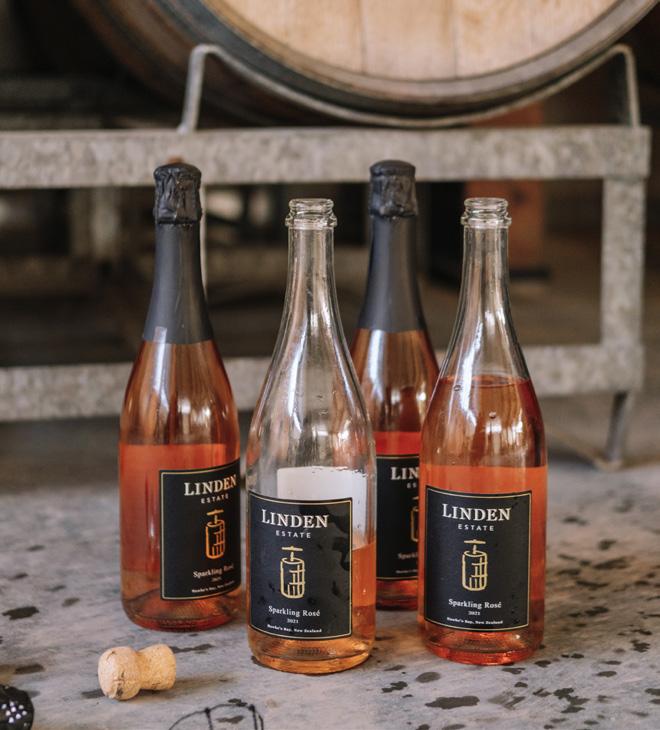
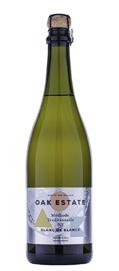


The gorgeous rose-gold colour of this wine makes me want to find a jeweller-slash-mad-scientist to alchemise it into a bangle or possibly some sort of flash fob chain. Crafted by winemaker Alex Hendry (who managed to get it into the bottle before Cyclone Gabrielle ripped through their Esk Valley vineyards), it boasts notes of lifted berry brioche, Shrewsbury biscuit, and soft sea breeze on the nose and rich, clean peach and almond flavours on the palate. It’s quite seductive, so get yourself some smoked salmon pâté and a chunk of fresh sourdough, and you’ll be set. lindenestatewinery.co.nz
Oak Estate Bridge
Pa Blanc de Blancs
Méthode Traditionelle
NV $45
Located on Ngatarawa Road just before the SH50 intersection and below Roy’s Hill is Oak Estate. Owned by Nadine and Stefan Loetscher, it’s a small vineyard with 3.5 ha planted in Chardonnay, a decent chunk of which goes into this very wine. Aged for 24 months on its lees, if you’re a fan of fizz scented with shortbread, rising dough, bright lemony layers and smooth, creamy, cashew characters, then this will be your jam. Creamy, nutty notes wrap around a snappy, vibrant core, making it a very satisfying thing to sip. Elegant, beautifully structured and showing sexy complexity and depth. oakestatewines.co.nz

Lost and Found Ad
Astra Hawke’s Bay Méthode Traditionnelle NV $29
Ad Astra is Latin for ‘to the stars’, and once you’ve torn your gaze away from how stellar this bottle
looks, I’ll ask you to contemplate how gloriously golden in the glass it is, too. Unlike the subtle southern styles, this Hawke’s Bay hero of 44% pinot and 56% chardonnay has huge punch and palate weight, as well as boatloads of citrus and a crunchy-crisp acid spine that adds power to the mouthfeel and finish. Stylish, generous, and a huge new personality in the local sparkling scene. Serve with Parmesan wafers. lostandfoundwine.co.nz
Mills Reef Elspeth
Hawke’s Bay Methode Traditionnelle NV $40
Wow. Golden in the glass and heaving with divine scorched brioche, toasted almond, and grilled citrus, this heavenly Hawke’s Bay bubbles boasts all the hallmarks of thoroughbred Champagne at a fraction (and I mean fraction) of the price. Generously proportioned and stacked with baked apple and rising dough notes, it also boasts soothing caramelised characters and tantalising nutty textures. It feels impressive. Just like the one time in my life that I actually finished a chapstick. Enjoy with grilled crayfish. wineportfolio.co.nz
88 BAYBUZZ September + October 2023



floormart.co.nz
0800 78 98 70
1000 Omahu Road, Hastings STYLISH, QUALITY FLOORING THAT DOESN’T COST THE EARTH
At Floormart Hastings creating your dream flooring has never been easier. Our flooring experts and qualified installers have got you covered.
Spring?
Distrust of the seasons is mounting ... understandably. Those closest to the land have been bowled nothing but curve balls and bouncers and hospital passes for more than a year. Well and truly slammed and dunked, their impressive resilience is tested as seldom before. We are in their debt. No farmers, no food.
So here we go, bravely into a new round of our climatic wheel of fortune game and associated uncertainty. Spring kicks us off teasingly, foreshadowing warmer times one day and plunging us back into the teeth of a wintery southerly the next.
Whether you believe spring begins on the 1st or the 21st of September you are largely wrong but slightly right. There is no firm date, no starter’s pistol, no universal “Ready-steady-grow!”.

There’s certainly enough stretch in the day and occasional warmth of the sun to engender optimism from mid-August onwards. Spring appears in stages, for the leaves of a walnut tree have never seen an early cherry in blossom. (That’s a personal observation, rather than an old Welsh proverb or metaphor to help you through life.)
Some daffodils flower in winter. They are not ‘confused’. It’s not a ‘sign of spring’. Surprise at the confused flowering is confusion itself; a sign that we are unaware of winter blooming daffodils. Gaps in our knowledge of the natural world grow as we distance ourselves ever further from the subject. The nomenclature of foods often steers our seasonal misconceptions. ‘Spring lambs’ are commonly born in winter so as to be rumen-ready in time to eat the
spring and early-summer grass growth and, in turn, be eaten themselves in spring.
Human instincts for control and understanding of all things shouldn’t lead us to prescribe four seasons of three months each with strict start and end dates. Given the first blossoms appear in August and summer doesn’t start until late December or January we have a four-to-five month spring season. The length varying from year to year.
So what are we eating?
What’s ready now was planted months ago. If plantings are interrupted then September and October are usually when fresh produce is scarce. Late frost, rain during flowering, and hail can destroy crops. Hydroponics, hot houses, and imports fill gaps, but at a price. A price not only to the consumer, but also in lost sales to the local growers. Delight in the joy of the first bite of the season of some Hawke’s Bay goodness.
Here is a short list of my favourite spring produce and simple tips. So forget pineapples, bananas, mangoes et al. Savour the season of our own fruit bowl. Spend with our local growers. They need our support.
Apricots: Tree-ripened, savour them fresh.
Strawberries: have a long season so I like to wait until late spring for the juicy ripe ones. Use the end of a teaspoon to dig out the stalk.
Asparagus: Love em! Take a good look at the spears. Ideally the heads will be tight and not seedy, not too thin, not too thick. The most tender asparagus grows in a warm period shooting up quickly, but let’s appreciate recent weather conditions. They’ll be bent
and possibly sand blasted by strong wind (a good wash is needed). A dry year will yield thinner spears. Late season spears may show signs of going to seed. They’re all delicious but some are more delicious than others.
Globe Artichokes: The flower buds of a thistle. Simply boiled, petals plucked and dipped into a garlic mayonnaise or butter. Your fingers are going to get messy but it’s worth it.
Peas: The first of the legumes of the year, sweet and delicious often, unjustly given the part of non-speaking extra of the dinner scene.
Beans: Yes! Fry fresh green beans and garlic in olive oil. Add fresh or tinned tomatoes. Season. Add herbs. Eat with crusty bread or use as a side dish.
Tomatoes: Not yet. The best come with the summer sun.
New potatoes (or new season potatoes): They’ll be sent from field to consumer without being stored. No need to peel them. Into cold water with salt and bring to the boil. Add butter. Carrots…baby please! Half cover with water and simmer until still crunchy but not raw then bombard with butter, salt and pepper.
Kohlrabi: Who? What? Little known to those outside upper mainland Europe, this is brassica royalty aka German turnip. Delicious in a crunchy, apple-like way. Grate it raw into salads.
Broad beans: An old favourite that’s become popular again. Sage and butter after boiling.
Ian Thomas is a caterer and formerly free range egg farmer, cooking demonstrator, and manager of a commercial food production business. He specialises in cooking paella. paellaagogo.com
90 BAYBUZZ September + October 2023
Life Food / Ian Thomas
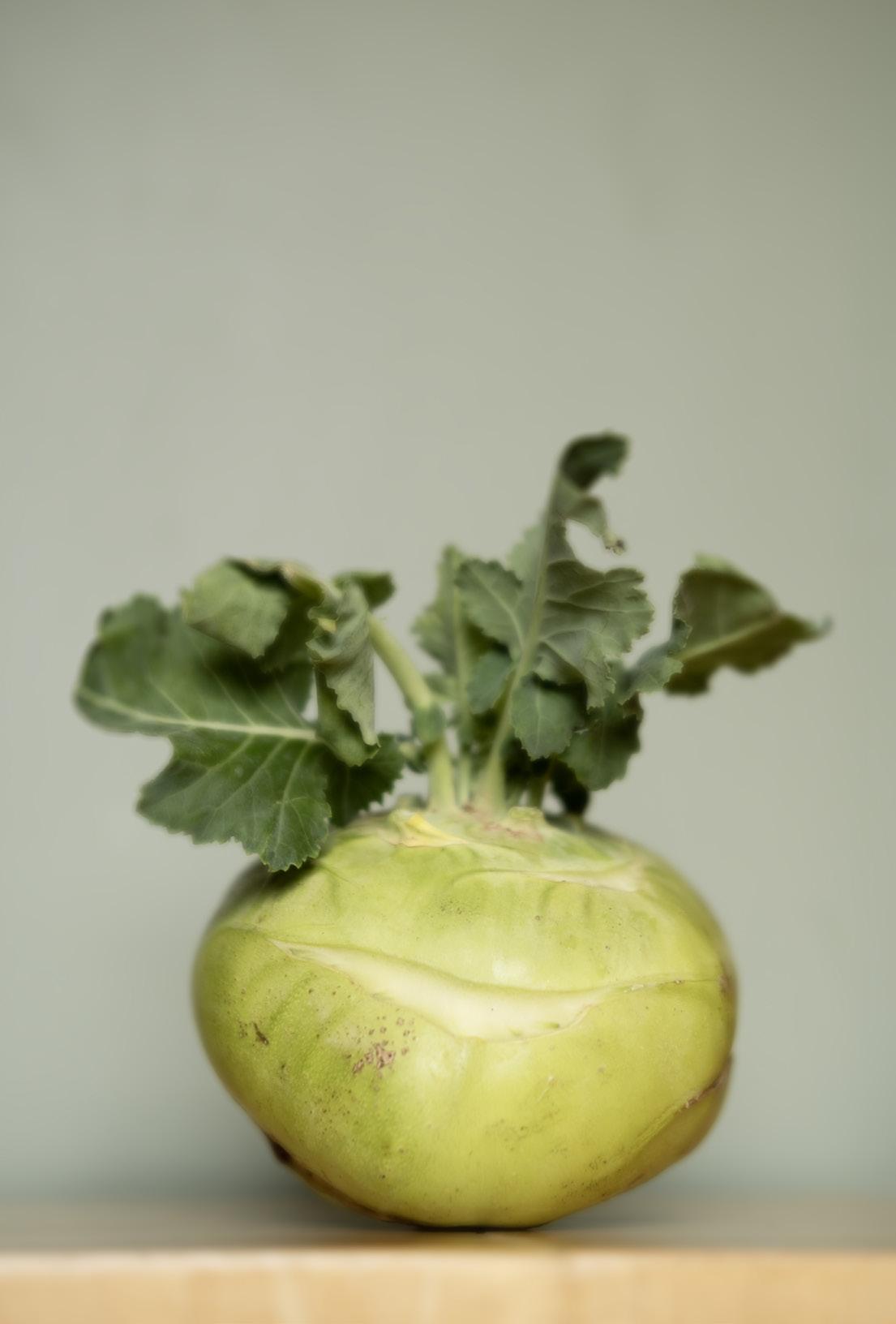 Kohlrabi. Photo by Florence Charvin
Kohlrabi. Photo by Florence Charvin
Nestled in the heart of New Zealand's stunning Hawke’s Bay region, Havelock North proudly showcases an array of restaurants, cafes, bars, and eateries, each with its own unique character, making it a true haven for food enthusiasts. Whether you crave authentic international cuisine, delectable New Zealand delicacies, or tantalising fusion dishes, Havelock North has something to please every palate.
Beyond the flavours, dining in Havelock North is an experience of ambiance and atmosphere. The Village exudes a warm and inviting vibe, where locals and tourists mingle, creating a sense of community that complements the culinary journey. Whether you choose to dine indoors or relish the fresh air in a vineyard setting, each eatery brings its own distinct personality to the table.

@LOVEHAVELOCKNORTHNZ
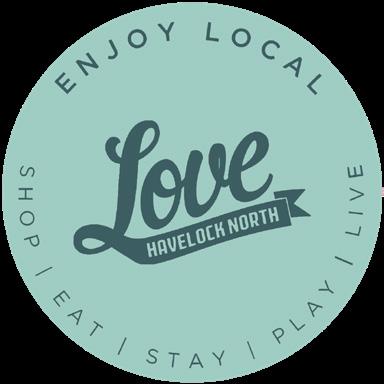 MALO RESTAURANT, TE AUTE ROAD
MALO RESTAURANT, TE AUTE ROAD
The aroma of freshly roasted coffee beans and the allure of freshly baked pastries create an inviting atmosphere that entice you to step in and start your day the right way. Whether you're seeking a quick morning pick-me-up or a leisurely brunch experience, the cafes in Havelock North promise an exquisite blend of flavours and warm hospitality that leaves you with a lasting impression.
With its warm hospitality and picturesque surroundings, dining out in Havelock North village is a memorable experience, inviting to both locals and visitors year-round, who wish to indulge in the delectable offerings of this gastronomic gem. There’s a strong emphasis on fresh, locally sourced ingredients, many of the eatery menus change with the seasons highlighting Hawke’s Bay’s quality produce.
So, embrace the culinary delights as we head into Spring and immerse yourself in the heart of food and wine country celebrating our local talent while tantalising your taste buds. As you explore the Village streets, you'll discover a vibrant food culture that reflects the passion and dedication of our talented chefs and local producers. Indulge in farm-to-table delights, sip on world-class wines, and relish the warm hospitality that makes dining in Havelock North an experience like no other.
Whether you're a seasoned food enthusiast or a curious eater, the Village food scene promises to delight your senses and create unforgettable dining moments.

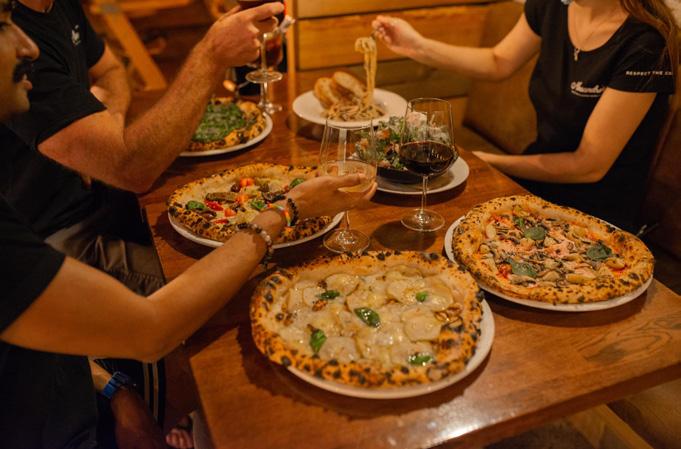
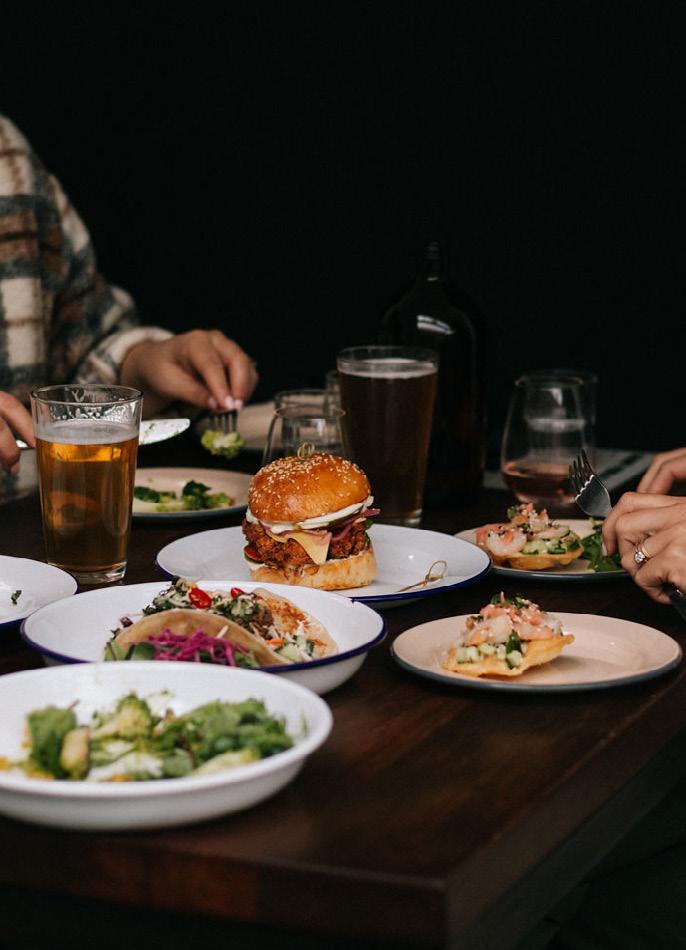
Head to HavelockNorth.co.nz for a full list of cafes, eateries, bars and so much more to discover.
 ALESSANDRO’S, JOLL ROAD
DELICIOSA, NAPIER ROAD
GIANT PUBLIC HOUSE, TREACHERS LANE
ALESSANDRO’S, JOLL ROAD
DELICIOSA, NAPIER ROAD
GIANT PUBLIC HOUSE, TREACHERS LANE
ADVERTORIAL
BROTHER CAFE, TE MATA ROAD
Havelock North Village is the vibrant heart of Hawke’s Bay. Sip great coffee at the local cafes, discover stunning natural attractions, eat and drink your way around the Village eateries, or wander around stunning boutique retailers and artisan providores; there is something for everyone to love about Havelock North!



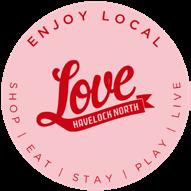



Havelock North store: 3/4 Joll Road (06) 877 5327 Waipukurau store: 97 Ruataniwha Street (06)
8675 diahannboutique.co.nz
858
94 BAYBUZZ September + October 2023 HAVELOCK NORTH
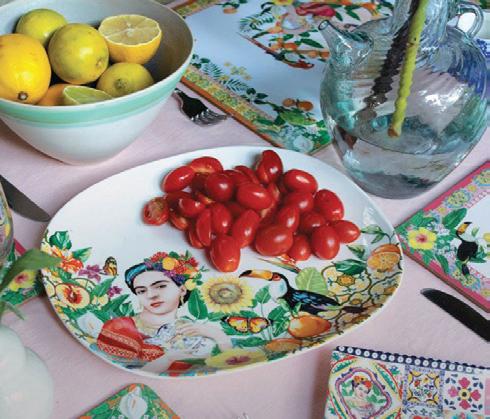

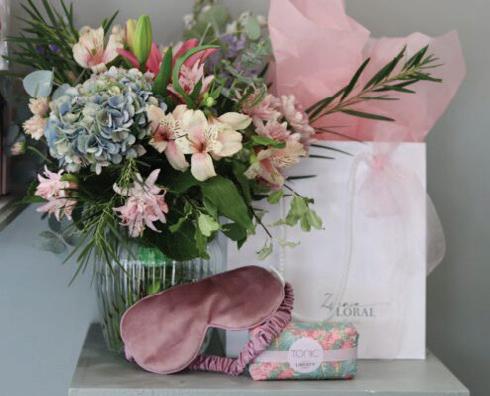

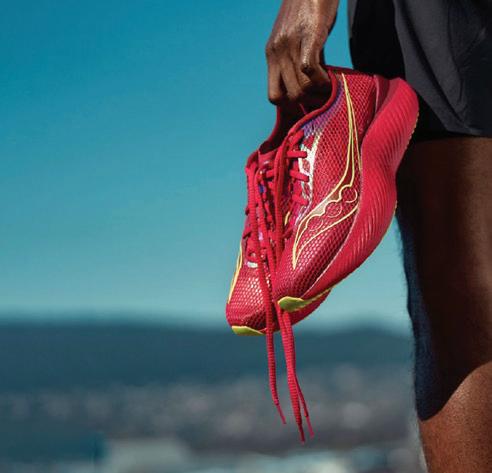


 ADAMO • 8 Joll Road • 06 877 9777 • adamo.co.nz
Shop 8, Village Court 06 877 6465 • zinnia.co.nz
Shop 10, Village Court, 10 Napier Road 06 650 5777 • email havelock@shoescience.co.nz
ADAMO • 8 Joll Road • 06 877 9777 • adamo.co.nz
Shop 8, Village Court 06 877 6465 • zinnia.co.nz
Shop 10, Village Court, 10 Napier Road 06 650 5777 • email havelock@shoescience.co.nz
September + October 2023 BAYBUZZ 95 HAVELOCK NORTH
GARDENALIA • 2 8 Havelock Road • gardenalia.co.nz
Life Mouthy Broad / Jess Soutar Barron

Clean machine
Lambs gambolling, daffodils blooming, must be time to throw open the windows, hang quilts on the line, pull out the polish and get down and dirty with the Spring cleaning. Even the oven gets a look in as we asphyxiate ourselves on Mr Muscle.
The easiest way to get through cleaning is to pay someone else to do it. Although then you have the weekly “cleaner’s coming!” panic-tidy so the housekeeper doesn’t judge you for being bad at keeping house!
The hardest way is to procrastinate and let it pile up in your head, a mountain of mental mess getting more maggoty and mouldy, and overwhelming with every moment you put it off.
My interest in cleaning is purely academic. I am an astrophysicist who has never blown up a planet. I don’t like ‘the doing’ very much but, I do love the results, so I aim for an annual blitz and a twice-monthly flick around the edges. When I get sick of the sight of dust bunnies and cobwebs I simply take off my glasses.
So, here’s the deal, you do the cleaning. I’ll sit back and give you directions, tips, and the occasional: “You’ve missed a bit!”. My research says we need a plan of attack, Lizzo on the stereo, and a treat when it’s done.
The first thing to ascertain is existential: What are we doing here? Are we cleaning or just tidying? They are two different things with two different outcomes requiring two different attitudes.
Tidying makes us feel pretty great in the short term. It’s what we do if people are coming for dinner.
Cleaning makes us feel great for a lot longer. Our muscles ache. Things smell good. I’ve read it’s beneficial for mental wellness. Cleaning is what we do when we want to spend the following day on the couch watching Netflix and feeling smug.
With tidying, every housemate can get involved. Divvy up the rooms. Allocate everyone a zone. Delegate yourself out of a job. Play inspector. Hand out awards.
With cleaning, anyone not actively involved needs to be elsewhere. There’s nothing worse than vacuuming around people or ajaxing the loo only to be told someone “needs to go”. You’re either in the clean team or you’re out (and not just outside but off the property altogether). If you’re in, you’re really IN. You’re mono-tasking and hyper-focused. No doom-scrolling, no cups of tea, no flitting from one half-arsed task to another. You are committing 100% to cleaning. You are a sanitation ninja, Harvey Keitel in The Assassin, Beatrix Potter’s Mrs Tittlemouse.
Whether you’re a rags-from-oldshirts gal or a fan of the Scrub Daddy, the trick is to follow a system, lock eyes with the enemy, attack grit and grime with military precision. You are a stealth-bomber (with a bumper sticker that reads My Favourite Colour is Clean slapped on your flank).
First, machines are your friends. That includes the coffee machine. Get them going early. Stack the dishwasher, fill the washing machine, pull out the vacuum, down your first espresso.
Next, make the beds. Do it fast before the caffeine wears off, with lots of upper-body extension, and standing hamstring stretches as you force that duvet into its cover and tuck in those hospital corners.
Then, dust from the top down, because dust floats but eventually falls. Don’t prance around like Disney’s Snow White, be methodical and thorough. Now, wipe down surfaces. Lastly, floors. Vacuum right through then go back through with a mop. Boiling hot water and a slug of dishwashing liquid is all you need. There’re a million-and-one solutions for every cleaning task. Gin is my favourite.
When it comes to potions, people are split down the middle. Half douse their house with as much sodium
hypochlorite, hydrogen peroxide, oxalic acid, alkylbenzene sulfonate and ethanol as they can find. The others stick strictly to vinegar and baking soda. You do you. But, personally, if your fingers aren’t raw and burning by the end of the sesh then I know you haven’t done it right.
My own concoction collection contains the classics: CO Original Polishing Oil (est.1923), Bar Keeper’s Friend (1882) and the pink stuff, Chemico Paste (1931). I don’t know if any of them work but they look retro-cool in my charlady’s caddie!
The very best way to minimise the need to clean is to think about cleaning before you buy.
Houses with steps? Never. That place Ian Athfield did for Wendy Buck on Te Mata, with all those tricky corners? Nightmare. Even in your decorating choices, think about the cleaning. Considering a shag runner? Confident you can vacuum it without losing tufts up the shaft? Go for it! Decking out the whole house in venetians? Sure you can manage dusting 240 slats a week? Knock yourself out! I once got so sick of vacuuming under the lounge suite that I took the legs off every piece of furniture. Now that’s a cleaning solution!
Spring cleaning is a marathon (we haven’t even started on the pantry huck-out, the fridge defrag, the windows (inside and out), the ceilings, the architraves, the skirting boards, we haven’t even touched the bathroom and there’s a whole bottle of Shower Witch to get through). It’s endless, it’s not going anywhere, and it’ll still be there when you get back from whatever fun thing you’d rather be doing.
But if you must clean, roll up your sleeves and get stuck in. I’m in your corner, sipping a gin and cheering you on!
Sponsored by Little Red Robot
If your fingers aren’t raw and burning by the end of the sesh then I know you haven’t done it right.
96 BAYBUZZ September + October 2023
Missing
Summer?
Now is the perfect time to prepare your pool and outdoor space for when the warm weather returns.
As they are rectified (even in size), porcelain tiles are easy to install. They don’t need to be sealed yearly like natural stone and terracotta. Modern tile manufacturers utilise sophisticated printing techniques which replicate natural surfaces realistically, offering almost limitless design options with advanced anti-slip technology.

Ask us about In Out Tiles – the latest in anti-slip technology suitable for both interior and exterior applications.
Tile Shed owner June discusses why tiles are a preferred choice around the world for pools and outdoor spaces.

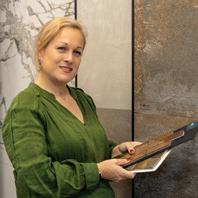

33 Oruanui St Taupō 3377 07 242 8004 taupo@tileshed.co.nz www.tileshed.co.nz 201 Eastbourne St West Hastings 4122 06 871 0587 sales@tileshed.co.nz
300x600mm Dropdown Coping
Pictured: Endura Sierra Avorio
20mm
Pictured: Bisazza VTC Blend Delhi Hotmelt Mosaic
F- PACE SVR
TH E JAGUAR F-PACE SVR

Our ultimate performance SUV, delivering greater performance, agility and dynamism than ever before
Book a test drive today
Bayswater European 93-107 Carlyle Street, Napier 06 650 0799
jaguar.co.nz
























 Photo: Florence Charvin
Photo: Florence Charvin














 The promotion and preparation of the Hawke’s Bay Arts Festival. See Michal McKay’s article on the highlights on page 70. Check out hbaf.co.nz for all the details and to book tickets to events.
Asparagus showing up on menus and tables!
The promotion and preparation of the Hawke’s Bay Arts Festival. See Michal McKay’s article on the highlights on page 70. Check out hbaf.co.nz for all the details and to book tickets to events.
Asparagus showing up on menus and tables!















 Story by Abby Beswick Photos Florence Charvin
Story by Abby Beswick Photos Florence Charvin

 LEFT: Catherine Wedd visiting Balkaran Singh, whose family own the Cornwall Park Store which was recently attacked. Photo supplied. BELOW: Anna Lorck has been a long-time advocate of more community police presence to improve public safety in neighbourhoods and retail areas.
LEFT: Catherine Wedd visiting Balkaran Singh, whose family own the Cornwall Park Store which was recently attacked. Photo supplied. BELOW: Anna Lorck has been a long-time advocate of more community police presence to improve public safety in neighbourhoods and retail areas.






 Story by Tom Belford
Story by Tom Belford














 Pan Pac Boiler burning biomass.
Photo: Simon Cartwright
Pan Pac Boiler burning biomass.
Photo: Simon Cartwright






















































 Paul Paynter is our resident iconoclast and cider maker. Weather permitting, he grows stuff at Yummyfruit.
Paul Paynter is our resident iconoclast and cider maker. Weather permitting, he grows stuff at Yummyfruit.







 F.W. LILEY
ASIAN SATAY NOODLE HOUSE
F.W. LILEY
ASIAN SATAY NOODLE HOUSE









 CLOCKWISE FROM TOP LEFT: Kahurangi! Ahakoa He Iti, He Ponamu!; UPU; Ha-Wai-Ki-Nui; Ko Au: Malosi.
CLOCKWISE FROM TOP LEFT: Kahurangi! Ahakoa He Iti, He Ponamu!; UPU; Ha-Wai-Ki-Nui; Ko Au: Malosi.












 Story by Rosheen FitzGerald
Photos by Florence Charvin
Story by Rosheen FitzGerald
Photos by Florence Charvin












 Beatrix from Alpha Domus with Alpha Domus Cumulus Blanc De Blanc Méthode.
Photos: Florence Charvin
Life Wine / Yvonne Lorkin
Beatrix from Alpha Domus with Alpha Domus Cumulus Blanc De Blanc Méthode.
Photos: Florence Charvin
Life Wine / Yvonne Lorkin

















 Kohlrabi. Photo by Florence Charvin
Kohlrabi. Photo by Florence Charvin

 MALO RESTAURANT, TE AUTE ROAD
MALO RESTAURANT, TE AUTE ROAD



 ALESSANDRO’S, JOLL ROAD
DELICIOSA, NAPIER ROAD
GIANT PUBLIC HOUSE, TREACHERS LANE
ALESSANDRO’S, JOLL ROAD
DELICIOSA, NAPIER ROAD
GIANT PUBLIC HOUSE, TREACHERS LANE














 ADAMO • 8 Joll Road • 06 877 9777 • adamo.co.nz
Shop 8, Village Court 06 877 6465 • zinnia.co.nz
Shop 10, Village Court, 10 Napier Road 06 650 5777 • email havelock@shoescience.co.nz
ADAMO • 8 Joll Road • 06 877 9777 • adamo.co.nz
Shop 8, Village Court 06 877 6465 • zinnia.co.nz
Shop 10, Village Court, 10 Napier Road 06 650 5777 • email havelock@shoescience.co.nz






